-
Posts
2,102 -
Joined
-
Last visited
-
Days Won
2
Content Type
Profiles
Forums
Blogs
Gallery
Events
Store
Posts posted by Rusty Greaves
-
-
Owain, many thanks for your continued interest and help in advancing my understanding about the Order of Ismail and the other limited excursion I am making into this period of Egyptian phaleristics. Your additional information and point about the mix of Monarchy and Republic era miniatures in the Rauch photograph is quite interesting. The Republic Order of the Nile is a 2nd Class of that Order (galon with gold on R and silver on L) while the Order of Ismail mini appears to be the 4th Class (rosette with no galon). Unfortunately, very few images of miniatures Order of Ismail I have run across show any galon to demonstrate common use on the minis. Would those differences in Class help explain the order of the the two Egyptian minis on this French bar?
I'm afraid my silence has been due to submersion in more pedantic tarpits of investigation of my vast ignorance, I hope this screed on hallmarks is of some interest to folks here.
I have been looking into Egyptian hallmarks in relation to my interests in the Order of Ismail. I would like to share some of what I have found out about gold and silver hallmarks, especially those identify the purity of metals employed and the dates of manufacture. A complete set of Egyptian hallmarks for gold or silver include 3 punch marks: the left most is the fineness assay that identifies the purity of the precise metal as tested by an assay office. This mark also includes which office certifies that purity. The middle hallmark identifies Egypt as the location where the piece was made. For silver, a cat was used from 1916 until 1946. After 1946 a lotus image was used for the identification of Egyptian silver. The origin mark for gold is a bird, usually identified as an ibis, but also possibly an egret or stork, and often a number of other silly names on website listings (i.e., "seagull"!?). For a brief period, ~February of 1951 until an unspecified date after King Farouk's banishment on 26 July, 1956, King Farouk I's cipher was used for gold, and then the ibis image was re-instituted. The third, right-most, hallmark identifies the date of manufacture (or when the piece was hallmarked). Roman letters were used to indicate dates from 1916 until 1940. From 1940 until the present, Arabic letters have been used to identify the manufacturing dates. The chart I posted in the 3rd image on 12 September, 2018 in this thread is the most commonly available date listing (covering only 1916-1982). There are some discrepancies in published dating charts (i.e. in George C. Miles 1957. A note on Egyptian gold and silver assay marks. Museum Notes (American Numismatic Society) vol 7; pp. 251-253, identifies dates slightly different from the table in my 12 September post. However, other published date tables generally agree with the one here [i.e., in Azza Fahmy, 2007. Enchanted Jewelery of Egypt: The Traditional art and Craft. American University of Cairo Press, Cairo: pg 199]. Although Miles states that he got the information for his 1957 article from the director of the Administration of Stamps and Weights in Cairo [ibid. pg. 251], his article contains another error I can identify: he incorrectly identifies the cat silver hallmark as post-1946 and the lotus and the pre-1946 country mark for silver [ibid. pg 253]. One source I have not been able to check through interlibrary loan is the recent, expensive, but hopefully comprehensive and well-researched treatment of Egyptian hallmarks: Danusia V. Niklewicz, Lindy L. Matula, & William B. Whetstone [eds.], 2017. World Hallmarks Vol II: Asia, Middle East, Africa, With Additional Comments on Non-Hallmarking Regions [Gold, Silver, Platinum, Palladium Hallmarks]. The Hallmark Research Institute). I have posted one additional date chart here that I have come across on the internet that extends the listings of Arabic date marks to 2009. There are some difference between this one and the previously posted table. However, only one discrepancy between these charts is mentioned below: for a Lattes manufactured 1st Class Grand Cordon example marked “F” (and for some possible later Arabic letter date hallmarks where they cannot be read with certainty and there are some contrasts between these 2 charts identification of this dates). Generally, most reporting on auction sites appear to use dating information congruent with the chart I posted on 12 September, 2018. As the Order of Ismail's breast star is constructed from a silver embellishment surmounted by a gold and enameled star, both sets of marks can provide useful information. While I hope this information is of interest in relation to other Egyptian awards from comparable periods, this post is specifically about the hallmarks on the Order of Ismail, as placement and other variation seen here appears to be different on other awards.
From: http://i.ebayimg.com/00/s/MTQxMFgxMjIy/z/L8QAAOSwpDdU5M70/$_3.JPG?set_id=2
I wish to first illustrate some of the marks encountered on the Order of Ismail (and of course other Egyptian medals) and to illustrate the positions and some variations I have seen on photographs of these hallmarks. Below is the most comprehensive chart listing I have been able to find of these hallmarks, especially for assay offices other than Cairo (which are the most commonly illustrated on the internet). The assay office marks are the same for gold and silver. The superior Arabic marking (on 3-10 for gold and 14-16 for silver) is the assay office location and the lower Arabic mark is the metal purity. This comes from the Miles 1957 article, and I do not have comparable data that can be used to check his identifications, although I have checked this with other information as best I can.
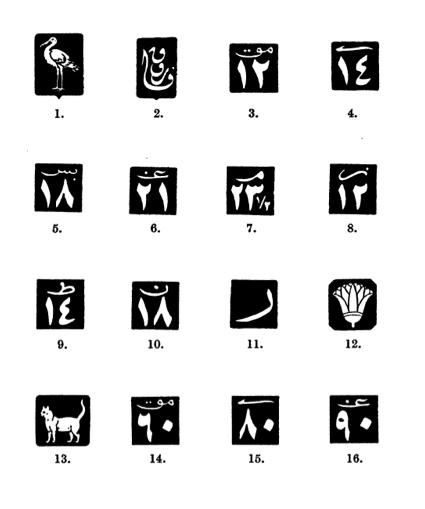
1=the country gold mark for Egypt (ibis); 2=King Farouk I's cipher used as the Egyptian gold mark from 1951-~1956; 3=the Cairo office's mark for 12 karat gold; 4=the Alexandria office's mark for 14 karat gold; 5=the Beni Suef office's mark for 18 karat gold; 6=the Tanta office's mark for 21 karat gold; 7=the El Mansoura office's mark for 23 1/2 karat gold; 8=the Zagazig office's mark for 12 karat gold; 9=the Asyut office's mark for 14 karat gold; 10=the Qena office's mark for 18 karat gold; 11=an example of the use of Arabic letters to indicate manufacturing dates from 1941 to the present (this example is probably for 1951-53); 12=the country mark for Egyptian silver after 1946 (lotus flower); 13=the country mark for Egyptian silver from 1916-1946; 14=the Cairo office's mark for 600 silver (60%); 15=the Alexandria office's mark for 800 silver (80%); 16=the Tanta office's mark for 900 silver (90%). From: George C. Miles 1957. A note on Egyptian gold and silver assay marks. Museum Notes(American Numismatic Society) vol 7; pp. 252-253. Below I illustrate a few additional examples of drawn hallmark designs and actual silver hallmarks since their execution and subsequent wear does show variation across pieces.
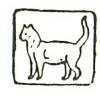

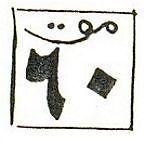
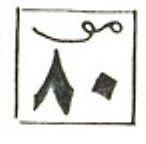
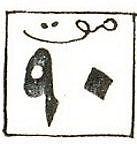
Above from L to R are additional illustrations of the origin and fitness hallmarks for Egyptian silver: 1916-1946 country and precious metal mark for Egyptian silver (cat); the lotus flower country and precious metal mark for Egyptian silver after 1946; the next 3 images illustrate the fineness marks from the Cairo assay office for (from L to R) 600 silver; 800 silver (missing some detail in the Cairo office designation); and 900 silver. (all from: http://www.chineseargent.com/home/egyptian-silver-hallmark)
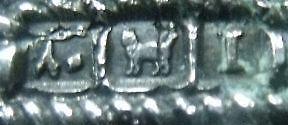
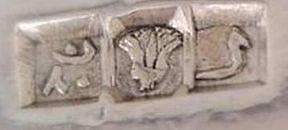
Two examples of the complete 3 hallmark sets: L=indicating (from left to right) 800 silver mark assayed by the Cairo office; the pre-1946 cat mark for Egyptian silver, and the Roman date letter "I" for 1933-1934; R=another example of the 3 hallmarks identifying 900 silver assayed by the Qena office, post-1946 Egyptian silver manufacture, and the Arabic date letter (for 1978?) (all from: http://www.chineseargent.com/home/egyptian-silver-hallmark)
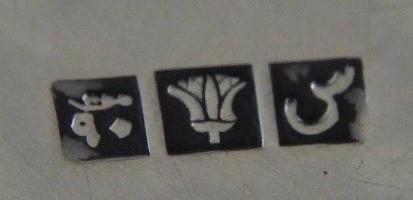

Two additional sets of complete silver hallmarks. R=900 silver assayed by the Cairo office, Egyptian silver made post-1946, and the Arabic date letter indicating manufacture from 1959-1961; 900 silver from the Cairo office, Egyptian silver made post-1946, and the Arabic date letter indicating manufacture. There are some allegedly genuine 900 silver fineness marks that show 2 dots to the right of the "9" indicating "900" rather than "90"(%). (from: http://www.chineseargent.com/home/egyptian-silver-hallmark)

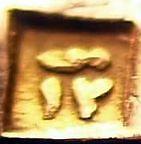
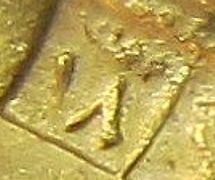
Gold hallmarks from L to R: a stylized image of the ibis mark identifying Egyptian gold; fineness mark identifying 14 karat gold from the Cairo assay office; 18 karat gold from the Cario assay office. Note that the clarity of the assay office mark for both gold and silver is especially highly variable due to differences in the execution of the punch as well as subsequent wear. (from:http://www.chineseargent.com/home/egyptian-silver-hallmark)
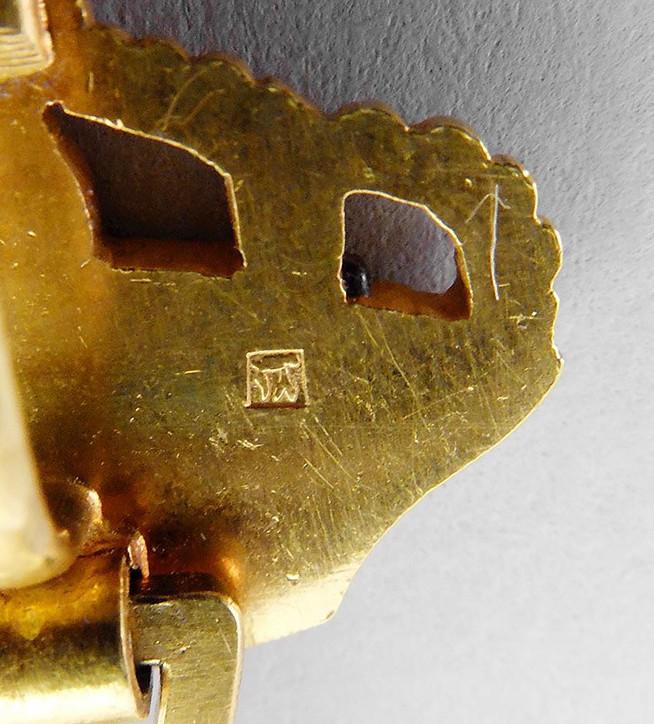
The above first example I illustrate of hallmarks on the Order of Ismail is the same 3rd Class Commander’s neck badge made by J. Lattes from a January 2018 auction by eMedals that I illustrated in the final photograph of my post on 13 December, 2018 in this thread. The auction description identifies this neck badge as dating to c1925 and measuring 60.3 mm wide x 82.5 mm high (including the “suspension and loop”). The description correctly identified the mark as 18 k gold, and describing the “stork” hallmark identifying Egypt, and the “A” mark as dating it to 1925-26. This example is in the case of issue. The hallmark shown above is on the reverse right side of the crown suspension device, indicating 18 k gold from from the Cairo assay office. A blurry view of this same mark can be seen on my final illustration of the 13 December 2018 post. Only a few photographs of this mark are present on auction listings, so it is unclear how common it is and whether it always is present as a single fineness mark. (from: https://www.emedals.com/egypt-kingdom-an-order-of-ismail-in-gold-1st-class-commander-by-j-lattes-c-1925)

Obverse of the same Commander’s neck badge showing the placement of the three hallmarks on the right side of the suspension device arm connecting the superior ray of the star with the crown suspension device. Several photos of this detail show the same placement of the full set of three hallmarks, at least for the 3rdClass Commander’s neck badge and the 2nd Class Grand Officer‘s neck badge made by J. Lattes of Cairo. There are not enough detailed images of the sash badge of the 1st Class Grand Cordon on auction sites to determine whether the same hallmarks are present on that device. At least one example of a neck badge of a Grand Cordon class made by Tewfik Bichay shows a similar placement of at least 1 hallmark (shown below). However, only a single hallmark is partly visible in that image, and it cannot be determined which hallmark it may be as it is blocked by the inferior portion of the crown suspension device (although see the note about the hallmark from the auction description in my text below). (from: https://www.emedals.com/egypt-kingdom-an-order-of-ismail-in-gold-1st-class-commander-by-j-lattes-c-1925)
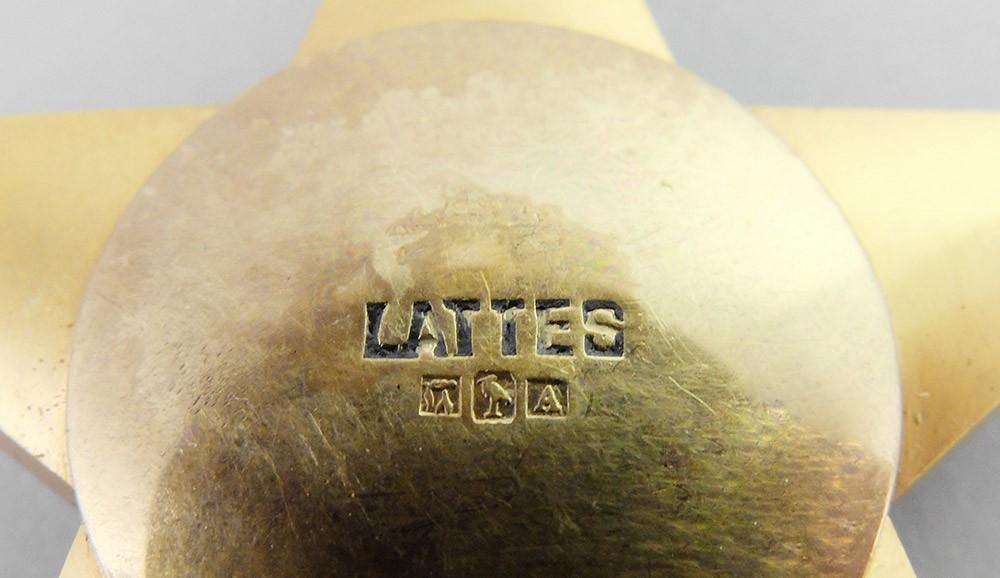
Hallmarks on the reverse central boss of the same Commander’s neck badge showing the normal location of the set of 3 hallmarks centered below the “LATTES” manufacturer’s hallmark. Exampes made by Tewfik Bichay have different placement of the hallmarks (shown below). (from: https://www.emedals.com/egypt-kingdom-an-order-of-ismail-in-gold-1st-class-commander-by-j-lattes-c-1925)
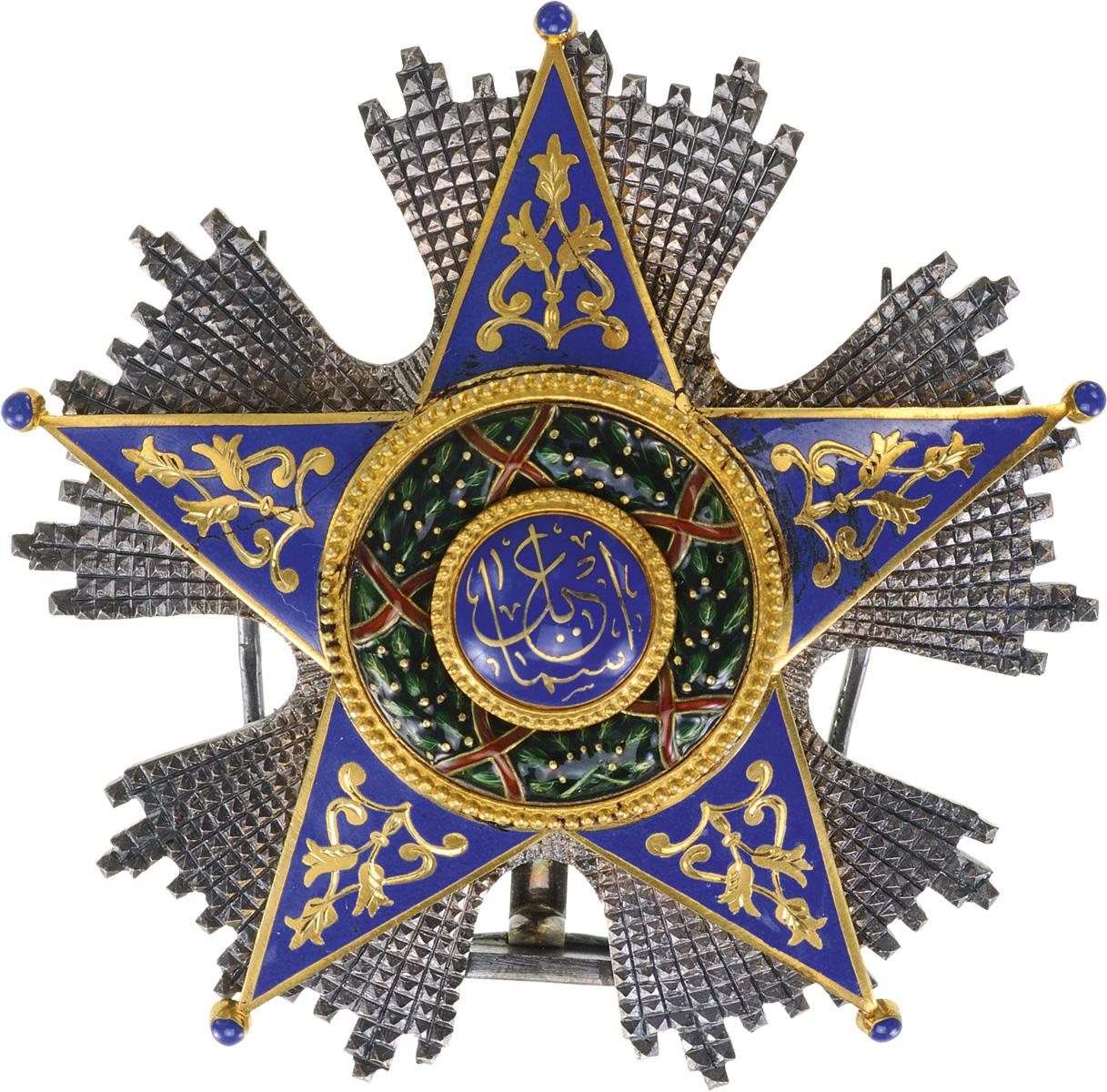
Incorrectly 'repaired" example of a named 2nd Class Grand Officer breast star. This is from the same named award set to the Italian Physician Dr. Giovanni Quirico, physician to King Fuad I, that I illustrated in its case (Arabic #2 on lid=2ndclass) on 14 November, 2017 (4th photo in that post). I noted the incorrect rotation of the gold star in relation to the silver-faceted-rayed embellishment star below it. This higher resolution image of the same breast star has been rotated so that the gold star is in approximately its correct orientation. While the incorrect re-assembly of this named Grand Officer breast star is quite unfortunate, I am providing this illustration in relation to available close-ups of the hallmarks on the pin on the reverse, and this obverse view shows some aspects of the construction design not visible on intact examples of this star. I illustrated the envelope for the brevet in the 5th photo of that same post of 14 November 2017, and the brevet (395x253 mm), written in Arabic in the 6th photo. Neck star=85x62 mm; breast star=70 mm. (From: https://www.coins-la-galerie-numismatique.com/auction-33-day-1/order-ismail)
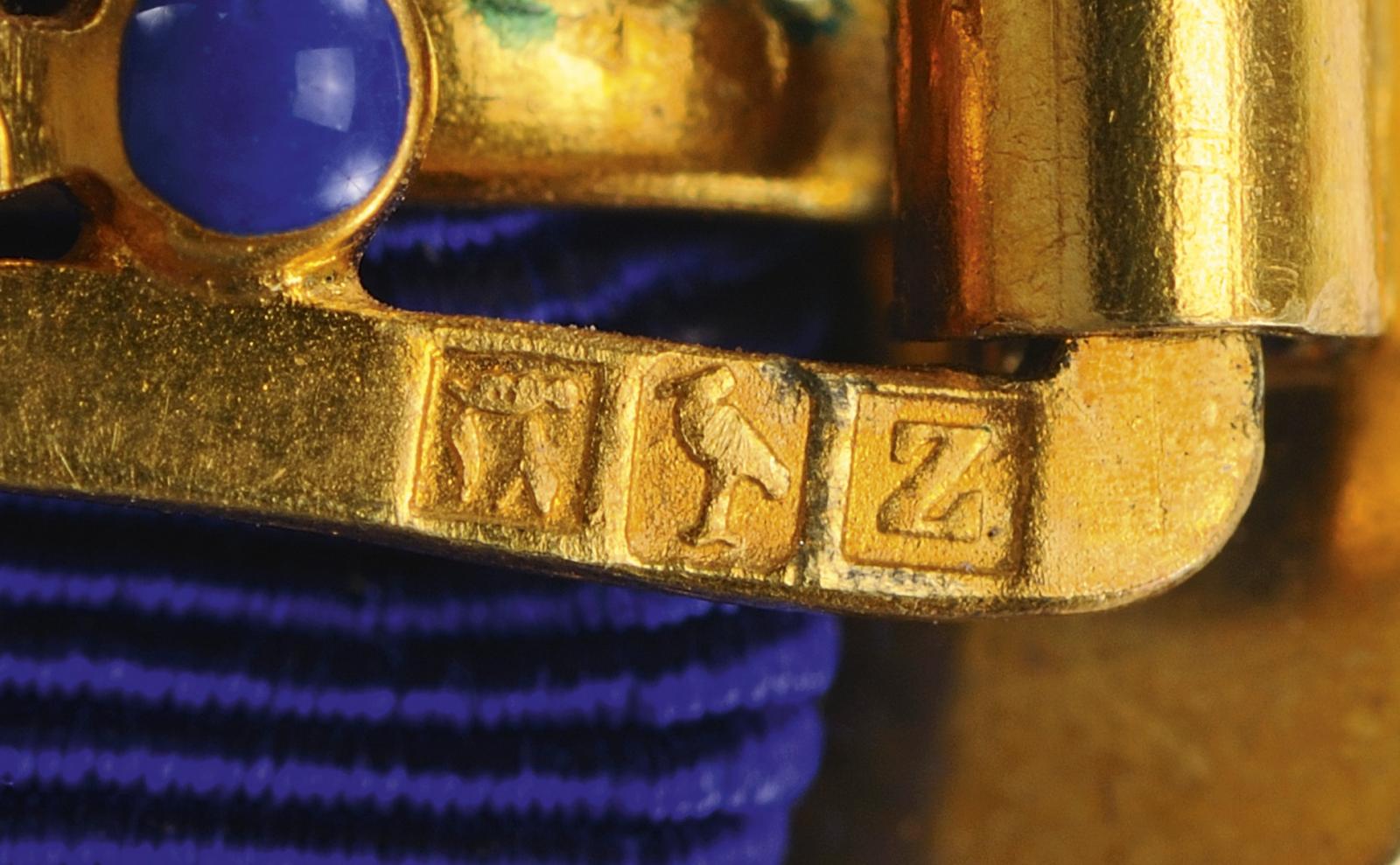
Gold hallmarks on the obverse face of Dr. Quirico’s Grand Officer Class neck badge showing the right side of the suspension device. This is the same position as shown in the 2nd photo above of the Commander’s neck badge from 1925-1926 from the eMedals auction. This close-up photo is oriented to illustrate the hallmarks with the superior portion of the neck badge to the right and inferior to the left (the visible enameled finial ball is the superior arm of the star). The left hallmark indicates 18 karat gold assayed by the Cairo office. The central hallmark is the "stork" or ibis indicating Egypt. The “Z” hallmark on the right indicates the date beween 1924-25. Perhaps a more precise date can be gleaned in the Arabic text of the brevet shown in the 6th photo of my post of 14 November, 2017. (From: https://www.coins-la-galerie-numismatique.com/auction-33-day-1/order-ismail)
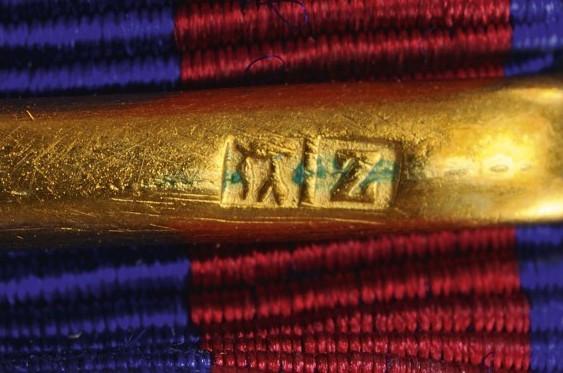
Gold hallmarks on the reverse face of the suspension loop of the Grand Officer Class neck badge of Dr. Quirico (behind the crown element). The left hallmark indicates 18 karat gold assayed by the Cairo office. The “Z” hallmark on the right indicates a date of 1924-1925. This set of hallmarks is the in the same position as that illustrated in the final photo of my 13 December, 2018 post showing the set of 3 hallmarks on the Commander’s neck badge from 1925-1926 that lacks a ribbon. Given how few images can be found of this portion of the suspension ring for the ribbon, it is unclear how common it is to have 2 or 3 hallmarks in this location. (From: https://www.coins-la-galerie-numismatique.com/auction-33-day-1/order-ismail)

Silver hallmarks on the reverse of the central tunic pin of the Grand Officer Class breast star of Dr. Quirico. The “S” visible in the background is from the “LATTES” hallmark. This image is oriented to show the hallmarks, with the superior portion of the breast star to the left and the inferior is to the right. The Silver hallmark on the left is the assay office mark for Cairo indicating 900 silver and the “Z” date is for 1924-25. Although some photos of the reverse of the chest star show the presence of this set of hallmarks on the tunic pin, few are high enough resolution to determine if they consistently exhibit 1 or 2 of the hallmarks. (From: https://www.coins-la-galerie-numismatique.com/auction-33-day-1/order-ismail)

Hallmarks on the central boss of a 3rd Class Commander’s neck badge from an August 2018 auction by eMedals. The description correctly identifies that the fineness mark indicates 18 karat gold (from the Cairo assay office), that the “stork” indicates Egyptian gold, and that the “A” dates the manufacture/hallmarking to 1925-1926. This Lattes example measures 61 mm wide x 79.5 mm tall, including the crown suspension device (probably only to the top of the crescent and star portions of the design). (From: https://www.emedals.com/egypt-kingdom-an-order-of-ismail-in-gold-1st-class-commander-by-j-lattes-c-8713)

Reverse of the right side of the crown suspension device on this same Commander’s neck badge showing the same isolated fineness mark identifying it as 18 karat gold from the Cairo assay office. (From: https://www.emedals.com/egypt-kingdom-an-order-of-ismail-in-gold-1st-class-commander-by-j-lattes-c-8713)
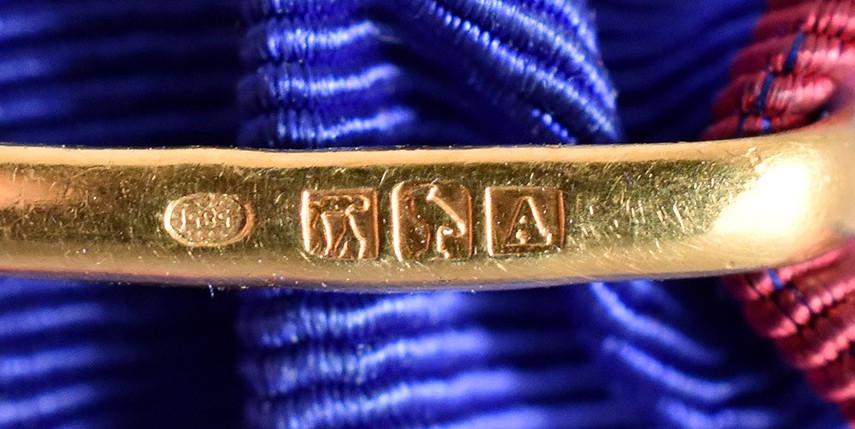
Image of the reverse of the suspension loop of the same Commander's neck badge showing the set of 3 Egyptian hallmarks in the same position as that shown in the final image of my 13 December, 2018 post and above for the 2 hallmarks on the named Dr. Quirico Grand Officer example. This example is unusual in also having an assay mark (European?) to the left of the Egyptian fineness hallmark that is identified in the auction description as reading “585”. This mark is upside down in relation to the Egyptian marks, and may be the result of a later assay of this piece outside of Egypt. This 585 mark is surprising as that would indicate 14 karat gold (“750” would indicate 18 karat gold), suggesting a discrepancy between the purity identified in the original Egyptian assay and this other (later?) test (possibly outside of Egypt?). (From: https://www.emedals.com/egypt-kingdom-an-order-of-ismail-in-gold-1st-class-commander-by-j-lattes-c-8713)
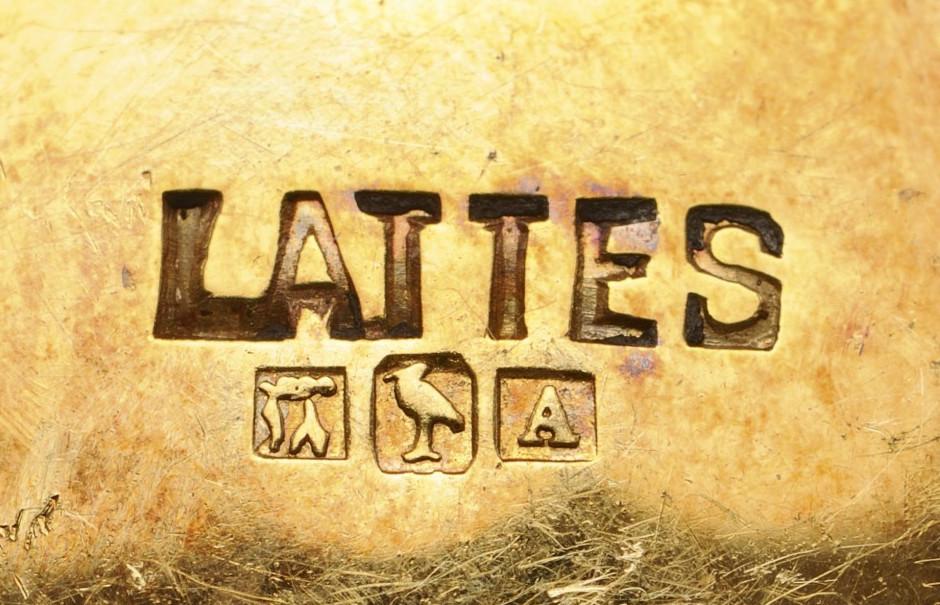
Hallmarks on the reverse central boss of a Lattes manufactured 3rd Class Commander’s neck badge from an April 2017 auction on the Sixbid.com website, showing good detail and some wear. The badge is identified as measuring 62 mm wide x 81 mm high and weight 47.8 g. (From: https://www.sixbid.com/browse.html?auction=3427&category=71681&lot=2842251)

Reverse of a 4th Class Knight’s breast badge made by J. Lattes from an October 2017 auction by eMedals. The obverse of this medal is illustrated in the 4th photo on my post of 13 December, 2018 in this thread. The auction description identifies this medal as 54.8 mm wide x 76 mm high, including the crown suspension device. No date is identified in the description of this piece. This image shows the placement of the 3 silver hallmarks on the inferior central ray of the rayed and facetted silver embellishment. This is the most common position for this set of silver hallmarks for the Knight’s medal. The placement of these silver hallmarks on the 2nd Class Grand Officer’s breast star and on the 1st Class Grand Cordon breast star is normally slightly more superior, because of the position of the catch for the tunic pin (see below). No gold hallmarks are visible on the reverse of the gold rays in this or the other photos of this medal, although some other examples (from other classes) clearly show such hallmarks (see below). The resolution is too low to read the silver hallmarks with certainty. (From: https://www.emedals.com/egypt-a-french-made-order-of-ismail-officer-by-lattes)
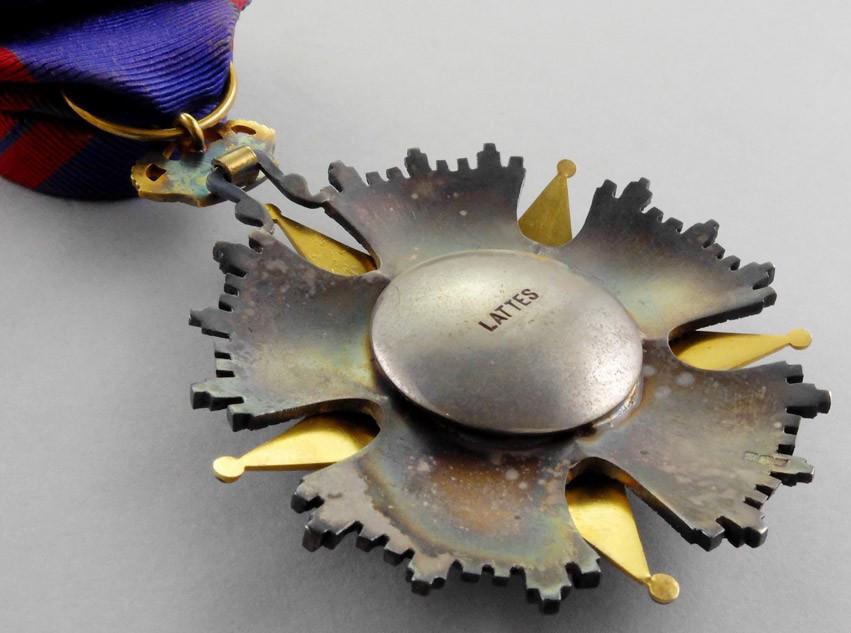
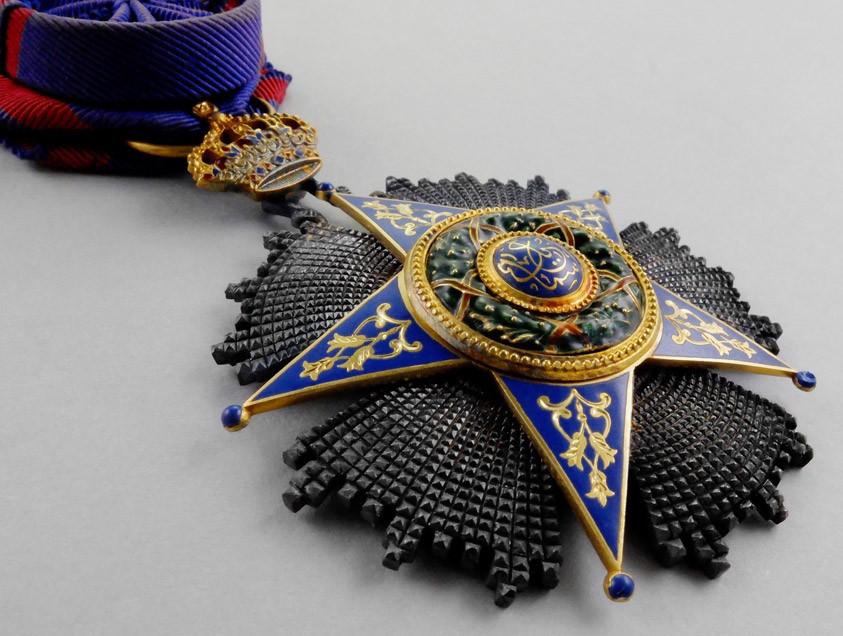
Above are two additional oblique images of both the reverse and obverse of this same Knight’s breast star showing some additional construction details (and the placement of the silver hallmarks on the reverse) that are not visible in full direct obverse and reverse photographs. (From: https://www.emedals.com/egypt-a-french-made-order-of-ismail-officer-by-lattes)

Reverse of a 2nd Class Grand Officer’s breast star from an example from a December 2017 auction on eBay. This is from set of the neck badge and breast star that is in its original case. This is an interesting Lattes example because of a slightly unusual placement of the silver hallmarks on the rightmost long ray of the silver rayed and facetted embellishment rather than on the central ray. The 3 gold hallmarks also are visible on the lower right arm of the gold star. The 2 hallmarks on the tunic pin also are visible showing the fineness (Cairo assay office 900 silver) and date (“Z”=1924-1925) hallmarks. (From: https://www.ebay.com/itm/EGYPT-ORDER-OF-THE-ISMAIL-2ND-CLASS-GRAND-OFFICER-ORIGINAL-CASE-RIBBON-RARE/222734299477?hash=item33dbffb155:g:5jQAAOSwQwBZkILL)
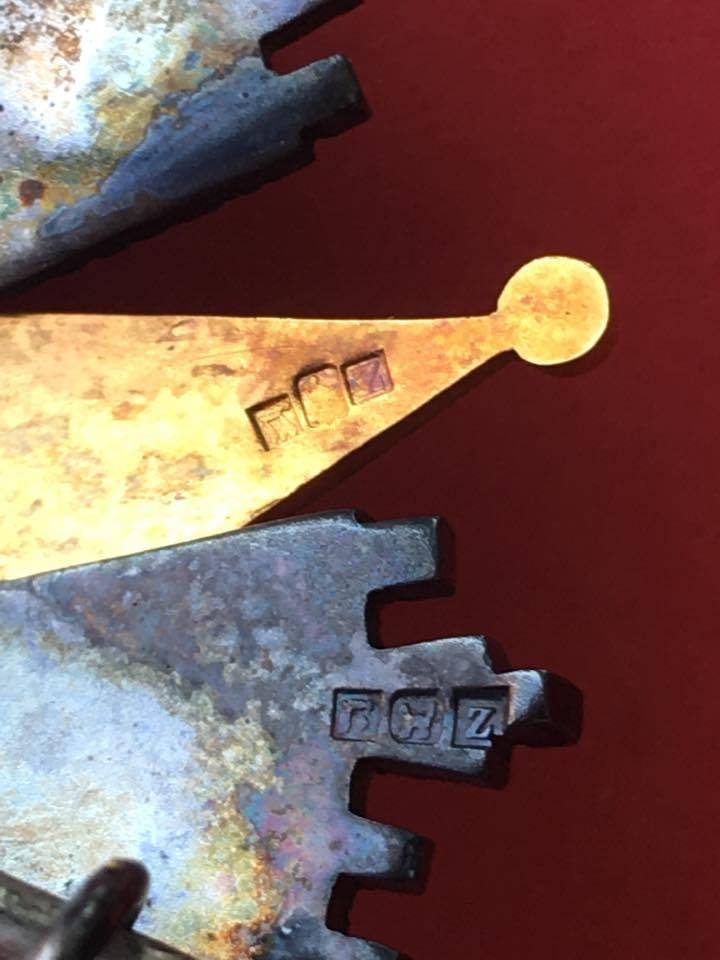
Close-up view of the same Grand Officer’s breast star from the eBay auction showing details of the silver and gold hallmarks. The silver hallmarks show the Cairo assay office 900 silver mark, the pre-1946 Egyptian silver cat mark, and the “Z” date hallmark. The gold hallmarks show the Cairo assay office 18 karat designation, the ibis mark for Egyptian gold,, and the “Z” date hallmark. Placement of the gold hallmarks appears to be more common on the reverse upper right arm in the few photos of other examples that show these marks (see below). (From: https://www.ebay.com/itm/EGYPT-ORDER-OF-THE-ISMAIL-2ND-CLASS-GRAND-OFFICER-ORIGINAL-CASE-RIBBON-RARE/222734299477?hash=item33dbffb155:g:5jQAAOSwQwBZkILL)
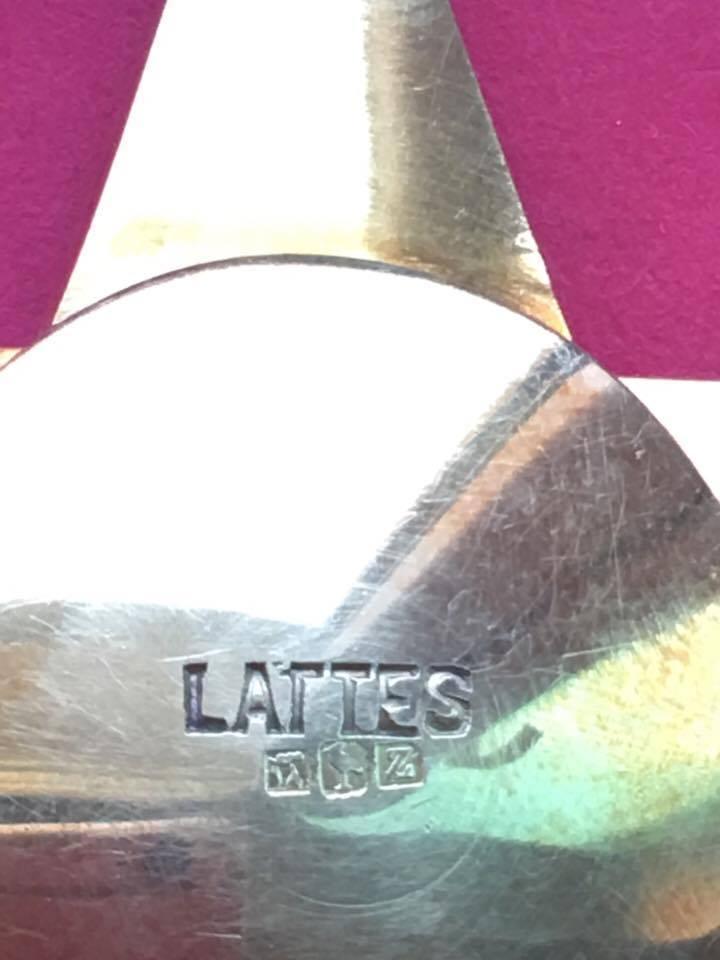
The gold hallmarks on the reverse central boss of the Grand Officer’s neck badge from this same set auction on eBay. (From: https://www.ebay.com/itm/EGYPT-ORDER-OF-THE-ISMAIL-2ND-CLASS-GRAND-OFFICER-ORIGINAL-CASE-RIBBON-RARE/222734299477?hash=item33dbffb155:g:5jQAAOSwQwBZkILL)
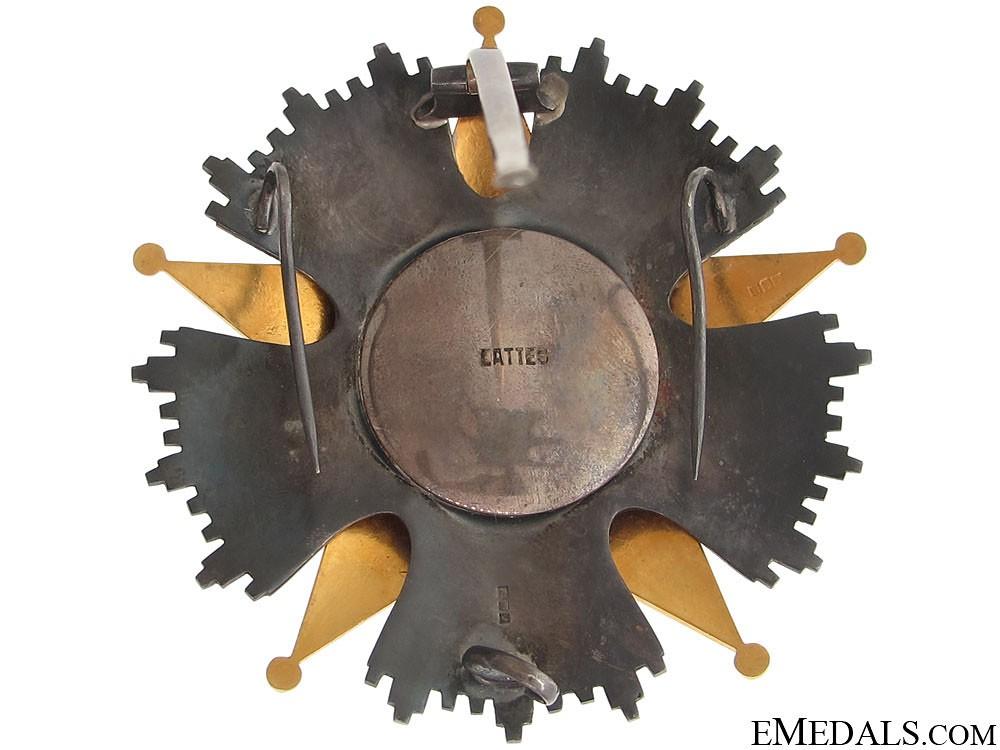
Reverse of a 1st Class Grand Cordon breast star from a pre-2016 auction by eMedals. I illustrated the obverse of this example in the first 2 photos of my post of 13 November, 2017 on this thread, and posted this image of the reverse in the 2nd photo of that post. I also posted images of the obverse of the sash badge of this set that show the position of the obverse hallmarks on the suspension device (2 hallmarks are visible in the 4th photo in that post) and the 3 hallmarks on the reverse of the suspension loop (5th photo on that post). The auction description of this breast star identifies this example as 81 mm in diameter, and it also incorrectly states that it is 22 karat gold. The silver hallmarks are visible with the tunic pin opened on the lower portion of the silver embellishment aligned with the central ray. In contrast with the previous example the gold hallmarks are visible on the upper right ray of the gold and enameled star. (From: https://www.emedals.com/order-of-ismail-1915-w01271)
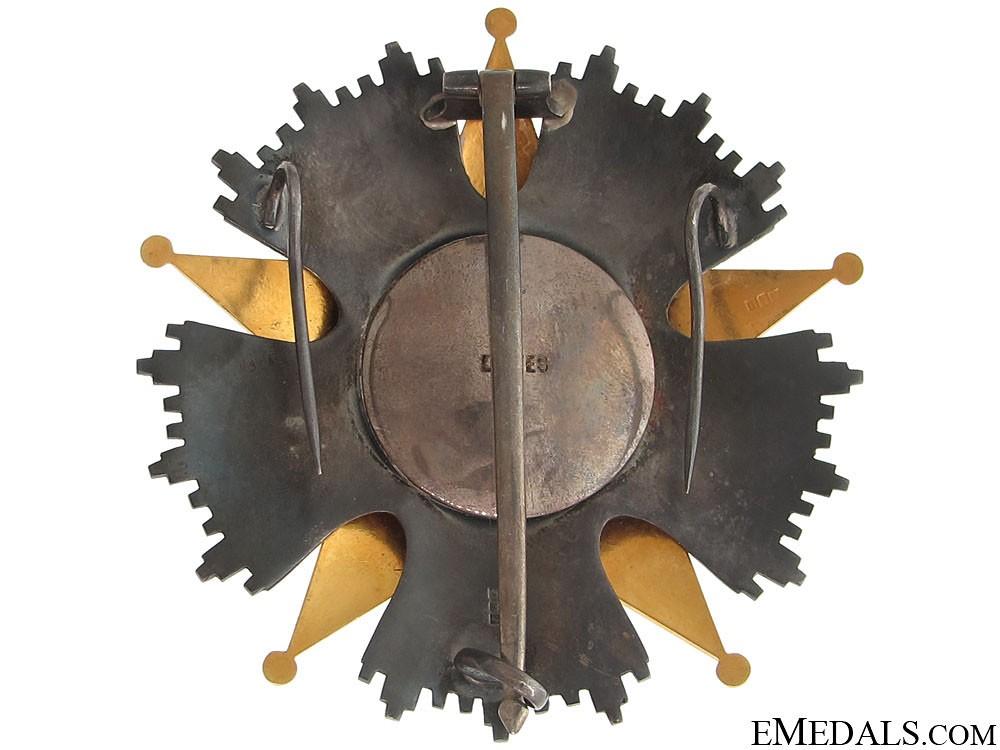
Reverse of the same Grand Cordon breast star with the tunic pin closed, showing no silver hallmarks on the pin. (From: https://www.emedals.com/order-of-ismail-1915-w01271)
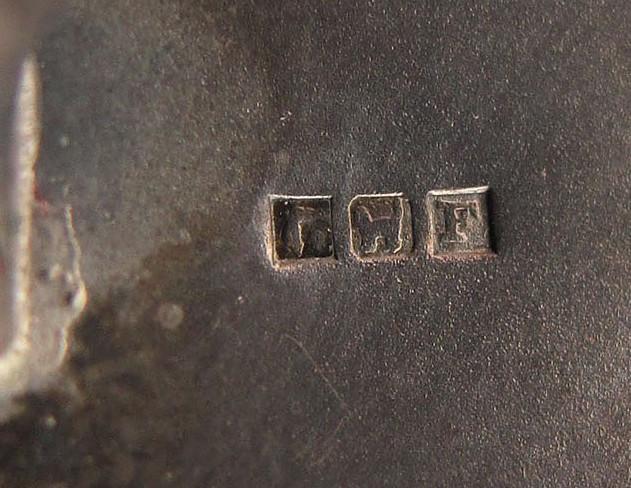
Close-up image of the silver hallmarks on the same Grand Cordon breast star. The inferior margin of the star is to the right and he superior margin to the left. This photo shows significant wear on the fineness hallmark, but it is the Cairo assay office's 900 silver mark. The country and precious metal hallmark is the pre-1946 cat, and the “F” date mark (the first table I uploaded on 12 September, 2018 identifies this mark as 1931-1932, but the second table I included in this post identifies “F” as 1930-1931). (From: https://www.emedals.com/order-of-ismail-1915-w01271)
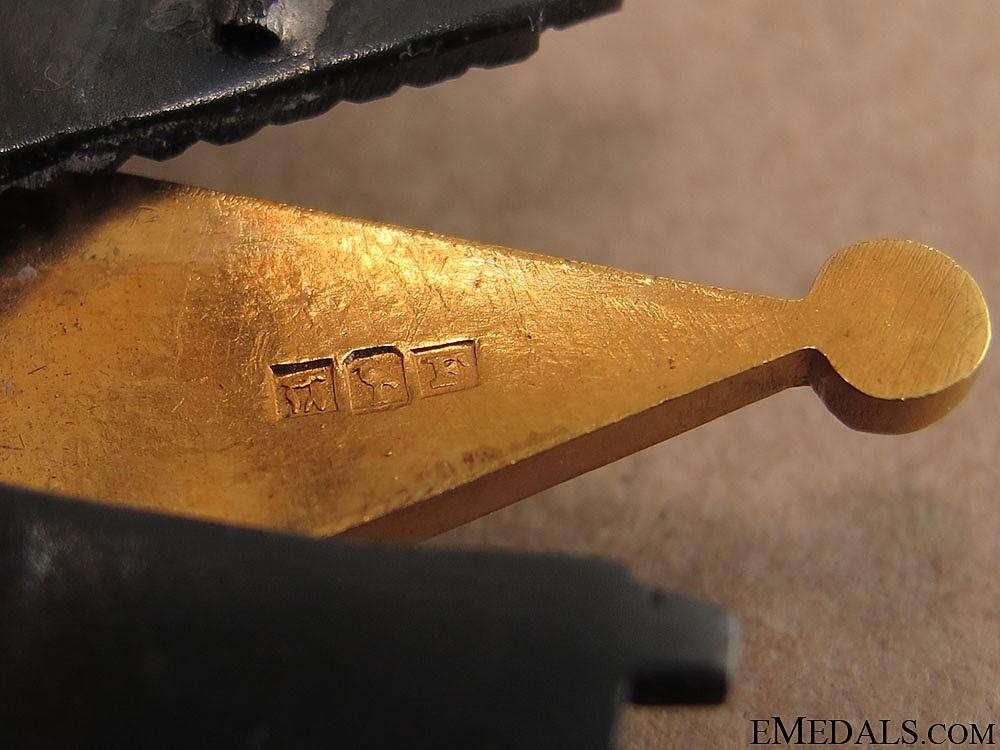
Close-up view of the gold hallmarks on the upper right arm of the star on the same Grand Officer’s breast star. The image is oriented correctly and so that the superior portion of the piece is upwards in the photo. The hallmarks identify the Cairo assay office determination of 18 karat gold, the Egyptian gold ibis mark, and the “F” date hallmark. (From: https://www.emedals.com/order-of-ismail-1915-w01271)
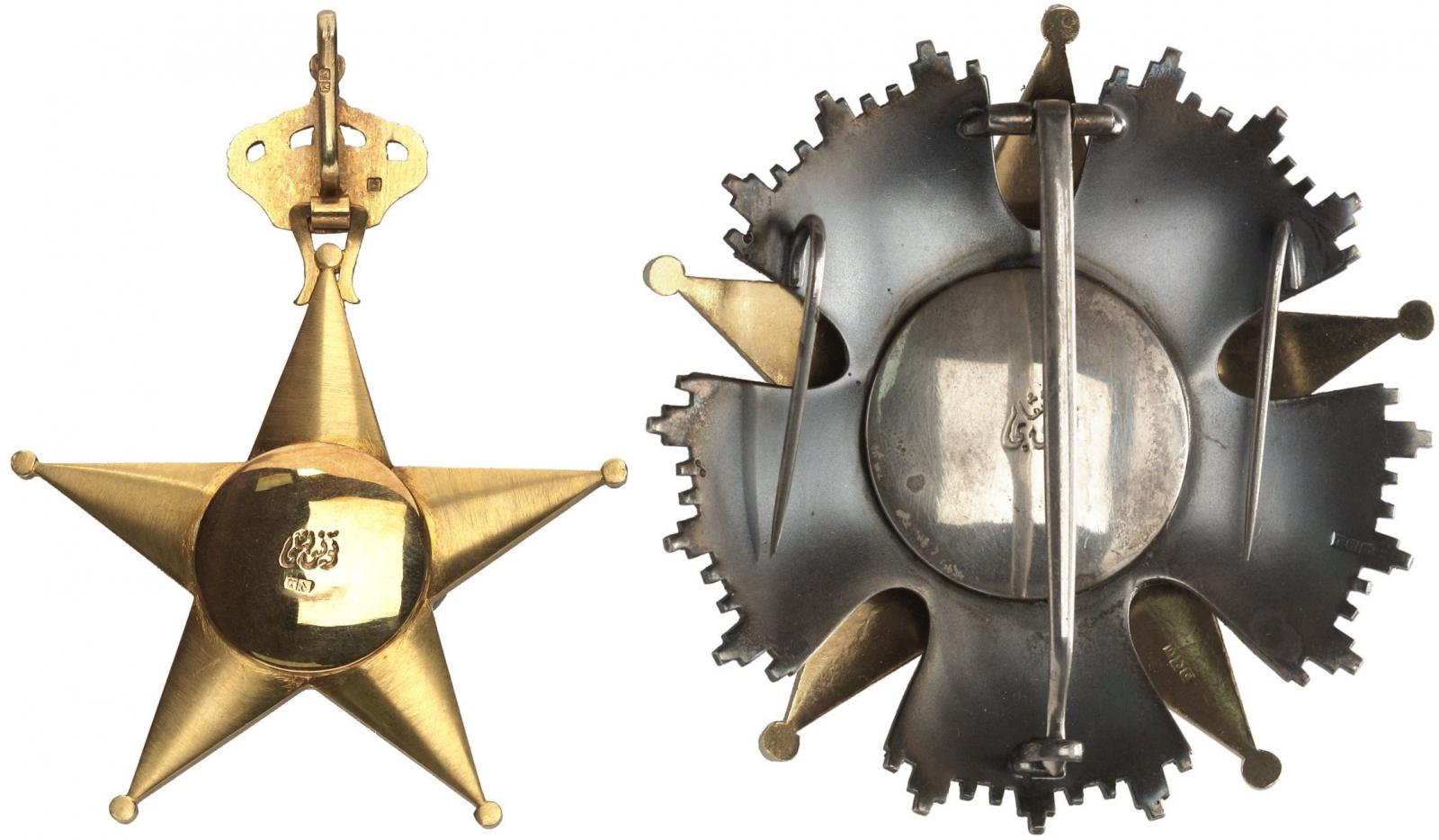
Photo of a 1st Class set of the Grand Cordon Class of the Order of Ismail, sash badge and breast star but lacking the sash, made by Tewfick Bichay of Cairo from a Fall 2014 auction of Künker Münzauktionen und Goldhandel. I posted the un-cropped version of this photo in my second post of 30 April, 2018 on this thread. These are high-resolution images that can be enlarged. The auction description identifies that the sash badge weight as 49.2 g (no size dimensions given), and states that the breast star measures 82 mm. The description also states that the gold hallmarks identifies 750 point fineness of the gold (=18 k) on the reverse of the suspension ring & reverse of the crown suspension device. It also identifies a hallmark "د" on the suspension ring (almost certainly the obverse?), that might be a date hallmark for 1948-1949 or 1951-53 (by both the chart I posted on 12 September, 2018 and in this post). However, such a date would be at odds with the other information in the auction description. The silver hallmarks on the reverse of the breast star are identified in the auction description as that of the Cairo assay office and 900 silver. It also states the country mark is the pre-1946 cat, followed by a silver date mark of "D" that is stated to represent 1929. I cannot read the silver hallmarks in the photo. Both the date chart I posted on 12 September, 2018 and the chart I posted today identify "D" as the hallmark for 1928-1929. The auction description identifies the gold hallmarks on the reverse of the arms of the gold star (of the breast star) as the Cairo assay office mark for 750 Gold (18 karat), the Egyptian country hallmark for gold (ibis), and describes the final (rightmost) hallmark as “ح” on the "pin" ( ["Nadel"]=most distal and near the finial of the star's arm?) with two "side" or "to the side" (?)["seitlichen]) "marks"(? ["Fixierhacken" “...und Punze "ح", an Nadel, mit zwei seitlichen Fixierhaken“-sorry my technical German its doch gar schlecht). The image above of the reverse of the sash badge shows similar placement of gold hallmarks on the suspension ring’s reverse as seen on other examples of the Commander’s and Grand Officer neck badges shown in this post (but as the auction description notes, just 2 marks are present=Cairo assay office marks for 18 karat gold and a probable date mark I cannot read). These are in a similar position to those on Lattes examples, but only 2 hallmarks are present and they are slightly offset to the left underneath the Tewfik Bichay hallmark (compared with the centered marks seen on the reverse boss of Commander’s and Grand Officer’s neck badges by Lattes). The left hallmark is the Cairo assay office mark for 18 karat gold and the right is the date hallmark (that I cannot read with certainty). The reverse of the breast star shows slightly different placement of the silver & gold hallmarks from those of J. Lattes of Cairo in the few auction images of the reverse of the Grand Cordon or Grand Officer classes that provide illustrations useful for locating these hallmarks. The silver hallmarks can be seen in the lower right set of rays rather than the more inferior position as on most all of the Lattes examples. The gold hallmarks can be seen on the lower right arm of the star. No hallmark is visible on the pin, unlike many examples illustrated of Lattes' medals. (From: https://www.kuenker.de/en/archiv/stueck/58396)
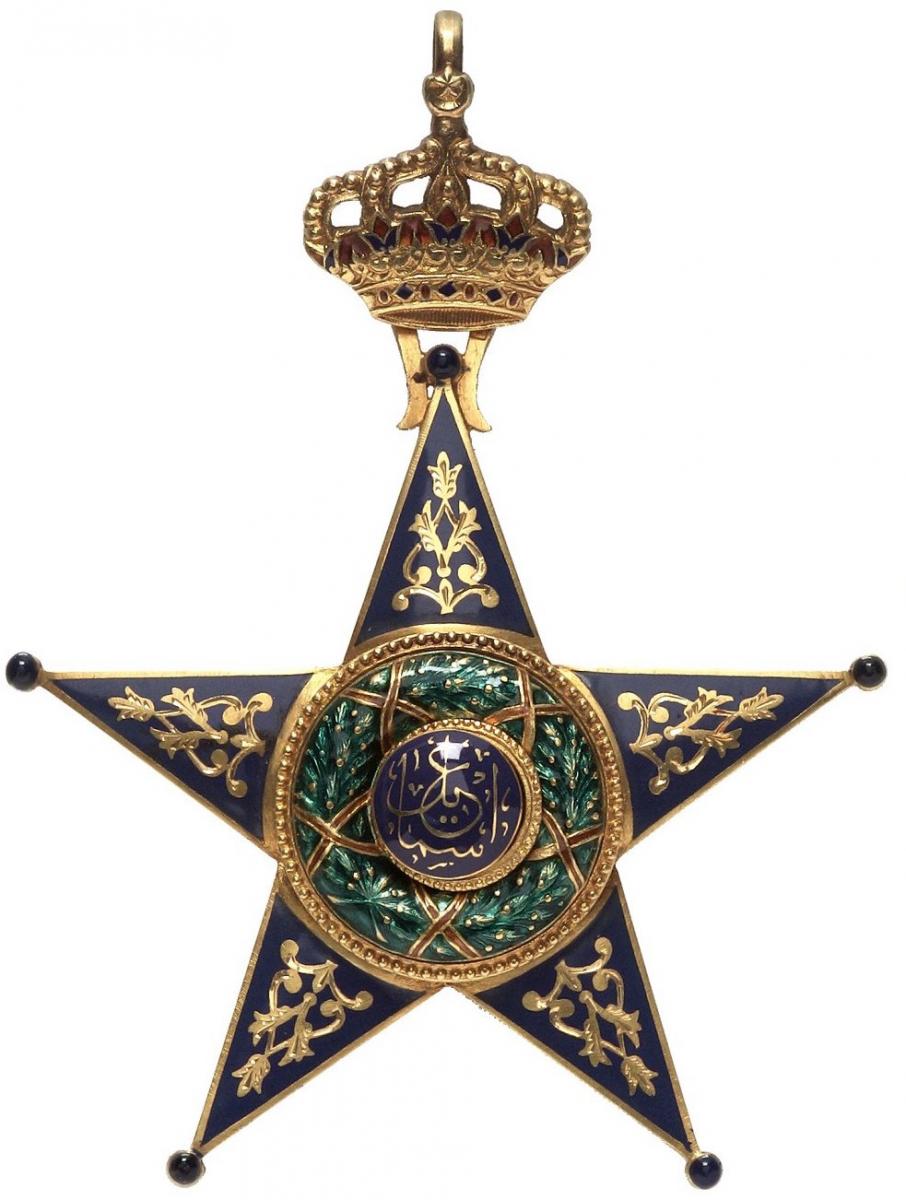
The obverse of sash badge from the same Grand Cordon Künker set. This example shows the single hallmark visible on the right suspension arm connecting the superior star arm with the crown suspension device. As noted previously, this is the same position of hallmarks on examples of the Commander’s and on Grand Officer’s neck badges made by Lattes. This single hallmark is visible on the right hand suspension device just below the base of the crown, but as this portion is obscured it is unclear whether any additional hallmarks also are present in this location, as they are on Lattes' versions of this award. The auction description identifies the hallmark "د" on the suspension ring, in a separate sentence from the statement about the marks on the reverse of the crown and suspension ring, presumably referring to this mark on the obverse suspension arm and suggesting there is only one hallmark here. (From: https://www.kuenker.de/en/archiv/stueck/58396)

A set auctioned by Sixbid in November of 2012 identified as the 2nd Class Grand Officer Class neck badge and breast star showing low-resolution images of the hallmarks on the reverse. This is the same photo I posted in the first image on my post of December 4, 2017 in this same thread.The auction listing incorrectly identifies that maker as “St Dionay”. Owain identified this as the Fahmy Tewfik Bichay (son of Tewfik Bichay) hallmark in his 5 April, 2018 post on this thread with excellent photos of the reverse hallmark on a comparable example of the 3rd Class Commander's neck badge. Owain’s example also shows the placement of possibly two gold hallmarks on the lower right (~5:30 position) of the central reverse boss. The illustrated silver hallmarks on the reverse of the breast star are similarly configured to those of the Fahmy Tewfik Bichay gold hallmarks on the neck badge. The positions of any gold or silver hallmarks on these 2 pieces cannot be determined from the photos. The other variant design element is the use of a suspension ring between the neck badge star (piecing the superior arm of the star) and the crown suspension device rather than the more common “arms” connecting the superior star arm with the crown. This form of the hallmark of Tewfik Bichay and the use of the suspension ring also is seen in the example of the 3rd Class Commander’s neck badge illustrated by Owain on 5 April, 2018 in this thread. That illustration shows the hallmark in good detail and this alternate form of the suspension loop and crown. As per my comment on the engraving on the obverse face of Owain’s example (of 21 April, 2018), note that the Kuenker example of the 1st Class Tewfik Bichay manufactured award clearly shows the engraving on the gold floral embellishments in the blue enameled arms of the neck star, unlike Owain’s example and possibly in this neck badge and breast star that also carry the same form of Tewfik Bichay’s hallmark. (From: https://www.sixbid.com/browse.html?auction=515&category=11656&lot=539476)
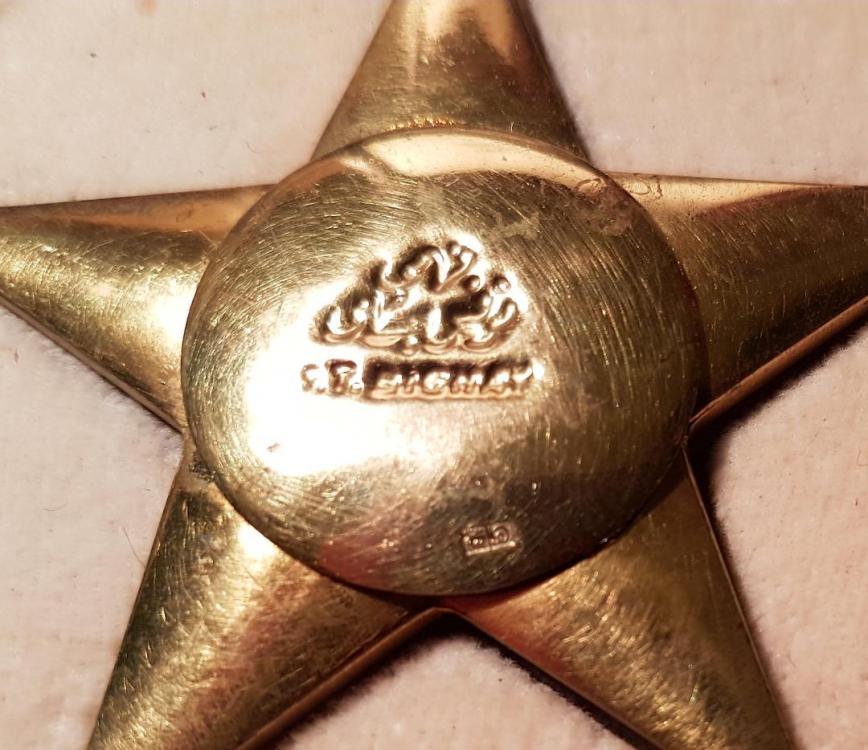
Reverse of a 3rd Class Commander’s neck badge posted by Owain Raw-Rees on this thread on 5 April, 2018, as noted above for the Sixbid.com example with the same Fahmy Tewfik Bichay manufacturer's hallmark. Owain’s example shows the placement of two gold hallmarks on the lower right (~5:30 position) of the central reverse boss. I cannot read them in this image, perhaps Owain can, but it is likely there are a fineness mark and a date mark. The probable date mark on the right is fairly clear, but I cannot match it with the marks on either date hallmark charts I have posted here (possibly the first of the listed 1982 marks on the chart in this post?-suggesting this is a monarchy in exile award).
0 -
Markus recently illustrated a couple nice exmples of the Order of Ismail from a Spink auction in the thread "Interesting Egyptian orders in Spink Auction" he started on 28 November here in the "Middle East & Arab States" section. That posting made me realize that I have not systematized the measurements provided on some auction sites and a few other references that may help distinguish the different classes of this order. That Spink auction listing provided dimensions of the medals, but did not identify the classes of the two examples being auctioned. For some distinctions, size clearly indicates which class these are. The "identification" of some of the classes is not always correct in these listings. That is understandable in relation to some of the regalia for this Order, especially the neck badge of the 2nd Class Grand Officer and the 3rd Class Commander (neck badge only) that appear to be the same dimensions, and possible also the sash badge of the 1st Class Grand Cordon when separated from the sash. However, enough other errors in assignments of class could be resolved through comparisons of any provided measurements that this seems to be a useful bit of information to include in this thread. There is some variation in the dimensions provided on various websites, principally it seems in where the measurement is taken on the suspension device for the vertical dimension. I may have looked at enough photos and descriptions to provide a pretty good key to the sizes. I apologize for the redundancies in descriptions and images with previous posts, but wanted to provide these data in a systematic way in one post.
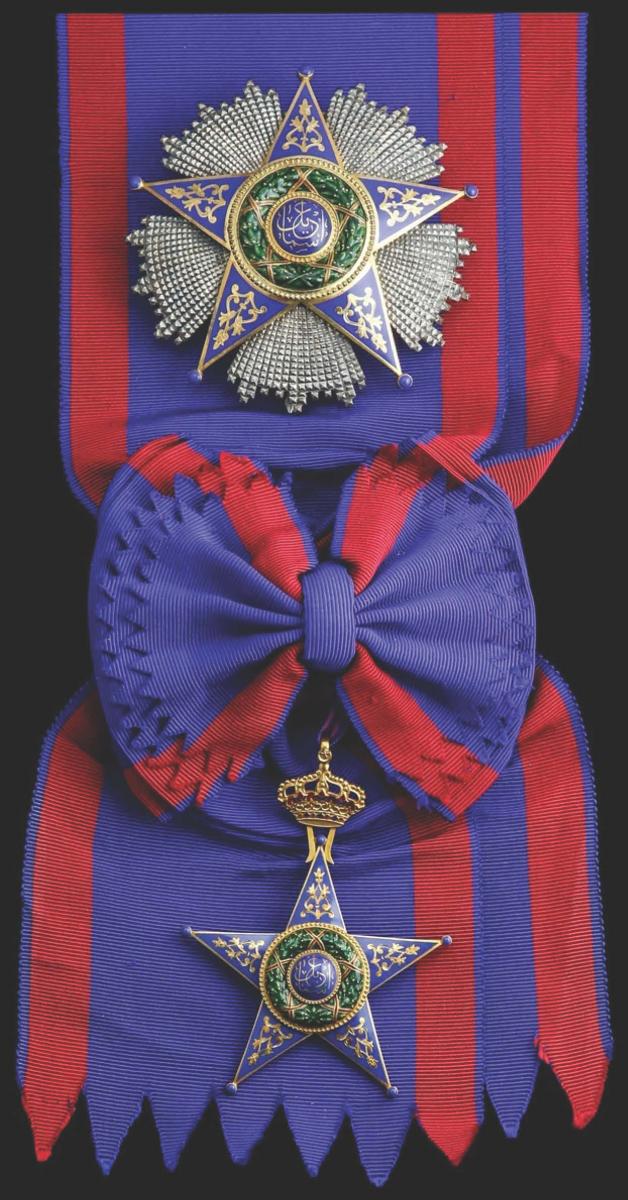
1st Class Grand Cordon (sash, sash badge, and breast star worn on the wearer's left) (From:https://www.spink.com/lot/17003000028)
The sash badge is 62 mm wide by 80 mm tall (including the crown suspension device to the top of the crescent and star). Some examples are identified as 82 mm tall, and this likely includes the suspension loop as well, but it is not always clear in the description). A few examples' widths are identified at 61.5 or even 60, but enough examples are identified as 62 mm wide that appears to be the most likely dimension. The JOMSA (2006, Vol 57 [4]: 20) description of this badge identifies it as 62 mm in diameter (excluding the suspension device) and 82 mm including the suspension. The best measurement sources from auction sites appear to be from eMedals listings. Most of these examples with measurements were made by Lattes of Cairo. There is some disagreement whether the sash badge is 22k or 18k gold (see final illustration and note below). I have not found weights for most examples, but one by Tewfik Bichay is identified as 49.2 g on the German auction site Kuenker that provides more detailed information about the purity of the gold and silver than is available on other listings (https://www.kuenker.de/en/archiv/stueck/58396). This badge also has portions that are silver gilt, and enameled. As noted in the same JOMSA description, the sash is 100 mm wide with 9 mm lateral red stripe inset 2 mm from each badge.
The breast star is fairly consistently identified as 80 mm in diameter in auction listings, although some examples are reported to be 81 mm or 82 mm. The cited JOMSA article published 84 mm as the diameter measurement. Again, it is unclear whether the badges gold is 22k or 18k. The star also has components that are silver, silver gilt, and the enameling.
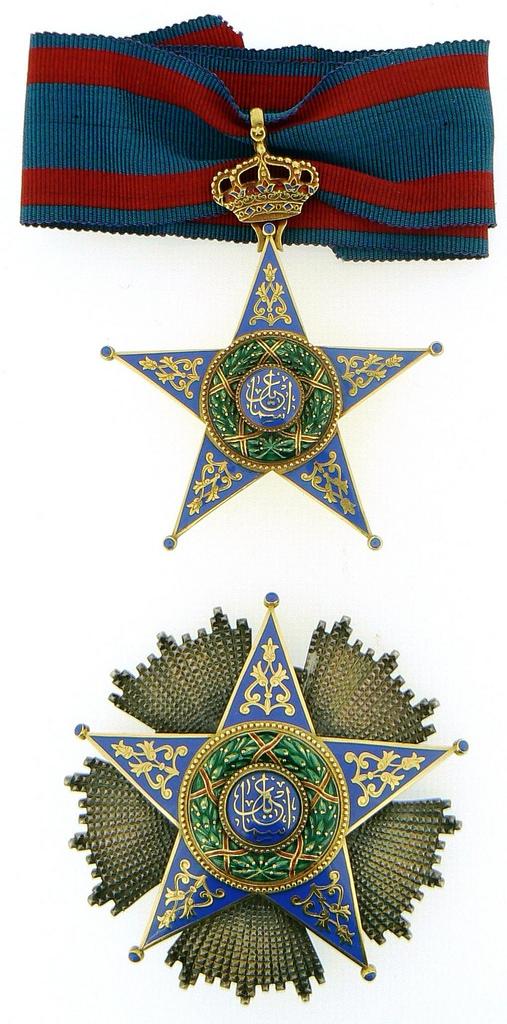
2nd Class Grand Officer (neck badge and breast star worn on the wearer's right) (From: https://www.flickr.com/photos/kelisli/8844318688
The neck badge is variously reported as 78 mm-85 mm tall. The most reliable measurements seem to fall between 78 - 79.5 mm identified as to the superior portion of the crown suspension, crescent & star (they do not always specify that the suspension loop is excluded from this dimension). A couple identified measurements are 85 mm tall, but this appears to be including the suspension loop. The width is most commonly identified as 61 mm, although 60 mm & 62 also are reported. Where reported, the weight is identified as ~47 g or 48.6 g. It appears the neck badge is both the same design and dimension as the sash badge of the 1st Class award and the neck badge of the 3rd Class award. The above cited JOMSA article identifies the neck ribbon as 37 mm wide with 5 mm red stripes set 1 mm from each edge.
The breast star is pretty consistently identified as 70 mm in diameter. The same materials are identified in the manufacture of the neck badge and breast star (gold, silver, silverer gilt, & enamel) as for the 1st Class, but the gold is variously reported as 22k or 18k (again, see final note below). The weight of the breast star is reported between 81 and 81.25 g.

3rd Class Commander (neck badge only) (From: https://www.emedals.com/egypt-kingdom-an-order-of-ismail-in-gold-1st-class-commander-by-j-lattes-c-1925)
The neck badge appears to be the same dimension as that for the 2nd Class award and the sash badge of the 1st Class. There is a fair bit of variation in the dimensions that are reported for examples where it seems to be a fairly secure identification of the 3rd Class. The most consistent reporting is that is it 61 mm wide and 78-79.5 mm tall. Some listings identify it as up to 82 mm tall, and this variation again appears to be likely due to various measurements either to the top of the crown and star or including the suspension loop. Also variously reported as 22k or 18k gold (see illustration of the hallmarks on the suspension loop of this badge on the final image below and the note). Several websites identify the weight as 48.6 g.

4th Class Knight (breast badge with ribbon adorned with rosette) (From: https://www.emedals.com/egypt-a-french-made-order-of-ismail-officer-by-lattes)
The breast badge is reported as 54.8 mm wide, a couple listings state 55 mm and one identifies it as 58 mm (?). The height is reported between 74 and 76, again probably due to differences in whether the suspension loop is included or only the crown with crescent and star. The materials are almost certainly the same as those of the larger 1st Class and 2nd Class breast stars.
Miniatures (from:https://www.sixbid.com/browse.html?auction=5367&category=168960&lot=4479892
All unambiguously genuine miniatures appear to be of the form I noted in my last post here of 10 November, 2018 and shown above. All of these examples are identified as measuring 20 mm wide x 30 mm tall (and seem to include only the suspension crown, crescent and star and not include the suspension loop). As posted above, the illustrated example is the 4th Class Knight miniature (in my 10 November posting, I mistakenly identified this mini as also on the L, the same side as the 3rd Class Commander mini with silver galon). All examples where materials are identified are silver or silver gilt and enamel.

Gold Hallmarks
A good quality close-up image of the hallmarks on suspension loop the same 3rd Class Commander neck badge shown above (https://www.emedals.com/egypt-kingdom-an-order-of-ismail-in-gold-1st-class-commander-by-j-lattes-c-1925). These are the same hallmarks that appear on the gold of most other examples as well. The hallmark on the left is the purity of the gold, and this mark appears to indicate 18k gold. The bird in the middle hallmark is usually identified as a stork, and is the Egyptian hallmark for gold. The "A" indicates a manufacture date of 1925-26.
0 -
I have been using a jumble of terminology to refer to the design elements on the Mixed Courts judicial badge. I wanted to extend some of the information on the components of the badge symbols here so that I can bring my terms in line with more standard usage.
Egyptian Zogist contributed an image of the French July Monarchy (1830-1848) coat of arms on 23 November 2016 on this thread, pointing out the similarities between the judicial badge design and the French coat of arms. That image shows the mantle (that I have been calling the "drapery" here in several descriptions), the tablet of law, and two crossed scepters behind the mantle that includes one on the left that shows that "hand of justice", and the mantle is surmounted with a royal crown. I illustrated two French coat of arms on 24 March, 2017 on this thread that also are framed with the royal mantle surmounted with a crown and having 2 crossed scepter with the left one having the hand of justice.
The coat of arms used as the basis for the configuration of the Mixed Courts badges probably derives from French versions of this design, although it also has significant similarities to those used by other European royalty. For example, the following example is the coat of arms of the German Counts zu Pappenheim (from: https://www.napoleon.org/en/history-of-the-two-empires/the-symbols-of-empire/; an excerpted set of examples posted by Andrew Andersen from von Volboth, Carl Alexander, 1973. Heraldry of the World. Copenhagen). This shows the use of the royal ermine lined mantle with crown exhibiting the mantle's the upper corners tied with a gold tassel.
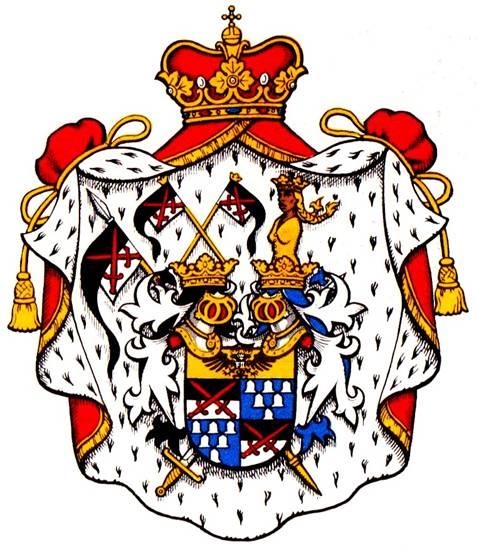
The following is the form of Napoleon's coat of arms he approved on 10 July, 1804 after being proclaimed Emperor in May of that year. This example is interesting for the similarities to the Mixed Courts judges badge in the form of the mantle, the royal crown, the crossed scepters that includes the lefthand one exhibiting the hand of justice, and the Chain of the Légion d'honneur surrounding he central shield with the emblem of the Order in the central inferior position on the coat of arms (as seen on the 2 French examples on my 24 March, 2017 post on this thread). From: https://www.napoleon.org/en/history-of-the-two-empires/the-symbols-of-empire/
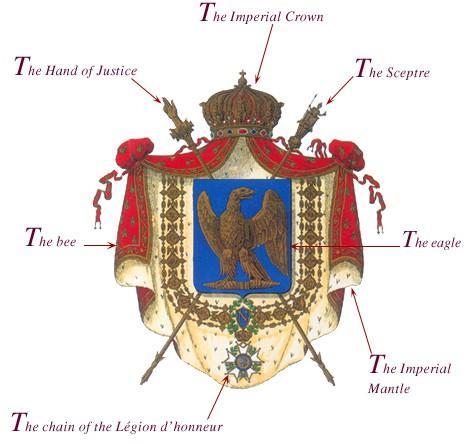
Below are two Egyptian examples from the reign of Khedive Isma'il Pasha (rule=1863-1879) that show adaptations of the French coat of arms to Egyptian/Ottoman symbolism that is reflected in the form of the Mixed Courts judicial badge. Khedive Isma'il Pasha created the Mixed Courts in October 1875 following the proposed bold reforms the Egyptian legal system developed by Nubar Pasha. These images are from http://www.hubert-herald.nl/EgyptKingdom.htm and use the term "achievement" to identify the forms and symbolism of these coats of arms.
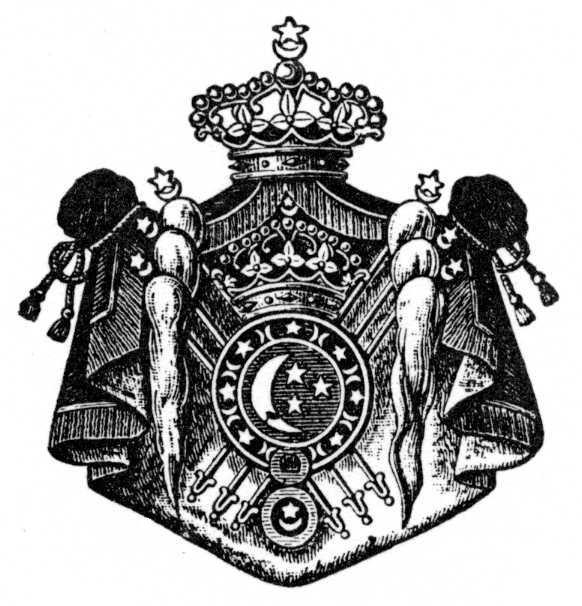
The Hubert de Vries website identifies this configuration of the "achievement" as the form Isma'il Pasha created after his promotion to Khedive (1863). Changes from previous versions includes the substitution of tughs for the 6 scepters that were featured in previous versions. Tugh is a Turkish word, possibly derived from Chinese (tu) and Uyghur (tugh), identifying rods with horsetails that are a military standard with various historical uses (I have been inappropriately calling these "whisks"). The substitution of tughs for the more European form of scepters and the inferior presence of a medal of the Order of the Crescent (instituted 1799) provide more Turkish (Ottoman) embellishments to this coat of arms. http://www.hubert-herald.nl/EgyptKingdom.htm.
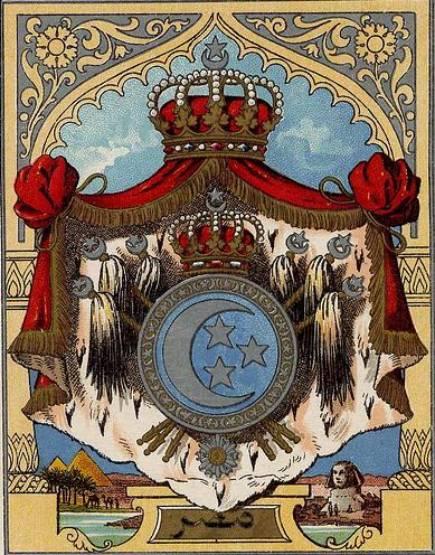
This second versions of the Khedive Isma'il coat of arms substitutes the Ottoman Order of Medjidie as the medal in the inferior position below the Azure arms with a crescent and 3 stars. This example also shows the ermine tails on the interior of the royal mantle quite well. This design change occurred sometime after Khedive Isma'il was awarded the Order of Medjidie in a special class with brilliants in 1863. The Order of Medjidie (created in 1851) is the award featured on the inferior margin of the mantle of the Mixed Courts judicial badge, that I have been referring to as a "tugra". The judicial badge shows the stylized Ottoman Tugra at the center of the medallion of this award. There is insufficient detail to know if it intended to represent the Tugra of the Sultan Abdülaziz (the 32nd Ottoman Sultan, reign=1861-1876), who was Sultan at the time the Mixed Courts were established (1875), or simply to indicate the Ottoman control over Egypt. http://www.hubert-herald.nl/EgyptKingdom.htm
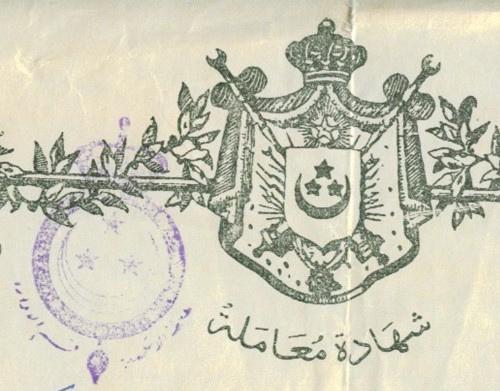
Khedive Abbas Hilmi II used similar forms of the above coats of arms, occasionally without the the tughs, and at least one form does not have a second crown above the central medallion with the crescent and 3 stars. This version above is identified as a military coat of arms ("achievement') probably from the time of Abbas Hilmi II (note the crossed cannon, rifles with bayonets, probably spears, and tughs as additional military weapons and symbols behind the shield, similar to weapons shown on the Ottoman Empire coat of arms). It is notable in comparison with the Mixed Courts judicial badge for the substitution of a five pointed star with rays above the central medallion rather than another crown (as seen on the Mixed Courts judicial badge). This coat of arms also shows the Order of Medjidie at the inferior position below the central shield. http://www.hubert-herald.nl/EgyptKingdom.htm.
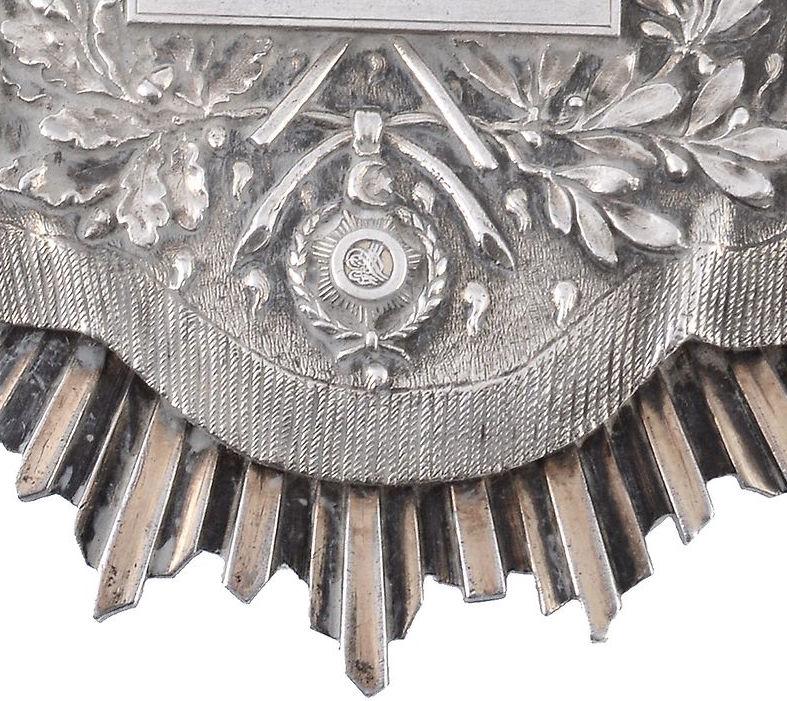
Detail of the Order of Medjidie symbol on the inferior margin of the silver Mixed Courts Judicial badge (this is the example that is supposedly attributed to Judge Herbert Mills: http://www.dreweatts.com/auctions/lot-details/?saleId=13863&lotId=175). This high resolution image shows good detail of the form of the Ottoman tugra on the depiction of the Order of Medjidie with its crescent & star suspension device. The tufts of ermine tails and the textured interior indicating fur lining of the royal mantle also are clearly evident in this close-up image.

The tugra of the 32nd Ottoman Sultan Sultan Abdülaziz (the 32nd Ottoman Sultan, reign=1861-1876), who was Sultan at the time the Mixed Courts were established (1875). Although the name portion of the tugra cannot be read in the stand portion (the lowermost component) of the tugra on the judicial badge, most of the form of the cipher is formulaic & artistic calligraphy, and that is what is shown on the Mixed Courts judges' badges. from: http://www.tugra.org/en/tugralar.asp
The same silver Mixed Courts judicial badge attributed to Judge Herbert Mills (http://www.dreweatts.com/auctions/lot-details/?saleId=13863&lotId=175) repeated here to illustrate the design elements of this badge. The form of the surmounting crown over the fringed and ermne-lined royal mantle is called the "Princely Crown" and was used from 1854 until ~1922. It is based on European style crown with a purple velvet cap, a diadem that often is shown with 5 leaves & 5 hoops (but on the judicial badge has 7 leaves & 7 hoops) and is surmounted by the crescent & star (from 1923-1952 a versions called the Egyptian Royal Crown was used with five pairs of papyrus blossoms, 5 hoops, and surmounted with a globe supporting the star & crescent). The judicial hand on the distal portion of the L side tugh appears to be derived from a Christian symbol (sometimes called the hand of benediction with the 4th & 5th fingers bent over the palm). The branch of oak leaves & acorns on the L side of the judicial tablet also derive from European heraldic use, considered emblematic of faith and endurance. The branch of laurel on the R is used in European heraldry as a symbol of victory, especially triumph and fame that is won after long internal struggles. The rays around the margins of the badge (as well as the star with rays above the central tablet) may be an adaptation of the symbolism of the Ottoman sun. The inscription on the central tablet reads: "Justice is the foundation of kingship/governance" as translated by Egyptian Zogist on 23 November, 2016.

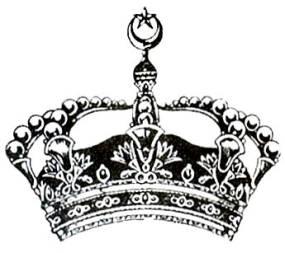
Left is the Princely Crown used from 1854 to ~1922. On the right is the Egyptian Royal Crown used from 1923-1952. (http://www.hubert-herald.nl/EgyptKingdom.htm)
0 -
I came across this unusual pin or badge on The Saleroom website for an upcoming auction by Bamfords Auctioneers & Valuers (https://www.the-saleroom.com/en-gb/auction-catalogues/bamfords/catalogue-id-bamfor10553/lot-546dbbb8-f7b1-4f6a-a2ba-a9a0009cb8b5 and http://www.bamfords-auctions.co.uk/auctions/21-11-2018-gentlemans-library-and-grand-tour-of-auction-curiosities-sale/lot-3620A/img-0/). This is lot 3620A that is misidentified as the "Order of the Khedive". It is 11.5 cm high, the same size as the Mixed Courts judicial badges, and may be silver gilt, with enamel. The auctioneer identifies it as a medal from the Kingdom of Egypt, dating to the early 20th century. I have never seen another example of the Mixed Courts judicial badge in this form. It is unclear whether this full sized "replica" would have had any official function or if it may be a unique large pin that was personal jewelry rather than a component of any judicial regalia. The reverse does appear to have a makers' mark, and it may be a "Horovitz" mark from what I can see in the low resolution image. I am unsure whether this would be an actual Horovitz construction or a copy that includes this manufacturer's name. It also does have silver hallmarks in the same locations that they appear on the fully-detailed badges (however, the resolution of the images is too low to read the hallmarks).
Obverse of this unusual, full-sized "imitation " of the judicial badge design showing the dramatically abbreviated versions of the design elements of the Mixed Courts badge. Note the whisk on the upper L repeats the crescent motif (normally seen only on the upper R) rather than the hand. The white enamel around the tugra medallion (lacking any indication of the cipher) has no indication of the 7 pointed multi-rayed star nor the crescent & star that is usually suspended below the crossing point of the oak & laurel branches below the tablet with the inscription. Silver & enamel.
Reverse of this unusual pin or badge showing manufacturers' and silver hallmarks. The silver hallmarks near the inferior portion of the lower relief area under the pin and on the pin just proximal of the union of the double tongue with the single pin of the distal portion this tube hinge pin. Just to the left of the silver hallmarks on the pin ~ 3.5 letters are visible that may be "HOROV...". Marks on the upper left quadrant of the reverse, and on the tablet with the inscription of the obverse, show that this piece was cast not struck (as is also clear in the form of the obverse design).
0 -
Below is an example of the Mixed Courts judicial badge from a current eBay auction (https://www.ebay.com/itm/EGYPT-KING-FAROUK-SILVER-GILT-ENAMEL-JUDGE-BADGE-IN-ORIGINAL-CASE-XXX-RARE/223228334558?hash=item33f97211de:g:1o0AAOSwBURb6gap). This is the only example I have encountered that is clearly identified as having been made by W. Horovitz of Alexandria. It is possible that the reverse of the gold Appeals Court badge Illustrated in the 5th photo on 24 March, 2017 indicates it was made by Horovitz. The resolution of this image is not good enough to read the name on the hallmark that is mostly obscured by the pin. When I first saw it on flickr it looked as though it stated with "MO" (but is probably "HO") and the ending of the hallmark now looks as though it may be "TZ". I am nearly certain that gold example is a Horovitz manufacture, only since finding that name associated with the badge I am illustrating here. Wolf Horovitz was a Romanian jeweler who settled in Alexandria, kept his business on the Rue Chérif Pacha and became a leading jeweler and watchmaker. His clientele were wealthy Egyptians and the Royal Court of King Fuad I and Farouk I. Much of the material he sold was obtained or manufactured in Paris (often hallmarked as made for Horovitz). The badge was originally designed by Froment-Meurice of Paris, and most auction examples are made either by Froment-Meurice or Stobbe of Alexandria. I have seen several examples with no manufacturer's hallmarks (some illustrated on this thread). Supposedly, these badges also were made by Lattes of Cairo, Tewfik Bichay of Cairo, and M. Laurencin & Cie. of Alexandria, although I have never seen a photo of the hallmarks of any of these manufacturers on any examples of the Mixed Court badges. This Horovitz badge is identified as measuring 115 x 85 mm, and weighs 161 g. The badge is gilt silver and is being sold in its original case. There are some slightly less detailed aspects of the engraving of this example compared with other badges, i.e., the hair on the whisks in each upper corner are less detailed than on many examples, the fringe & border design on the drapery is less detailed and in lower relief, as are the tassels on each of the drapery corners (all of this lesser detail is similar to the 2nd example I illustrated on 31 October, 2018 made by Stobbe), some of the leaves around the central tablet may be less detailed, and the crown also appears to be in lower relief (although some other badges may also exhibit this level of detail of the crown, or it could just be the perspective the photo provides). The wreath around the lower star & tug is made of larger, less detailed leaves than many of the judicial badges made by Froment-Meurice and Stobbe. However the wreath appears similar to that of the badge I illustrated on this thread in the 1st photo on 31 October, 2018 that was made by Froment-Meurice (although other aspects of the design appear more detailed in that example). The hallmark "N" on the reverse of this Horovitz badge and on the pin indicates a manufacturing date of 1938-39. This badge is supposedly identified as having been used in the Alexandria Courts during the reign of King Farouk I in 1937-38. As a silver badge, this should have been worn by a judge of the Parquet (office of the Procureur-General who prosecuted cases in front of the Mixed Courts).
Obverse of this silver Parquet badge of the Mixed Courts made by Horovitz of Alexandria showing several of the lower relief details in the fringe & border design of the drapery, the tassels in each upper corner, the whisks in each upper corner of the drapery, possible in details of some of the leaves surrounding the central tablet & inscription. The calligraphy on the legend is executed in thinner enamel lines than most other examples, with a few differences not seen on other badges.
Reverse of the Horovitz judicial badge
The Horovitz judicial badge in its case.
The W. Horovitz name and address (26 Rue Chérif Pacha, Alexandria) inside the lid of the case. This business was listed as still existing on Rue Chérif Pacha at least as late as 1970.
The interior of the case showing the fit for the back pin of the badge.
Detail of the badge reverse showing the Horovitz hallmark and the 3 silver hallmarks including an "N" indicating a manufacturing date of 1928-39.
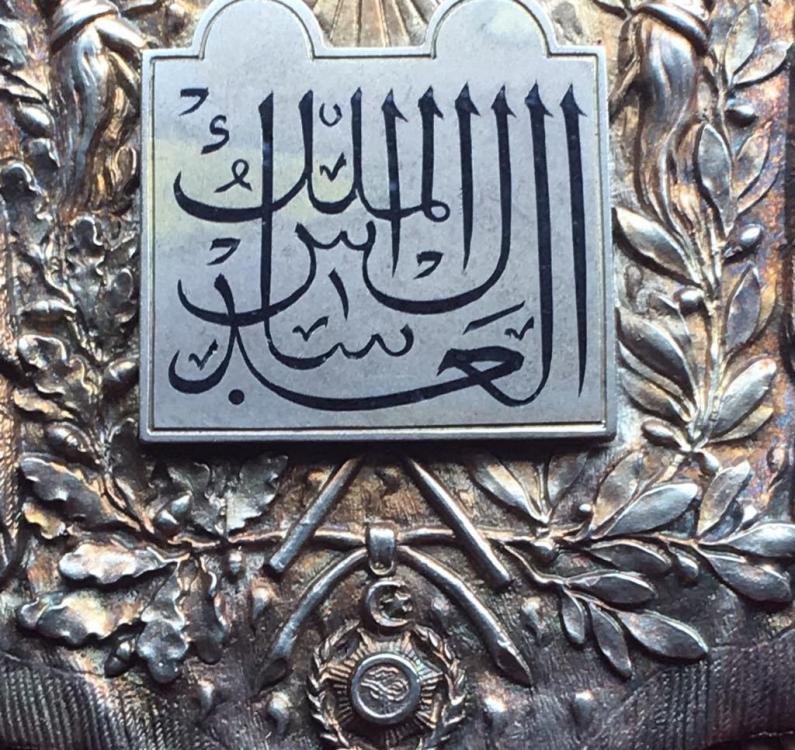 Detail of the tablet and surrounding decoration showing some of the lower relief detail of this maker's version of the judicial badge.
Detail of the tablet and surrounding decoration showing some of the lower relief detail of this maker's version of the judicial badge.

Postcard showing the Rue Chérif Pacha in Alexandria, probably between 1900-1910. (https://upload.wikimedia.org/wikipedia/commons/1/1d/Alexandrie_Rue_Cherif_Pacha.jpg).
0 -
The monarchy in exile version of the Order of Mohamed Ali illustrated in the Spink catalogue is the same design as the pre-1952 revolution period award. As I understand what 922F indicated in his 22 April, 2018 post on the "Question about the Order of Ismail/Nishan al-Ismail" thread is that the Nishan al-Noor, Order of Light (that Spink lists as the Order of Women) is a new design that has no pre-revolution equivalent.
0 -
Anyone who loves the the Order of Ismail is a pal in my book. You also reminded me I should try to codify measurements for each class. Many of the "identifications" I see on auction sites are problematic, but some do provide metrics, and I may have looked at enough examples now to be able figure out the correct dimensions. That would be a useful addition to my Order of Ismail thread, so thanks for providing me something else I could contribute there.
Cheers!
0 -
Thanks for illustrating these offerings. At 72 mm in diameter, the Order of Ismail chest star represents the 2nd Class Grand Officer version. The "B" mark indicates a date of 1927-28. The neck badge is either a 2nd Class Grand Officer or 3rd Class Commander award. I believe that both the 2nd & 3rd Classes are the same diameter, but I am looking through some other auction data to see if there is any difference in sizes between well-identified examples of the Grand Officer and Commander classes of the neck badge. The "Z" mark on the neck badge indicates a 1924-25 date. The auction description does not suggest they are a Grand Officer set, and if the dates are correct that also would indicate there are not associated.
922F provided an illustration of the new monarchy in exile award of the Nishan al-Noor, Order of Light (that Spink lists as the Order of Women), on his post of 22 April, 2018 on the thread "Question about the Order of Ismail/Nishan al-Ismail" I started on 7 November, 2017 here in the Middle East & Arab States section. He also stated that the Order of Mohammed Ali is one of the Orders that the monarchy in exile still awards (this Spink example is identical to the pre-1952 Grand Cordon award, one of King Fuad II's favorite to wear along with the Order of Ismail and Order of the Nile.
0 -
I missed the editing window in relation to the last miniature of the Jordanian Hashemite Kingdom Order of Independence shown above on my 2nd post of 17 November, 2018. The catalog identified this medal set as a "Commander's Set", however this 2nd Class award would be that of the Grand Officer. The salon on the ribbon with gold on the L and silver on the R is the correct configuration for the Grand Officer, 2nd Class of this award.
0 -
Lmaas1, you are most welcome, it's a pleasure to discuss some of these issues from my professional work here on GMIC. Nocks are sometimes cut off or trimmed if they became damaged. Additionally, even without a nock plug, folks may not carve a groove in the nock, but they may develop one from use and wear on the string. All of the nock ends of the arrows I illustrated in the 3rd photo of my post of 10 January 2018 on the "South American bows and arrows " thread to show the different fletching are flat, reinforced nocks that may develop a groove from the bowstring but do not have any carved into the mainsheet. Some museum examples from the River Pumé (who live along major drainages of the Orinoco and are not mobile foragers like the Savanna Pumé and grow a variety of crops) that I have examined exhibit wooden nock plugs, so there can be significant variation even within one ethnicity.
The lanceolate arrows would be used for larger game, and that is dependent on the geographical area of course. Let's continue to work with the idea that these may be South American arrows. The folks I work with in Venezuela have a very impoverished fauna, that kind of open savanna is associated with low soil fertility and the low underbrush cover that has a negative relationship on animal density & diversity. The Pumé rely on small body sized animals for 87% of all captured game in the wet season when they focus on terrestrial hunting for their protein (In the dry season they shift to fishing), principally using the same fishing arrows to catch those animals. 3 species; armadillos (max 900 g), tegu lizards(~700-900 g), and small 100 g lizards were 87% of all hunting captures in my quantified data. Any animal that was 6 kg or larger was shared with the entire camp of ~63 people (including children). I've seen them use lanceolate points to hunt anteaters and deer, caimans are captured with a harpoon & dispatch with a machete. For many S. American indigenous groups, they don't even bother spending time pursuing animals that are just 6 kgs, unless it is late in the day and they are unlikely to encounter additional game. For the Pumé, "large game" includes lesser anteaters (~ 6 kg), caimans (up to 60 kg), giant anteaters (~35 kg, I have been on trips when we found sign of these but I've never seen one killed), capybara (~50 kg), pacas & agoutis (max 10kg, I've been on trips where we encounter them but didn't capture any), peccaries (20-35 kg, I've seen sign but never encountered any); tapir (up to 200 kg, I've never seen them in the wild and only eaten tapir at a criollo's house once), and deer (brocket =mx30 kg; white tail=50-120 kg). An inventory of all the larger game (6 kg or larger) that came into camp over a 24-month period included 2 deer, 1 capybara, 6 lesser anteaters, and 7 caimans. Most South American groups are forest dwellers, and long, barbed monkey arrows are common for those animals. Large game for most S. American indigenous groups in forests includes deer (brocket & white tail); tapir; peccaries (collared & white-lipped); caimans, pacas & agoutis, giant armadillos, some groups may eat giant otters, a few groups will eat anacondas.
Very few traditional folk do any kinds of target practice. That is why I posted the unusual images of boys doing target practice in the first 4 photos of my post of 9 March, 2018 on the "South American bows and arrows" thread. Those were the only 2 such events I have witnessed in over 30 months of fieldwork with the Pumé. Warfare is common only among a few groups in South America. Some groups, such as the well-known bellicose Yanomami will use their large, lanceolate points (made from a kind of bamboo) that are their large game arrows in ambush raids to shoot people. Many groups (such as the formerly more belligerent Guahiboan group of Colombia and Venezuela that surround the Pumé) would make specialized war arrows with a series of scary barbs proximal to the main lanceolate point (especially in hardwood) to make them cause more damaging woulds and be very difficult to remove.
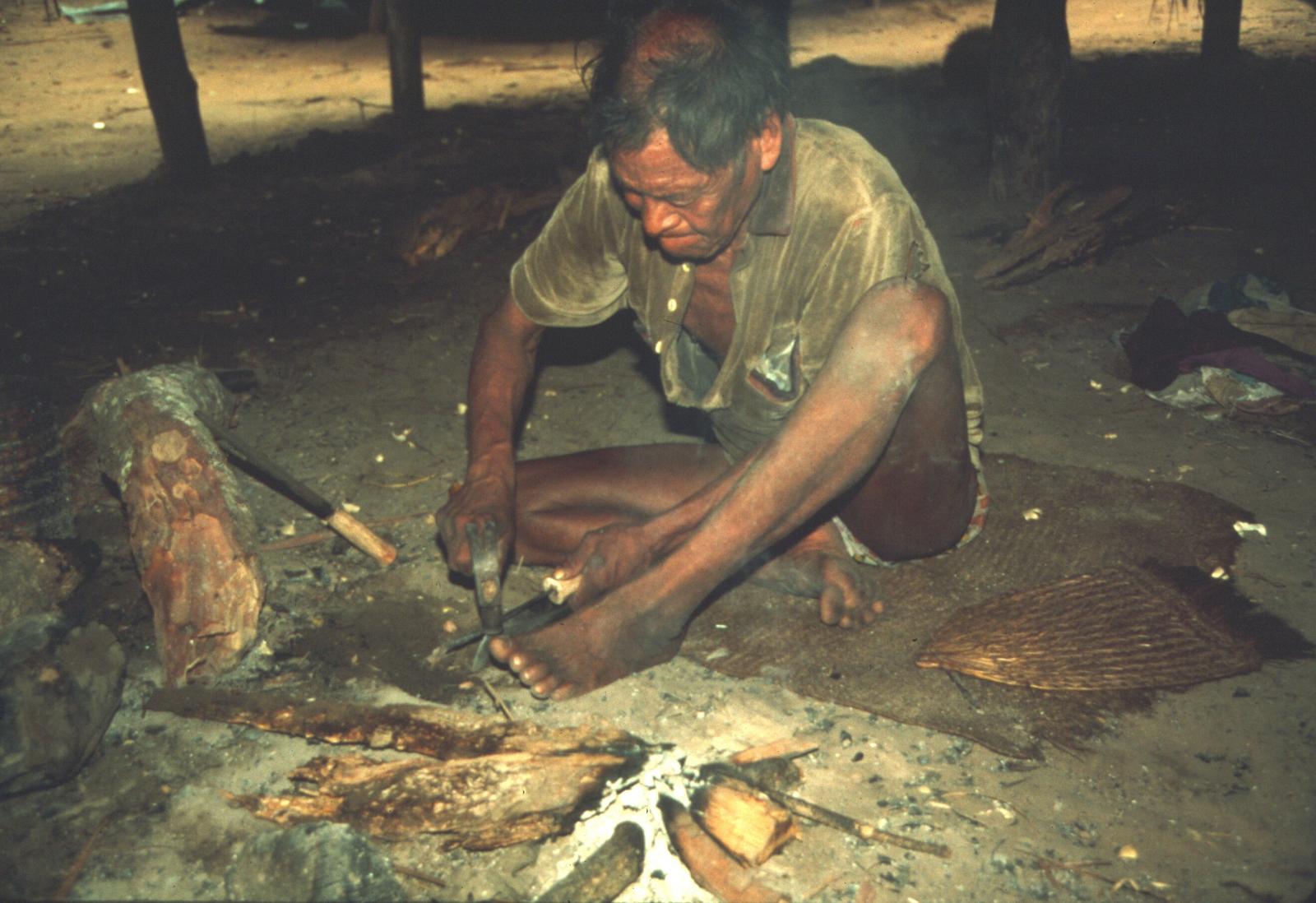
Savanna Pumé man cutting a proximal barb into a point using a hammer to strike the point on an axe head blade (sunk in the sand) in 1990. The point is made from a nail that has been heated in the fire in front of him and hammered square and the ends thinned using the hammer and the fact side of the axe head as an anvil. This barb will resemble that in Lmaas1's arrow shown 2nd from the L in the 3rd photo posted on 9 October, expect that the barb will be more distal on the point (see my examples in the "South American bows & arrows" thread).
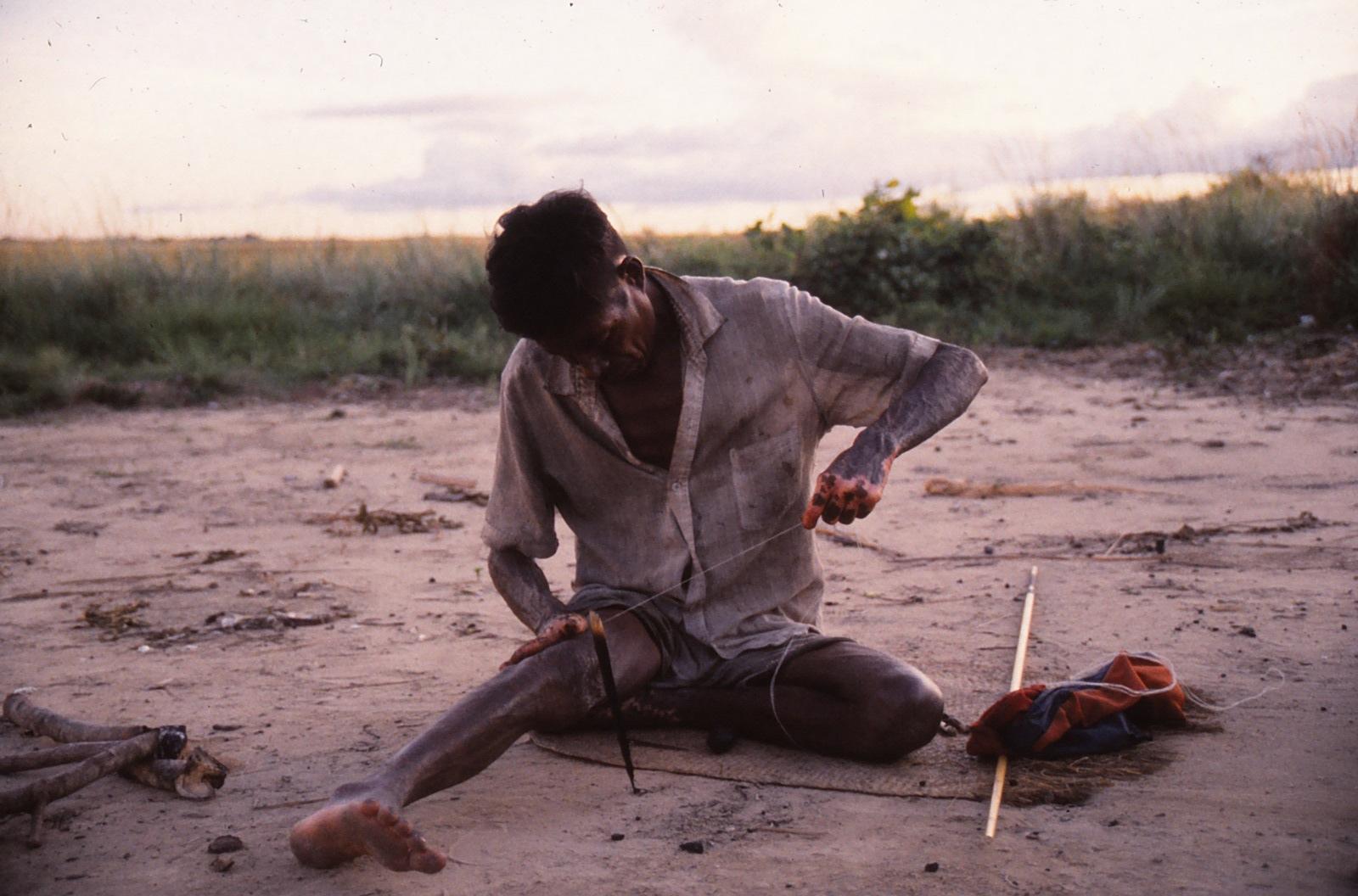
Pumé man twisting wild bromelia fiber into winding for arrow manufacture in 1990. There is a fletching feather stuck in the ground in front of him (an anhinga tail feather) that he will use for tangential fletching of this arrow (the arrowcane is seen just to the R of the man, partially covered by a cloth bag that contains his arrow making gear and an hallucinogenic snuff taking kit). The discoloration of his hands and arms is an innocuous condition cause by a spirochete. All the heat he needs for arrow manufacture is represented in the 4 sticks at the extreme L of the photo.
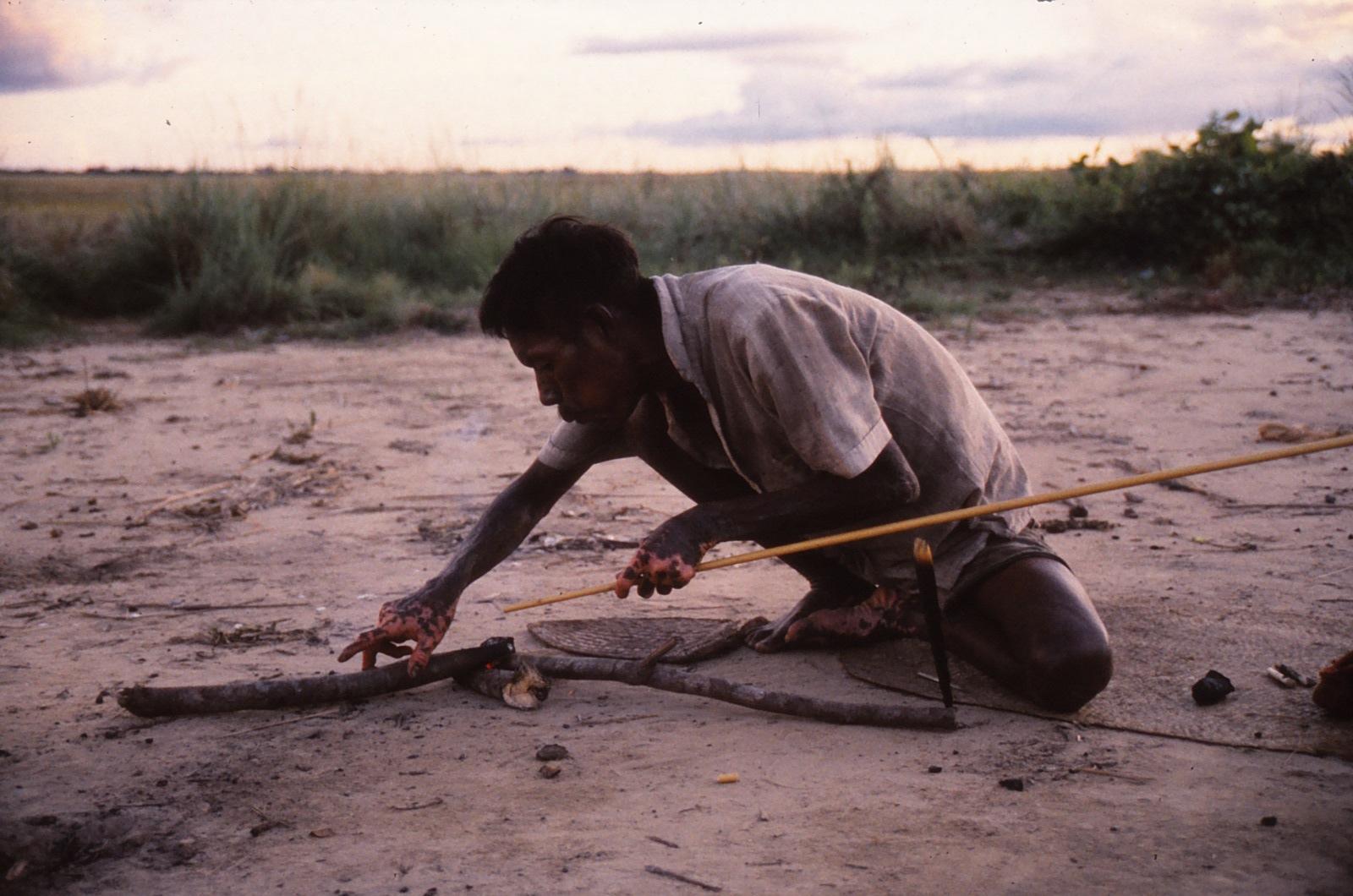
Same Pumé man in 1990 heating the nock end of the arrow (the narrow, distal-most portion of the arrowcane) in order to rub it with a stick of resin (the balks lump just to the viewer's R of his L knee on the sitting mat) so that he can attach the fletching and wind the nock. The 2 small "sticks" to the R of the resin are trimmed segments of arrowcane that are chewed to flatten them and are held together like tongs to rolls the windings with in order crush the bromeliad fiber windings and make them adhere well to the mainshaft, and also to rub the heated resin into the windings and furthersecure the windings.
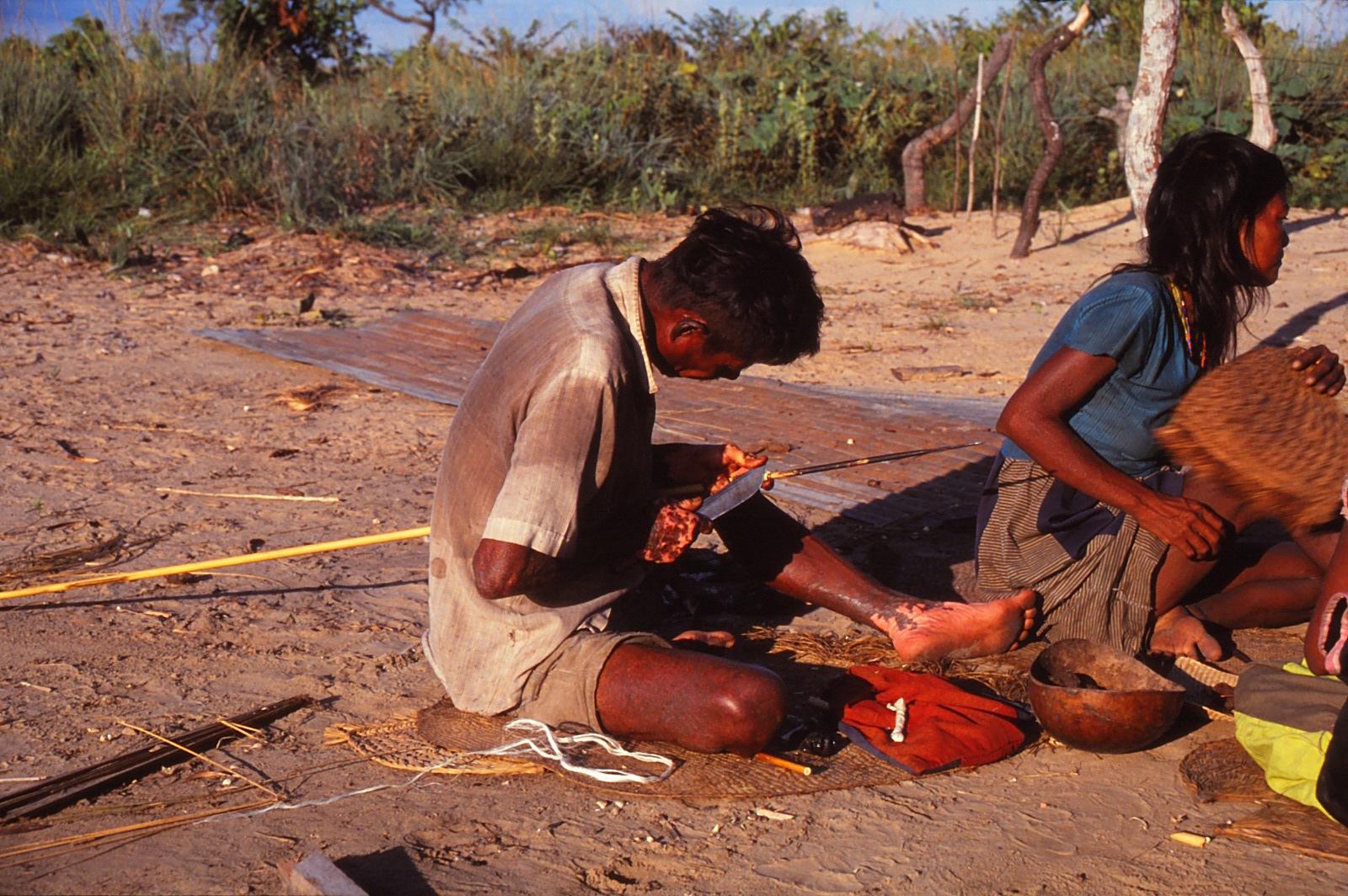
The same Savanna Pumé man in a different arrow making bout in 1993 trimming the foreshaft/mainshaft link with a knife (the foreshaft and point are visible to the R of his hands). A small skein of bromeliad fiber can be seen on top of the same red & blue cloth bag in front of him holding his arrow making gear and hallucinogenic snuff kit. The resin is seen just in front of his R knee, and one of the two small pieces of cane used to roll the windings is visible touching his R knee. Next to his R leg is some of the bromeliad fiber, pulled out of the skein to use in the various arrow making windings.
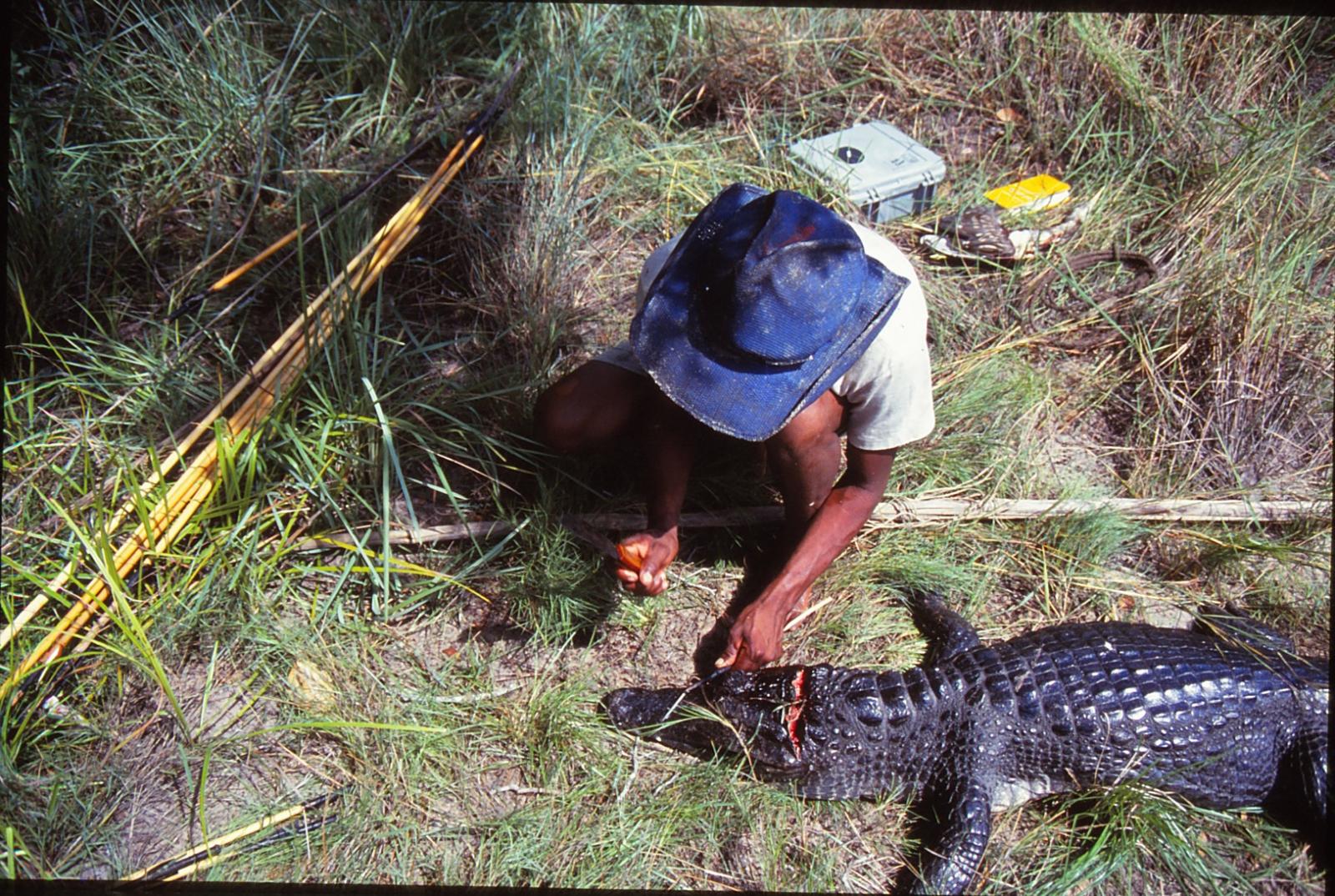
Savanna Pumé man repairing a bent point that also broke the foreshaft out of the mainsheet during the first attempts to capture this caiman, using the back of a knife and using the caiman snout as an anvil (out in the field during an overnight hunting trip in 1992). His bows and arrows are at the left in the image, and the proximal ends of another man's arrows can be seen in just the lowermost left corner of the image. The wooden pole in the front of the man is the caiman harpoon, the cordage (see the harpoon point & line used for this hunt in my 4th image on the post of 10 January, 2018 on the South American bows and arrows thread) can be seen tied along the length of the harpoon haft. There is a bird just in front of my yellow data notebook next to my camera case, and an extra length of cord in front of the bird that was brought along to tie game for the return to the residential camp.
0 -
Lmaas, thanks of the additional info about the nocks, and the additional photos. My comment about the possible configuration on foreshafts was just based on what I could see in the photos. There might have been foreshafts under the windings holding the points, but again it was not possible to determine that from the photos (except that it appeared the leister did not have evidence of one). As you suggest, the lack of foreshafts might indicate they are made for trade with non-indigenous folks, but a better determination of where they may be from may help determine why there don't appear to be foreshafts. The foreshaft is one of the more time consuming elements to fashion. Metal points (and prehistoric stone ones as well) have "hafts" of varying lengths and configurations (see the images in the 2nd photo of my post on 10 January, 2018 in the thread on "South American Bow and arrows" that you have already looked at ) that are the part that would be inserted into either or a foreshaft or directly into a mainsheet. The haft of the point is not considered a foreshaft because it is not a separate component of the arrow.
The points of the 2 fishing arrows with the straight points and marginal barbs (3rd & 4th from the L in your last picture of your 1st post) are square in x-section, are they not? With 4 rows of rows of barbs cut into each edge? I'm still thinking it is likely these may be boy's arrows (except for the longer leister) because of their shorter length than the leister. But, I'm still working with some references to see if I can provide any additional info. Potentially, the most distinctive characteristic of this set is the mid-rib of the lanceolate large game arrows, which is uncommon on most South American arrows I have worked with in my research.
I would again urge you not to replace the feathers. I mentioned that many arrows have problems with the fletching. While you may (or may not unless you have experience fletching arrows) be happy with how the kind of complete replacement you are pondering as "repair" may look, it would detract froth authenticity, which is a big part of the fun of having REAL artifacts on display. I recently performed the kind of repair I mentioned to you with beeswax on a 2 m-long arrow from the Aché foragers of Paraguay collected in the early 1990s with a nearly 1 m-long wooden foreshaft that also is the point (it is common in wooden-pointed arrows that the wooden point's proximal portion serves to be directly inserted into the mainshaft, not just in South American arrows). The fletching had come dis-attached at one end of this arrow, but by using a SMALL amount of beeswax I was able to reattach the feathers so they looked great (as with yours, they were only held down at the proximal and distal ends of the feather). I also used beeswax to hold down some of the vine windings around the foreshaft/mainshaft link (the Aché don't use resin on these kinds of monkey arrows with very long hardwood points that have a row of barbs, partly this allows the point to become detached so it remains in the monkey's body and continues to do harm, and the very sharp, backwards-facing barbs prevent the animal from being able to pull the point out without causing an even more grevious bleeding wound) that had become loose in the much drier climate over the years the arrows have been in the US. Both repairs kept the arrow in it's near-original condition as much as possible. I also had to use beeswax on an Efe bow (collected in the late 1980s from one of the groups of so-called "pygmies" of the Ituri Forest in the Congo Basin of central Africa) when the the bowstring was broken (my mother-in-law was allowed to open some of my artifact boxes, and of course she had no idea what she was opening, and damaged a few items). The bowstring is made from a strip of the outer epithelium ("bark) of vine, and was difficult to get to hold, but it is the most invisible & reversible fix I could do, and since it will never be whole again this helps prevent further damage and is not a glaring and inexpert repair.
The edit button exists for a bit more than a day I believe. It is located on the lower left, just outside the message to the right of the "Quote" button. It will disappear after a short while, but only after ~2 days, a moderator could state what the time frame is for this option.
0 -
While I was checking out comparative images for the Jordan, Hashemite Kingdom Order of Independence, I came across 2 other Jordanian minis on the Sixbid.com website:
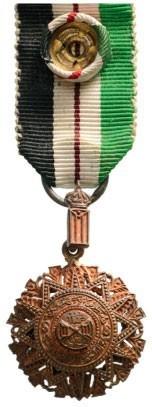
Jordan, Order of the Renaissance miniature (Order of Al Nadah), National Merit. Identified as the 4th Class, Officer's Cross, measuring 30 mm x 18 mm, bronze, unusual example in lacking any enamel (website calls it a "prototype"), and dating to 1948. From a 2016 auction by La Galerie Numismatique, archived own the Sixbid.com website: https://www.sixbid.com/browse.html?auction=3116&category=63949&lot=2606969
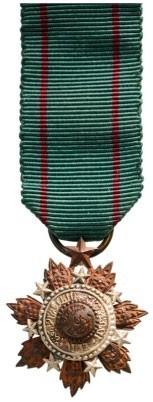
Jordan, Order of the Star miniature. Identified as the 4th Class, Officer's Cross. Dimensions = 21 mm x 18 mm, bronze, also an unusual example with no enamel (website calls it a "prototype"). From a 2016 auction by La Galerie Numismatique, archived on the Sixbid.com website: https://www.sixbid.com/browse.html?auction=3116&category=63949&lot=2606973
0 -
Here are a few more from the Spurlock Museum's Seymour and Muriel Yale Collection of Coins of the Ottoman Empire and Other Middle East States: The Museum also had an example of a full-sized Jordanian Hashemite Kingdom Order of Independence medal (mistakenly identified as a mini) that I have a question about at the end of this thread, and photos from other sources of some miniatures of the Order of Independence.
I
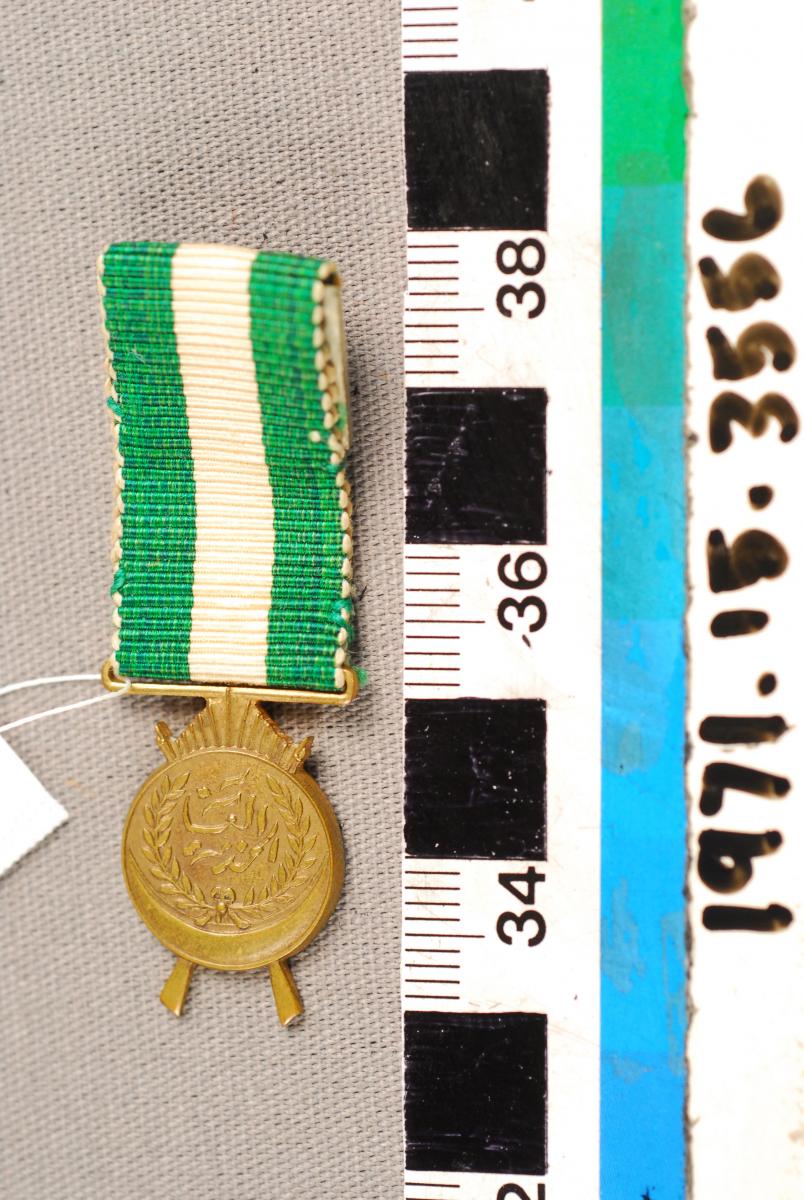 .
.
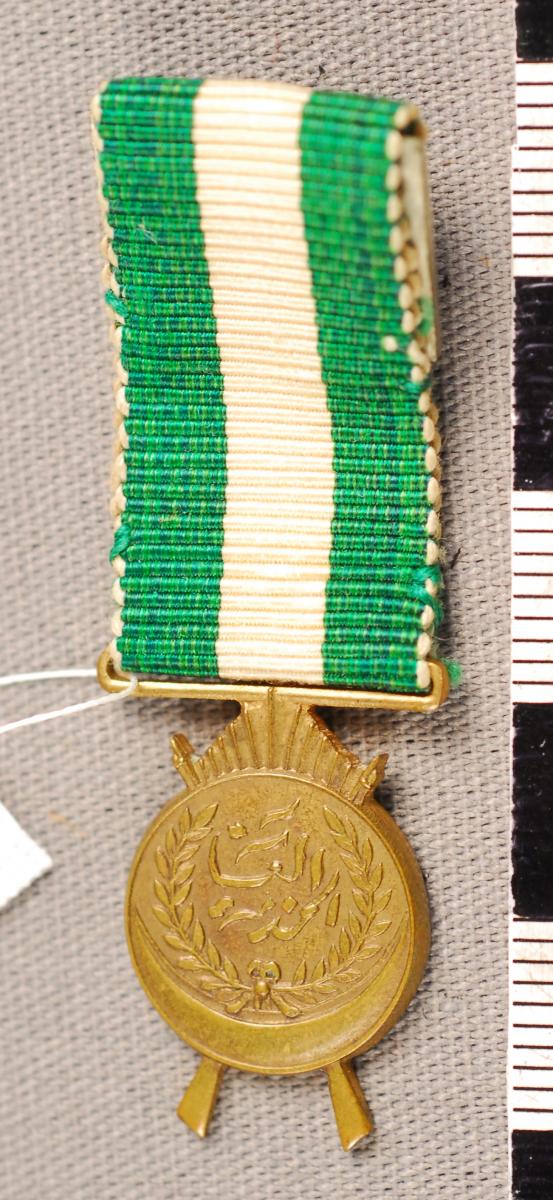
Obverse
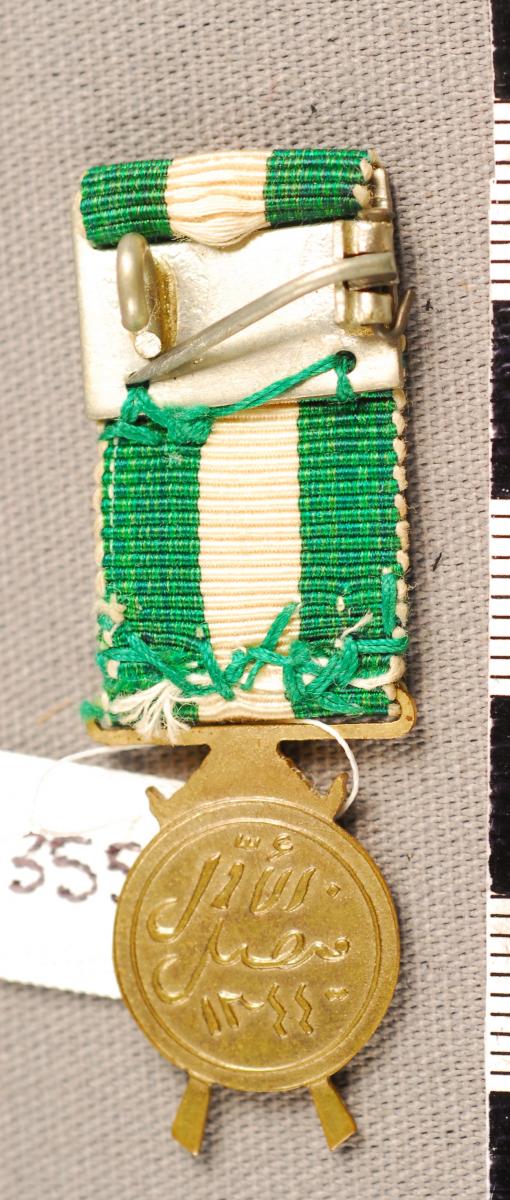
reverse
Iraq, Kingdom, General Service Medal miniature. Artifact identification #: 1971.15. 3556. (identified incorrectly in the catalogue as: "Libya, Order of Isrikal" [sic]). The "Length" (including the ribbon)=5.1 cm; "Width" (the maximum width of the medal)=1.4 cm; & "Width" (the maximum width of the ribbon)=1.5 cm ; Weight=2.0 g. https://www.spurlock.illinois.edu/collections/search-collection/details.php?a=1971.15.3556
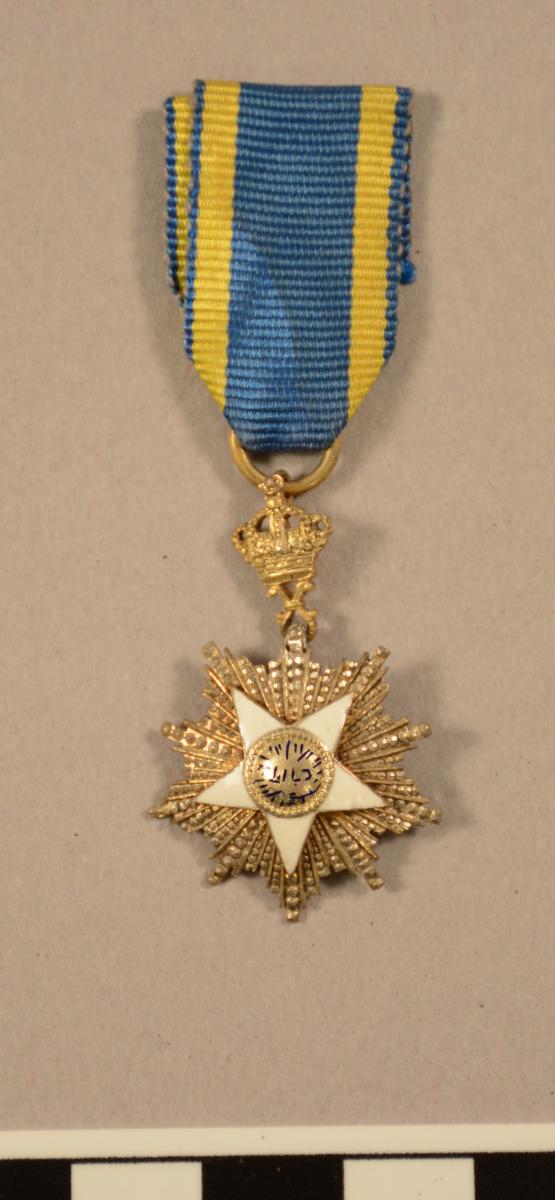
Obverse
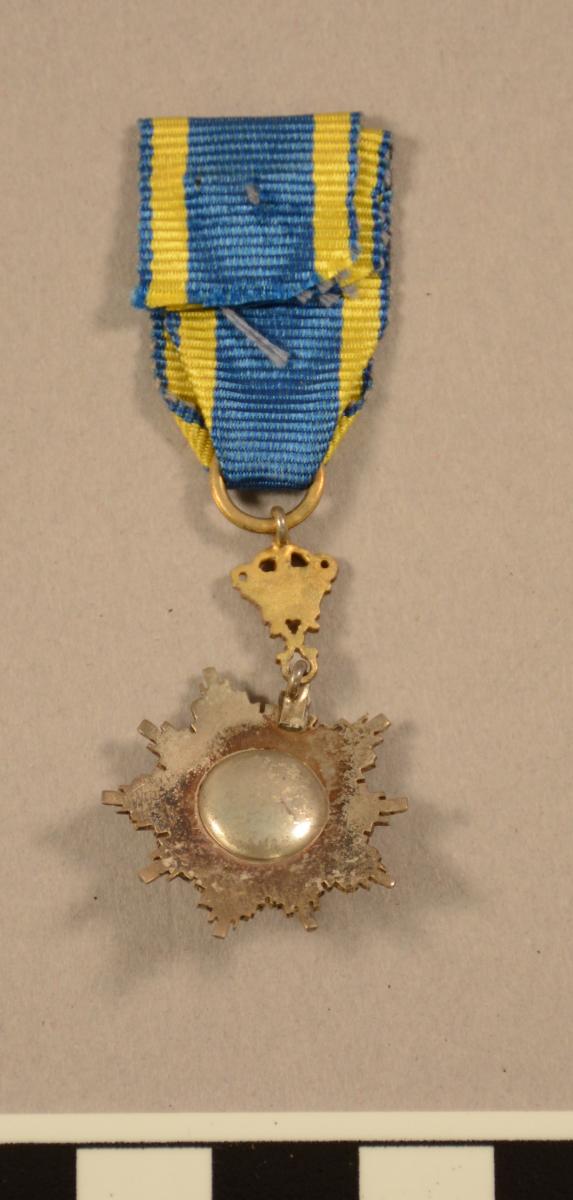
Reverse
Egypt, Order of the Nile miniature. Artifact identification #: 1971.15. 2899. "Height" =6.17 cm; Diameter=2.15 cm; Depth=0.52 cm; Weight=5.41 g. https://www.spurlock.illinois.edu/collections/search-collection/details.php?a=1971.15.2899. The larger "mugshot" original photo for this Order of the Nile mini from the Spurlock Museum was too large to easily upload here.
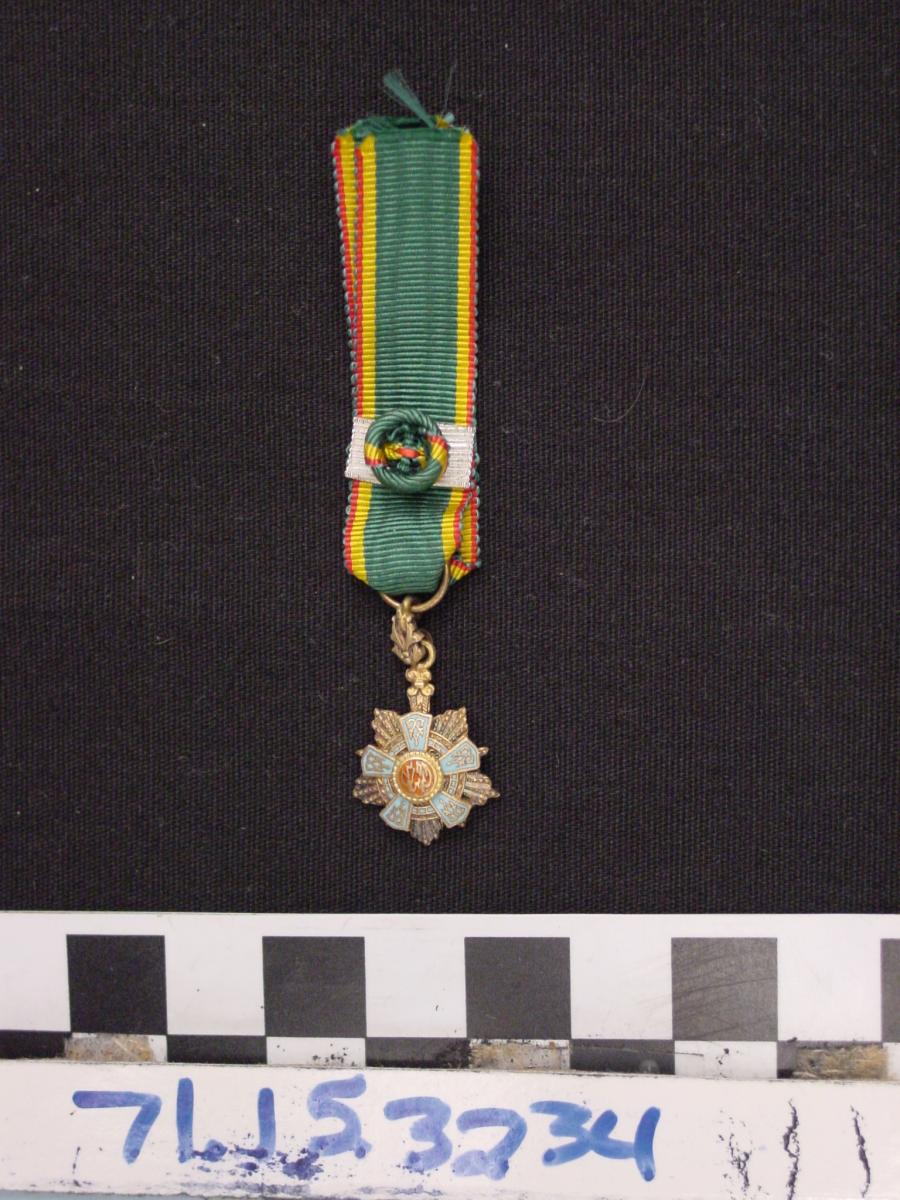
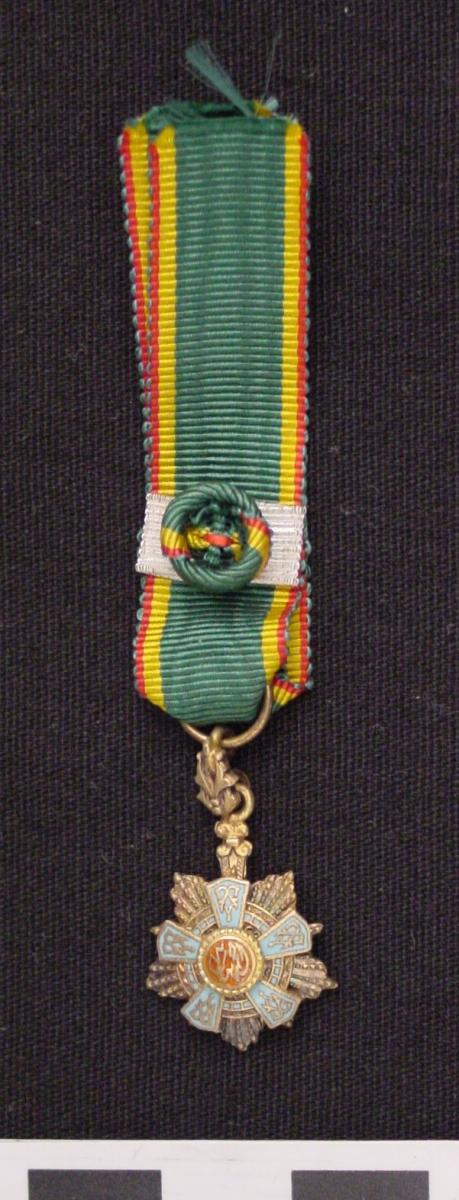
Egypt, Order of the Republic miniature, 3rd Class. Artifact identification #: 1971.15. 3234. (identified incorrectly in the catalogue as: "Egypt, miniature Victory Star"). The silver galon indicates this is the 3rd Class of this award. This is a Type I example with the lily suspension device and the lighter blue color enamel on the embellished 5 rays & enameled ring round the central medallion. "Length" (including the ribbon)=7.1cm; "Width"=1.1 cm; "Height"=0.4 cm; Weight=3.48 g. https://www.spurlock.illinois.edu/collections/search-collection/details.php?a=1971.15.3234
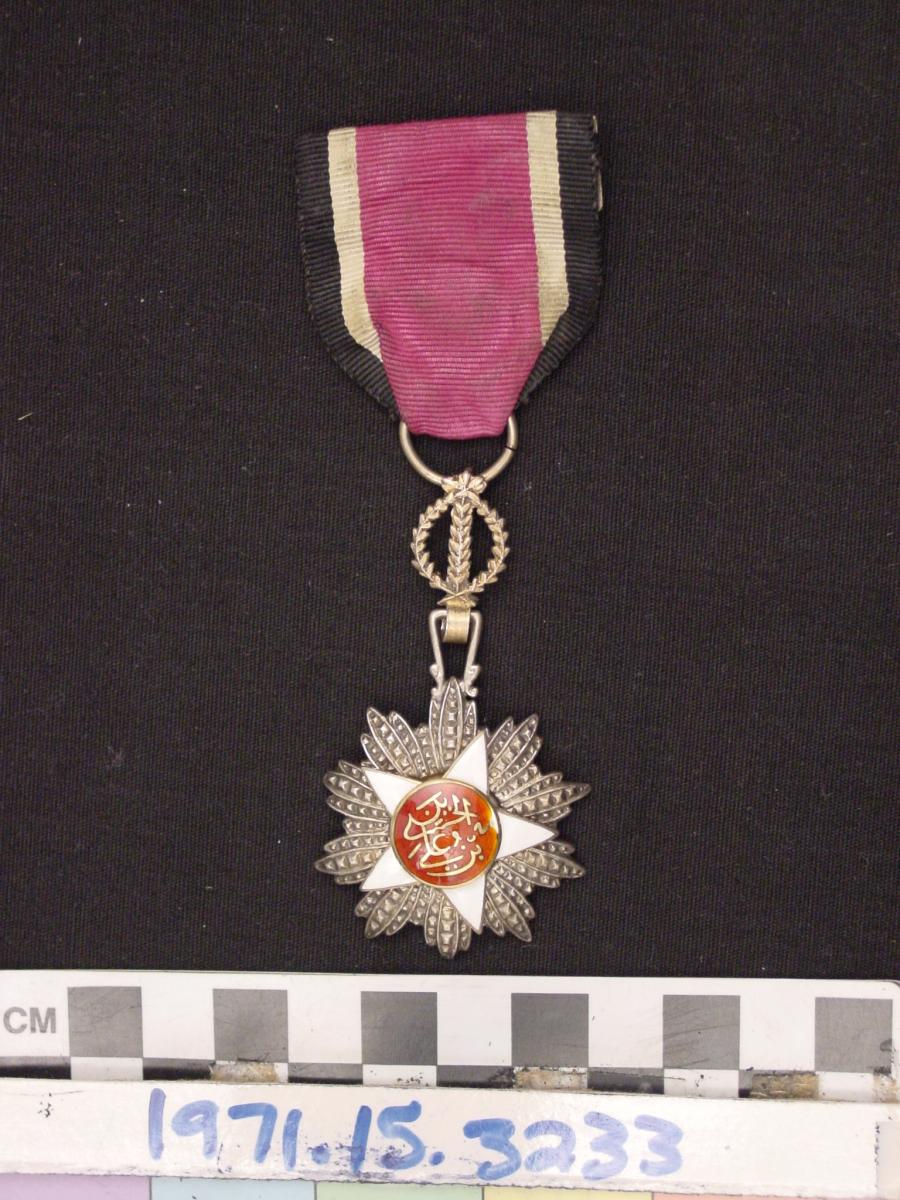
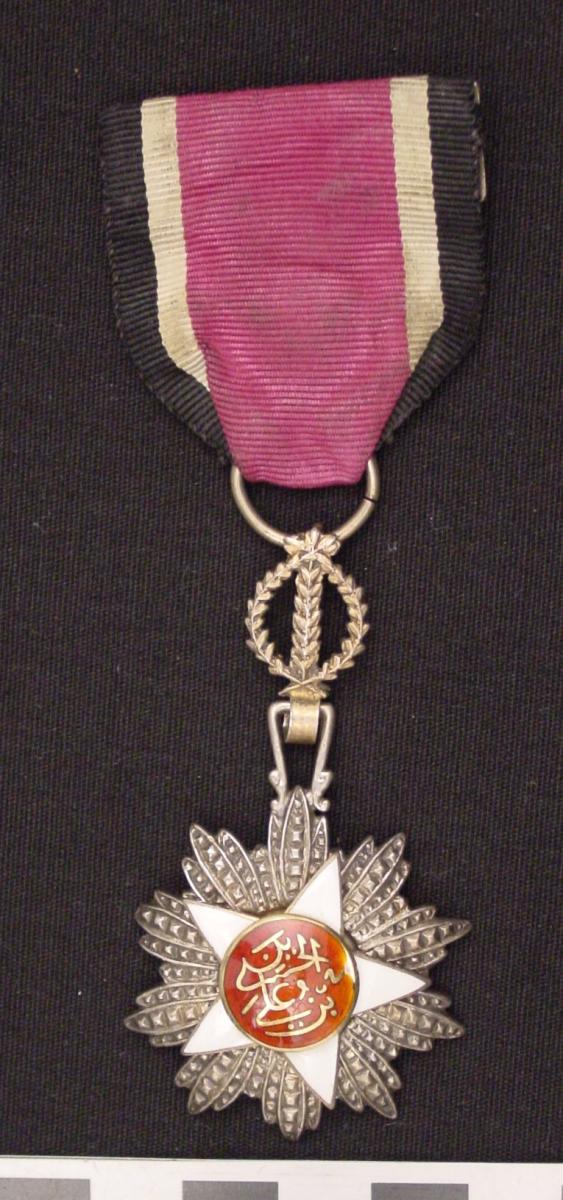
Jordan, Hashemite Kingdom, Order of Independence (Wisam al-Istiklal (Istiqlal). Artifact identification #: 1971.15. 3233. (identified incorrectly in the catalogue as: "Iraq, miniature Victory Star"). The size and weight of this indicates this is probably a full-sized version of this medal, not he miniature. "Length" (including the ribbon)=11.4 cm; "Width" =4.9 cm; "Height"=1.1cm; Weight=30 g. It appears that this form without the gold wreath above the silver-rayed embellishment and underneath the 5-armed white enameled star, surrounding the central medallion with the cipher of Al-Hussein ibn Ali is the design for the 5th Class Knight version of this award. I believe that all illustrations of this Order on GMIC show classes with the gold wreath embellishment of higher classes. Other examples without the gold wreath are shown at: https://www.the-saleroom.com/en-gb/auction-catalogues/spink/catalogue-id-srspi10167/lot-8fe6bc71-f7cf-47c8-b33f-a8bd0111c0c7, identified as a 5th Class chest badge; http://www.najafcoins.com/Wor_Med_Ord_JKL.htm, identified as a Knight Class; 2 examples with contrasting designs that lack the wreath are shown at https://www.the-saleroom.com/en-us/auction-catalogues/dixnoonanwebb/catalogue-id-dix-no10035/lot-62b85175-32ec-467e-9443-a75100f2c5c5, identified as 5th Class; a boxed set at https://www.sixbid.com/browse.html?auction=3116&category=63949&lot=2606978 that is identified as a 5th Class made by Huguenot of Switzerland that includes a miniature (shown in the 1st photo below). I have seen a couple examples of the full-sized award with the gold wreath identified as 5th Class (i.e., this example from Medal-Medaille: http://www.medal-medaille.com/sold/product_info.php?cPath=498_72&products_id=10590&osCsid=muk09a44arnp40psc96vkkuqa1), but of course there can be ID mistakes on these sites. I wonder if someone more knowledgable about this award could confirm whether the medal without the wreath is the 5th Class Knight's versions of this award?

Boxed set identified as the 5th Class Knight's Cross version of the Jordan,Order of independence showing the lack of the gold wreath around the central medallion for both the full-sized and miniature chest badges. From a 2016 La Galerie Numismatique auction archived on the Sixbid.com website (https://www.sixbid.com/browse.html?auction=3116&category=63949&lot=2606978). The full-sized medal measures 67 x 42 mm, no dimensions are given for the miniature, this set is made by Huguenin, Switzerland.
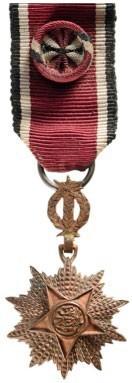
Unusual example identified as a miniature of the Jordan, Order of Independence 4th Class, Officer version measuring 30 x 19 mm. Bronze with no enamel (website calls it a "prototype") from a 2016 La Galerie Numismatique auction archived on the Sixbid.com website (https://www.sixbid.com/browse.html?auction=3116&category=63949&lot=2606977). The rosette with no galon suggests this is 5th Class mini.
I do not know if this example of the Order of Independence without the gold wreath from the Najaf Coins & Collectibles website may be a miniature or not. No dimensions or other information is provided in the brief description. However, the workmanship of the silver embellishment and the suspension device suggests this may be a mini. http://www.najafcoins.com/Wor_Med_Ord_JKL.htm and http://www.najafcoins.com/Images/o3744.jpg
Two miniatures of the Jordan Order of Independence from a 2018 auction by Spink & Son archived on The Salesroom website (https://www.the-saleroom.com/en-gb/auction-catalogues/spink/catalogue-id-srspi10167/lot-777aa81d-43b8-4110-a94d-a8bd0111be2a). Although they are not identified as miniature on the auction description, the size, lack of detail in the casting, and design variations of the suspension devices all indicate these are miniatures. No class identified, the sizes are identified as "27 x 18 mm and 22 mm".
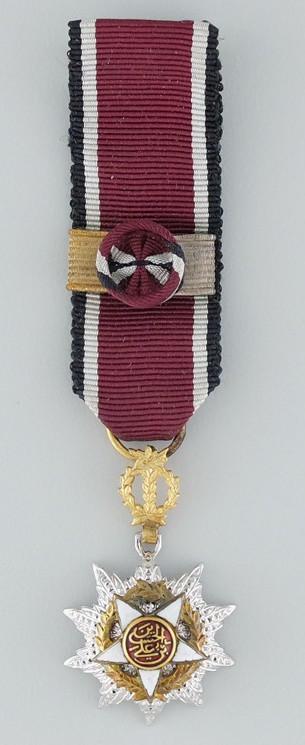
Jordan, Order of Independence 2nd Class Commander miniature from a complete boxed set of the neck badge (41 x 65 mm), breast star (82.8 x 87.5 mm), miniature, and rosette. The gold & silver galon is correct for the 2nd Class. This miniature measures 18.8 mm x 31 mm, is silver gilt, and made by Arthus Bertrand of Paris. This example is from a previous eMedals auction (https://www.emedals.com/middle-east/jordan/a-french-made-order-of-independence-al-istiklal-commander-s-set-w2007).
0 -
Paul, I am most grateful for your kind words and interest in this fun string that Owain set up. In relation to the Order of Ismail and the Abbas Hilmi II Commemorative Medal, they are still in the family. No one has seen the Mixed Courts Judges' Badge that Judge Pierre Crabitès would have worn when he sat in Court in Cairo, and occasionally on the circuit to Mansourah and Port Said.
Currently in relation to this thread, I'm just stumbling into images of minis to just throw in here. I know very little about any of the full-sized awards these represent, other than some of the Egyptian ones. Of course. all of these medals are covered in-depth in other threads here, principally in this "Middle East & Arab States" section identified as "Arab Medals -- X-County Name", with fabulous info about the full-sized medals, but also many pictures of additional variation in the forms of these and many other miniatures.
I found a few probably quite common miniature examples in an online American museum catalog through an image door onto the website (the search features weren't working to find objects whose names were associated with images I could pull up) of the Spurlock Museum of World Cultures, in illinois (https://www.spurlock.illinois.edu). All of the medals illustrated below come from the Seymour and Muriel Yale Collection of Coins of the Ottoman Empire and Other Middle East States. The Spurlock Museum of World Cultures mugshots below give the full Artifact Identification #, and then a cropped version still taking advantage of the scale (in CM).
Libya, Order of Independence miniature. Artifact Identification #: 1971.15.3555. The "Length" (including the ribbon)=7.9 cm; "Width" (the maximum width of the medal)=1.5 cm; & "Width" (the maximum width of the ribbon)=1.1 cm ; weight=2.0 g. (https://www.spurlock.illinois.edu/collections/search-collection/details.php?a=1971.15.3555)
Syria, Order of Civil Merit miniature. Artifact Identification #: 1971.15.3235. "Length"=6.7 cm; "Width"=1.4 cm; "Height"=0.1 cm; Weight=2.18 g. https://www.spurlock.illinois.edu/collections/search-collection/details.php?a=1971.15.3235
Iraq Victory Medal. Artifact identification #: 1971.15.2072. (Identified incorrectly in the catalogue as from Saudi Arabia, the Medal of "Hussein Ibn Ali of Hejaz"). Diameter=1.82 cm; Width=o.23 cm; Weight=3.79 g. https://www.spurlock.illinois.edu/collections/search-collection/details.php?a=1971.15.2072
0 -
I recently found this additional example of a different first day postal cover envelope design for the abolition of the Egyptian Mixed Court system on 14 October, 1949. This French language version that is postmarked from Cairo is from a September 2018 UK eBay auction (https://www.ebay.com/itm/EGYPT-1949-MIXTES-FDC-/283142086028?nordt=true&orig_cvip=true&rt=nc&_trksid=p2047675.m43663.l44720).
I recently obtained a higher resolution image of Judge Pierre Crabitès in his judicial regalia, taken in ~1911 at the beginning of his appointment to the Mixed Courts' District judiciary in Cairo. This is a better image than that at the beginning of this thread, although it does not show the judicial badge as well as other images I've posted here. It does show some of the contrast between the areas of the badge design that are gold gilt and the silver portions of the District Court judges version of this badge, although not in enough detail to help address the question I have about the badge depicted in the first photo of my first post of 31 October, 2018 on this thread. This image derives from a photo in the morgue of the New Orleans Times Picayune, first brought to my attention when I found a 21 February, 2010 re-publication of the photo archived on the Times Picayune website. Judge Crabitès was from New Orleans, and he featured periodically in several human interest local society page stories. That article reprinted a synopsis of parts of a 1924 article outlining Judge Crabitès role as the presiding judge in a case brought by Howard Carter, the discoverer of the tomb of Tutankhamen, against the Egyptian government over his objections to certain conditions of his excavation permit and requirement to host large numbers of visitors that he felt seriously interrupted his scientific recovery of the tomb contents, as well as a brief recapping of his later career as a lecturer at Lecturer at Louisiana State University, and 1943 death in Baghdad.
0 -
I am not a collector, none of these are items I own. I joined this site to find out more about the Order of Ismail that my wife's great grandfather was awarded (2nd Class, Grand Officer), probably at the end of his term in 1936 as a District Court Judge in Cairo on the International Mixed Courts. I also have been researching a table medal (probably struck in 1910) he obtained commemorating the anniversary of the coronation of Abbas Hilmi II and his return form his pilgrimage to Al Medina & Mecca. The GMIC participation has also led me into some other fun avenues, such as periodically contributing to this thread that Owain set up in response to some questions I had about miniatures of the Order of Ismail. I am providing the sources of the images I include because I do not own any of these items and want to provide credit for these photos. I just come across them in some of the research I'm doing on the family pieces from Egypt, the Egyptian Mixed Courts, and trying to educate myself about this time period.
0 -
Yes, I was lucky on that one! However, being an anthropologist is often about being able to handle my endless ignorance & stupidity in relation to the profound knowledge of the folks I work with. As I've mentioned here, asking children's questions ("Why do you do that?" regarding things that any adult should know, and getting the "Because that's what we do!" answer) or doing dumb things (such as my lightning story above) is a useful zen exercise in humility and reminder that I may have book learning about things, but fieldwork is needed to have real hunters & gatherers show us what our scholarship has not yet addressed. You have to be able to laugh at yourself (along with the folks you work with), as well as with realizing you are privileged to be learning from these fabulous people, not studying them.
One of the most wonderful Pumé men I have had the privilege to work with looking at cattle ranch encroachment on the savanna areas in Venezuela they use for hunting, fishing, and root collection as well as locations where raw materials are gathered for their technologies.
And to add at least some contribution about collecting, this is one of the dance rattles I was given that is now in my extensive material culture collection at the University of Pennsylvania Museum of Archaeology & Anthropology (Greaves Collection 96-1-1002). I used this rattle for my first year with the Pumé when I attended the all-night 11 hour-dances the Pumé hold ~ 37-52% of all nights I've been in residence (I got a different one for my personal use during my second year, and then 3 others in subsequent visits, in addition to several I obtained just for the UPENN collection). The man pictured above is one of the most accomplished singers, who improvised astonishingly beautiful melodies with complex rhythms when he led the community dances (tohé). He also occasionally developed the most complicated dance moves for us to follow, causing some really hilarious moments for folks used to mostly just running around the pole in the center of the dance plaza all night. This man was the primary curer in the community and used his skills in "spirit possession" during theses dances to get outside himself in the personae of "spirits" or recent ancestors from the Camps of the Dead to speak about about particular social or political issues that needed to be mooted by the camp members. This is not superstitious mumbo-jumbo as has been perpetuated by many anthropologists, but a very smart way of speaking truth at these public events without the arrogance of it just appearing to be the opinion of one influential man in camp. I've been called up to talk with spirit mouthpieces as well as one of my Pumé "fathers" and my biological dad, conjured from the Camps of the Dead several times at these dances for up to 45 min. He strategically got me involved in this form of question & response oratory when he felt it was necessary to remind the camp or visitors of a number of things that I had done to help the community or to guide my understanding to assist in other ways to make their wishes known to the outside world. Anthropologists needs a role with the folks we work with other than that of "professional dolt" interested in what they do (I'm not much good at subsistence activities or making their tools compared with their skills, however I do bring a lot of medicine and provide basic medical attention), I was included in these spirit interrogations so that I could use my unique skills to be their voice when I went to town. Unlike the Savanna Pumé, I could speak Spanish and visit the politicians and indigenous affairs board to try and make their wishes known about how they wanted to direct their own future as they navigate the ways the globalized world touches them. Using these 3-4 times-a-week public dances to discuss a range of practical subsistence issues (where people have found game, fish, roots, fruits, or useful raw materials), get information from visitors about distant kin in other places and other events happening in the region (including what the non-Pumé criollos are put to), and let everyone weigh in on the current issues, as well as have fun singing, dancing, smoking, taking dope, and laughing together all night is not just myth & ritual. This isn't "religion" in the way some anthropologists insist it is just about supernatural popadoodle. This is community engagement in discussing the news & needs of the day. We know that participation in rhythmic activity increases the willingness to cooperate with others (even when we don't really like all those people), not just from current psychology experiments, but looking also at the military use of music & synchronized movement going back thousands of years. This is a really impoverished environment, and the Pumé continue to be hunters & gatherers into the 21st century because of extensive cooperative behaviors. Cooperation is an absolutely key adaptation to how all humans have become so much more numerous than any other great ape and successfully colonized all areas of earth without the biological speciation that characterizes other animals (although a certain number of my anthropologist colleagues prefer to emphasize human warfare & violence, in my opinion a retread of an apologist perspective common in the 1950s-60s as part of the post-WWII attempts to find allegedly scientific explanations for some of the most inhumane atrocities of that war by claiming violence is just part of innate human nature, well displayed in the adoption of the writer and avocational anthropologist Robert Ardrey's popular treatments of some early thinking about human violence that made a cinematic debut in the iconic depiction of marauding australopithecines in the 1968 film - 2001: A Space Odyssey).
Close-up of this Pumé rattle decorated with images of men & women in the dance lines. Stylized rattle tassels can be seen between the linked arms of some figures that represent the rattles that only men use during these dances. This is their only musical instrument, other than the beautiful voices of men & women singing solos & chorus refrains for hours under the thick tapestry of stars & a galaxy, through the pre-dawn synchronized flashing of the lighting beetles, and resting as Venus reached a particular azimuth, just before sunrise.
0 -
Above are 2 examples of miniatures of the Egyptian Order of Ismail from a recent 2018 auction of La Galleria Numismatique, featured on the Sixdbid.com website. On the L is a 3rd Class Commander grade of this mini, indicted by the rosette and silver galon (https://www.sixbid.com/browse.html?auction=5367&category=168960&lot=4479891). It is identified as 30 mm tall by 20 mm wide and made of silver. On the L is a 4th Class Officer mini, indicated by the rosette and lack of a galon (https://www.sixbid.com/browse.html?auction=5367&category=168960&lot=4479892). This Officer Class mini also is identified as silver and measuring 30 mm tall and 20 mm wide. Both of these appear to be older miniatures, comparable to the examples I illustrated on this thread in the photo on 5 December 2017; and on the thread "Miniatures of the Middle East & Arab World" started by Owain on 6 December 2017: my post of 11 Decemebr 2017, and that Owain shows in his post there (upper row 2nd from R) of 11 December, 2017 (and the reverse of that mini in his 1st photo on the post of 12 December 2017 in the "Miniatures..." thread, also upper row 2nd from R). The two minis above and the ones I listed as comparable are different from what appears to be a more recently manufactured version I illustrated here in the 1st photo on 6 December, 2017 (on the R) that lacks the Khedival crown as part of the suspension device and is associated with the somewhat unusual mini in the L of that photo with very abbreviated design based on the sash badge (1st Class, Grand Cordon) and neck badge (2nd Class, Grand Officer along with a chest star; and 3rd Class Commander that has a neck badge only as the full-sized regalia). The configuration of the 3rd Class mini above contrasts with the example I illustrated here on 16 October, 2018 that has a rosette and silver galon, that made me wonder whether the 3rd Class mini might more appropriately be the neck badge form. Rather than representing different medal forms for different classes, these appear to show that older miniatures of the Order of Ismail (likely from before it was discontinued in 1952) are distinctly different from those that probably date even much more recently than 1952 termination of this official state award (except as "royal exile" awards as discussed by 922F on 5 December 2017 in this thread). It appears all of the clearly older forms of the mini employ the design of the chest star for this order, and several more recent miniatures Order of Ismail medals use the sash badge/neck star design (shown on the 1st photo of 6 December, 2017 in this thread; the oddly configured modern piece in the 3rd photo on 6 December, 2017 from falera-et-orbis.com inventory of "in-stock" minis; and the inexpensive eBay example in the 4th photo from my 6 December, 2017 post that was manufactured in 2015, as well as that shown on 16 October, 2018).
Another example of the miniature of this Order with the chest star configuration is shown in a listing on acsearch.info from a 2016 auction by Auktionhaus H. R. Rauch (top set obverse shown on far R; reverse shown on top L far L; and the obverse again in the bottom image in the case on the far R) (https://www.acsearch.info/search.html?term=Egypt&category=4&en=1&de=1&fr=1&it=1&es=1&ot=1&images=1&thesaurus=1&order=0&currency=usd&company=) along with 10 other miniatures on a chain. The resolution of those illustrations is too poor for any meaningful detail of that Order of Ismail miniature medal or any of the others on that same chain, but is shown below simply as another example of this form of the Order of Ismail mini.
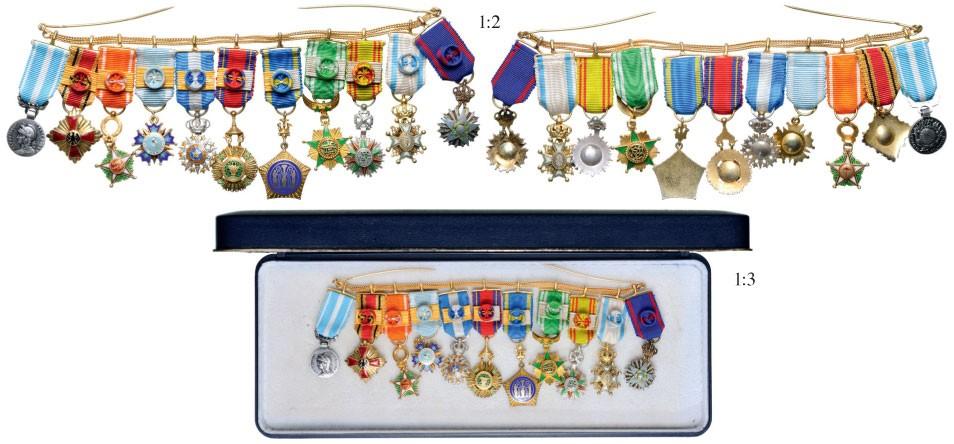 0
0 -
The first photo below is of another miniature of a Republic of Egypt Order of Independence (Nisah al-Istiklal) from a 2014 auction by H. D. Rauch (lot 4682), archived on the acsearch.info website (https://www.acsearch.info/search.html?term=Egypt&category=4&en=1&de=1&fr=1&it=1&es=1&ot=1&images=1&thesaurus=1&order=0&currency=usd&company=).
No dimensions or manufacturer is specified for this Republic of Egypt Order of Independence miniature. This example (above) shows some differences from other miniatures of this medal I Illustrated on this thread in the 1st photo on 25 April, 2018 and in the 1st photo on 30 July, 2018. The example above notably lacks the dots present in the outer white and blue margins of the central medallion of both of the previously illustrated examples.
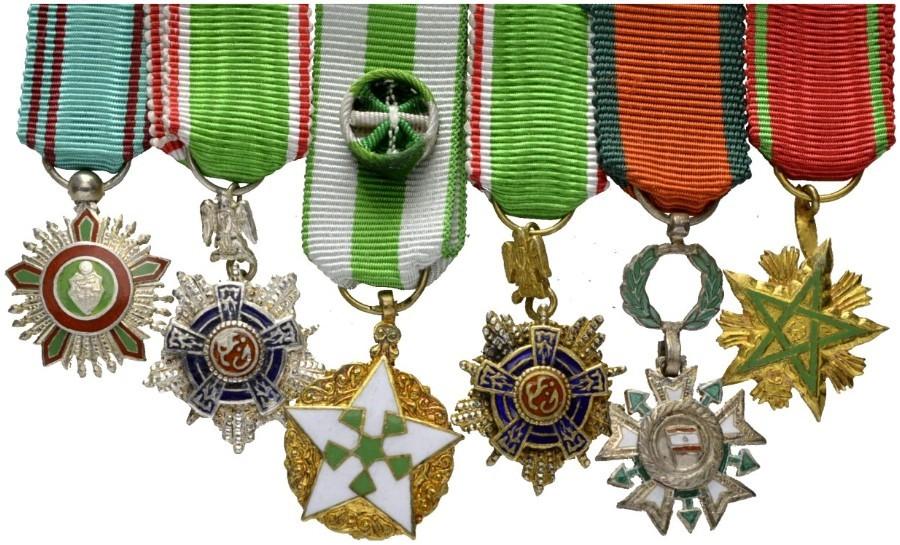
The image above shows a group of 6 miniatures from a 2014 auction by H. D. Rauch (lot 4682), also archived on the acsearch.info website (https://www.acsearch.info/search.html?term=Egypt&category=4&en=1&de=1&fr=1&it=1&es=1&ot=1&images=1&thesaurus=1&order=0&currency=usd&company=). This group includes, from L to R, Tunisia: Order of the Republic; Egypt; Order the Republic, Syria; Order of Civil Merit; a second example of the Egyptian Order of the Republic; Lebanon: National Order of the Cedar; and Morocco: Order of the Throne.
Above are 2 examples of miniatures of the Egyptian Order of Ismail from a recent 2018 auction of La Galleria Numismatique, featured on the Sixdbid.com website. On the L is a 3rd Class Commander grade of this mini, indicted by the rosette and silver galon (https://www.sixbid.com/browse.html?auction=5367&category=168960&lot=4479891). It is identified as 30 mm tall by 20 mm wide and made of silver. On the L is a 4th Class Officer mini, indicated by the rosette and lack of a galon (https://www.sixbid.com/browse.html?auction=5367&category=168960&lot=4479892). This Officer Class mini also is identified as silver and measuring 30 mm tall and 20 mm wide. Both of these appear to be older miniatures, comparable to the examples I illustrated on this thread in the 1st photo on 6 December 2017, my post of 11 Decemebr 2017, and that Owain shows in his (upper row 2nd from R) on his post here of 11 December, 2017 (and the reverse of that mini in his 1st photo on the post of 12 December 2017, also upper row 2nd from R). The two minis above and the ones I listed as comparable are different from what appears to be a more recently manufactured version I illustrated in the 2nd photo on 6 December, 2017 (on the R) that lacks the Khedival crown as part of the suspension device and is associated with the somewhat unusual mini in the L of that photo with very abbreviated design based on the sash badge (1st Class, Grand Cordon) and neck badge (2nd Class, Grand Officer along with a chest star; and 3rd Class Commander that has a neck badge only as the full-sized regalia). The configuration of the 3rd Class mini above contrasts with the example I illustrated here on 16 October, 2018 that has a rosette and silver galon, that made me wonder whether the 3rd Class mini might more appropriately be the neck badge form. Rather than representing different medal forms for different classes, these appear to show that older miniatures of the Order of Ismail (likely from before it was discontinued in 1952) are distinctly different from those that probably date even much more recently than the 1952 termination of this award (except as "royal exile" awards as discussed by 922F on 5 December 2017 in the thread I started: "Question about the Order of Ismail/Nishan al-Ismail" on 7 November, 2017 here in the Middle East & Arab States section). It appears all of the clearly older forms of the mini employ the design of the chest star for this order, and several more recent miniatures Order of Ismail medals use the sash badge/neck star design (shown in this thread on the 2nd photo of 6 December, 2017; the oddly configured modern piece in the 4th photo on 6 December, 2017 from falera-et-orbis.com inventory of "in-stock" minis; and the inexpensive eBay example manufactured in 2015 in the 5th photo from my 6 December, 2017 post, as well as that shown on 16 October, 2018).
0 -
A current eMedals auction is offering a Republic era example of the 1st Class Grand Cross version of this award from ~1975. Given the interest in the beauty of this award, I hope folks enjoy the photos from their auction site of the Iraq Republic form of this. I'm also copying their description of this set and the historical information (https://www.emedals.com/iraq-republic-an-order-of-the-two-rivers-i-class-grand-cross-civil-division-c-1975):
Iraq, Republic. An Order of the Two Rivers, I Class Grand Cross, Civil Division, c.1975Wisam Al Rafidain. Instituted in 1959 and based on the Kingdom's Order of the Two Rivers. Badge: in gilt metal with red, white, blue and green enamels, measuring 62.5 mm (w) x 95.7 mm (h) inclusive of its ball and integral ring suspension, missing its ball finial at the 9 o'clockposition, on its original full-length sash; and Breast Star: insignia in gilt metal with red, white, blue and green enamels, mounted to an eight-pointed gilt metal star base, measuring 84 mm (w) x 84 mm (h), vertical pinback flanked by dual stays, scattered gilt wear on the base. Near extremely fine. In its hardshelled case of issue, award insignia and classification marked on the lid, exterior of the lid and base each trimmed in two strands of silvered beaded threading on three sides, raised platform with recessed metal beds for both awards, slight separation evident in the exterior fabric where the rear panel meets the base, case also near extremely fine.
Footnote: The Order of the Two Rivers (Wisam Al Rafidain) was an order awarded by the Kings of Iraq and then the Presidents of Iraq. It was established in 1922 by King Faisal I "For Merit" and named after the two rivers, the Euphrates and the Tigris, that flow through the middle of the country. The Order was initially awarded by the Kings of Iraq between 1922, when the monarchy was established, and 1958 when the monarchy ended. It was continued by the Presidents of Iraq through the 1960s, 1970s and 1980s. It was awarded in two divisions, Military and Civil, initially issued in four classes: 1st, 2nd, 3rd and 4th, along with a medal. On May 24, 1959, the Order (now known as Wisam Al Rafidain) was awarded " For exceptional service to Iraq", now issued in five classes: 1st, 2nd, 3rd, 4th and 5th.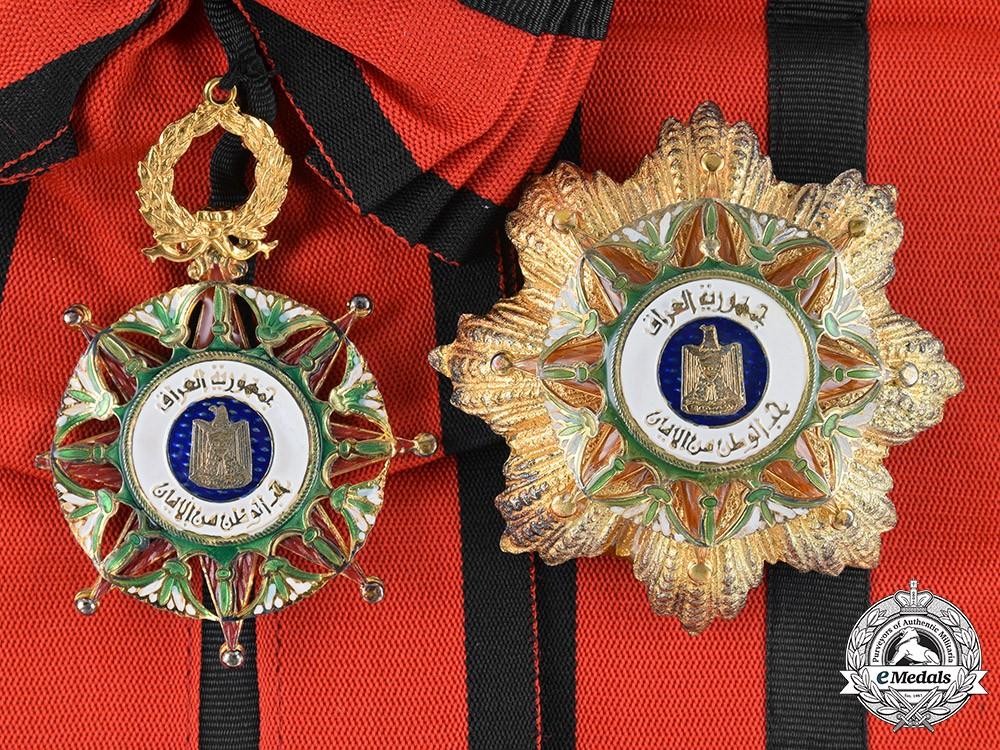 Sash badge and chest star
Sash badge and chest star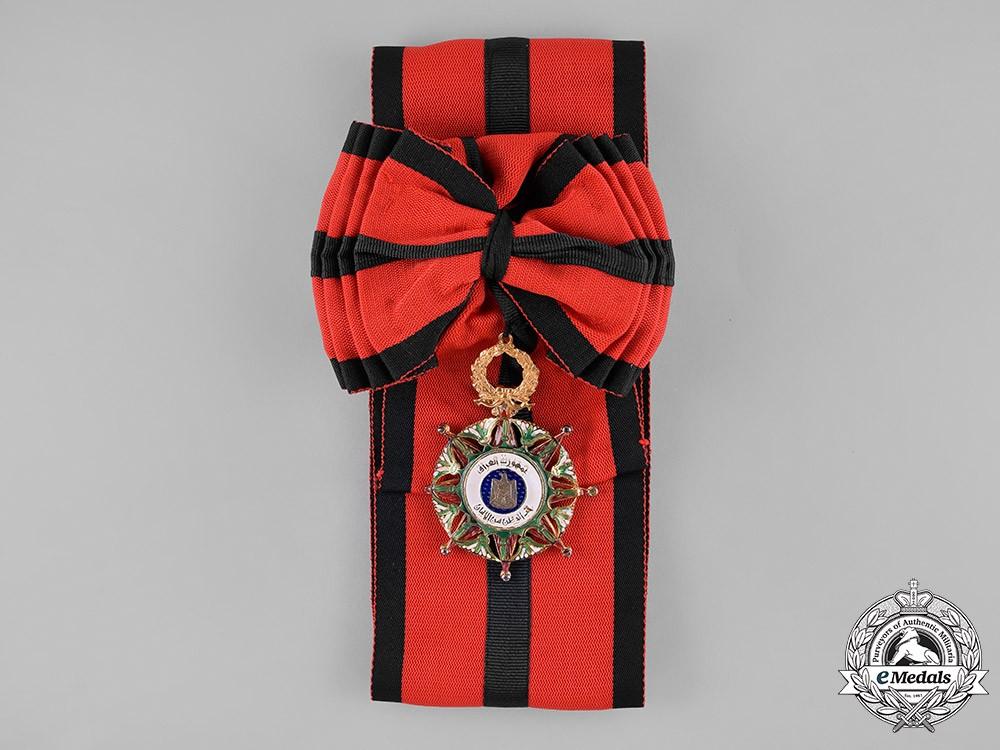 Sash badge
Sash badge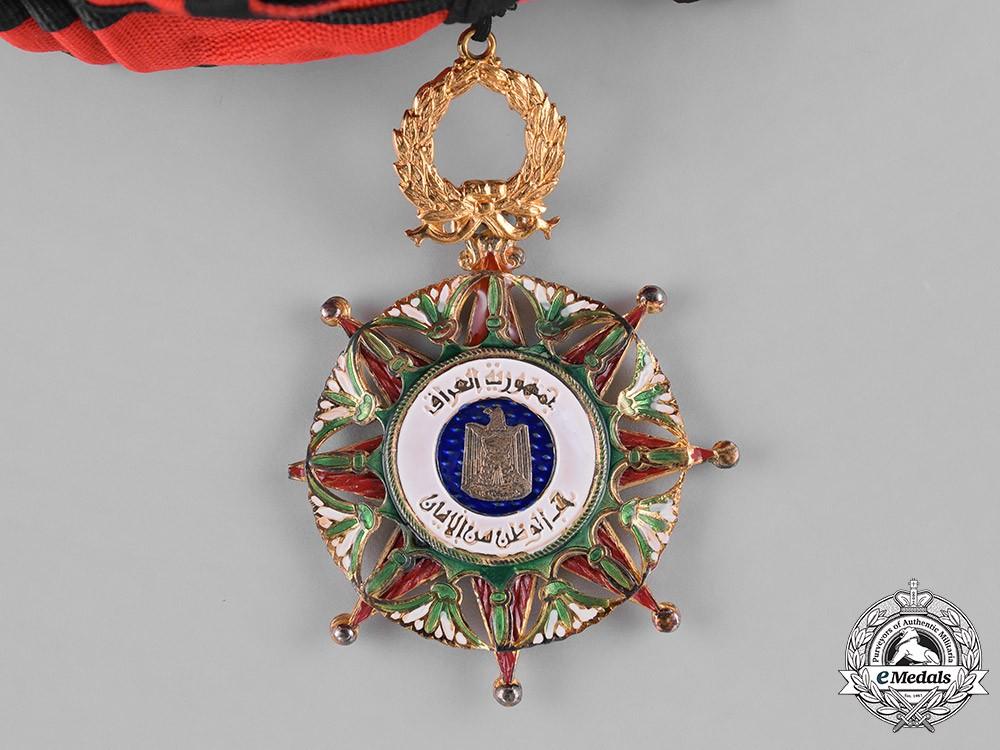 Sash badge, detail of obverse
Sash badge, detail of obverse
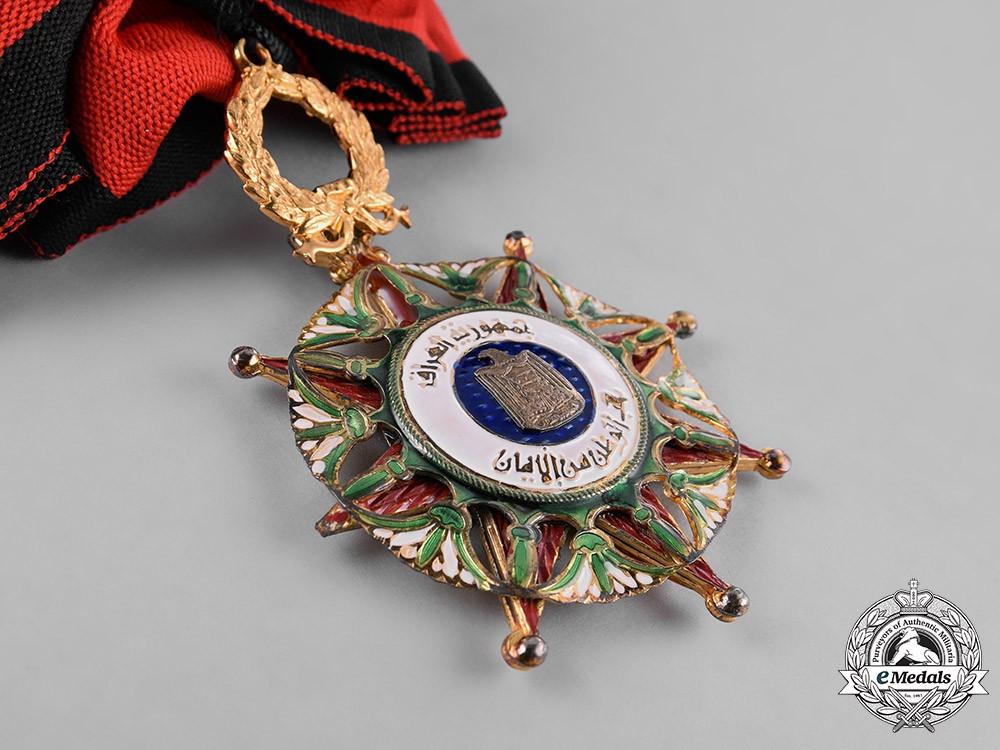 Sash badge, oblique detail of obverse
Sash badge, oblique detail of obverse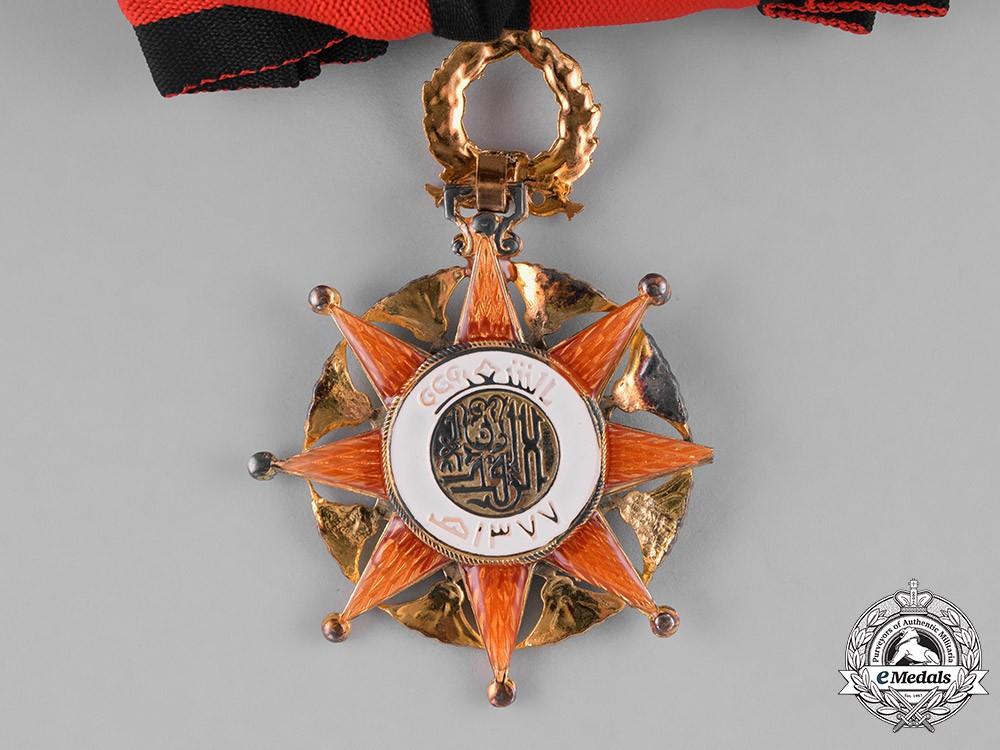 sash badge, detail of reverse
sash badge, detail of reverse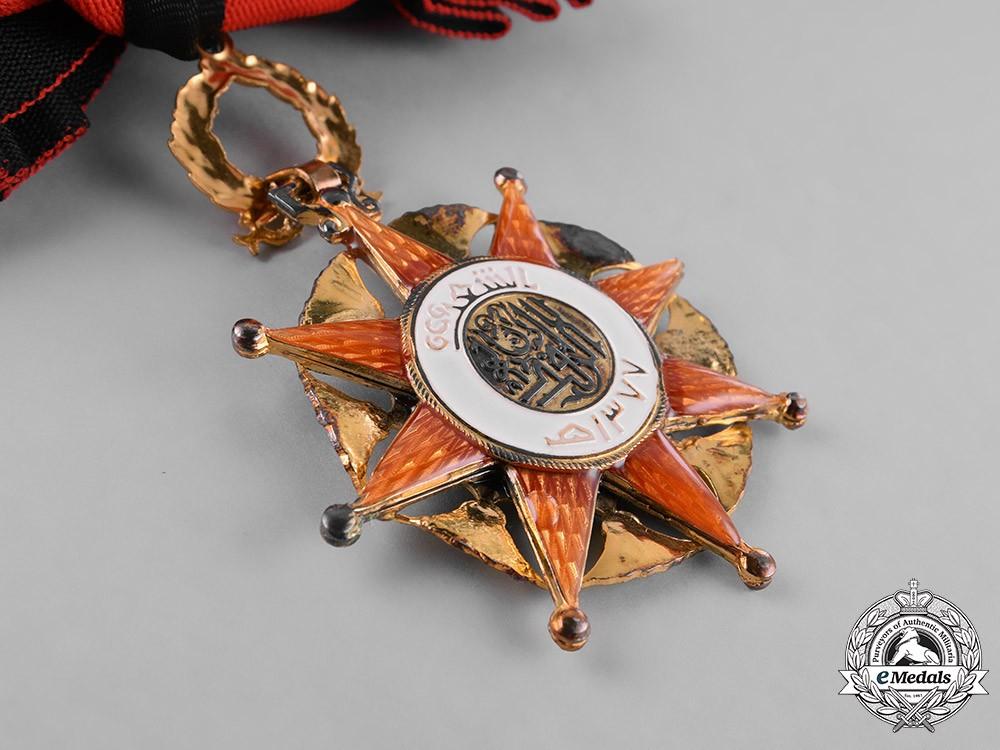 Sash badge, oblique detail of reverse
Sash badge, oblique detail of reverse Chest star
Chest star
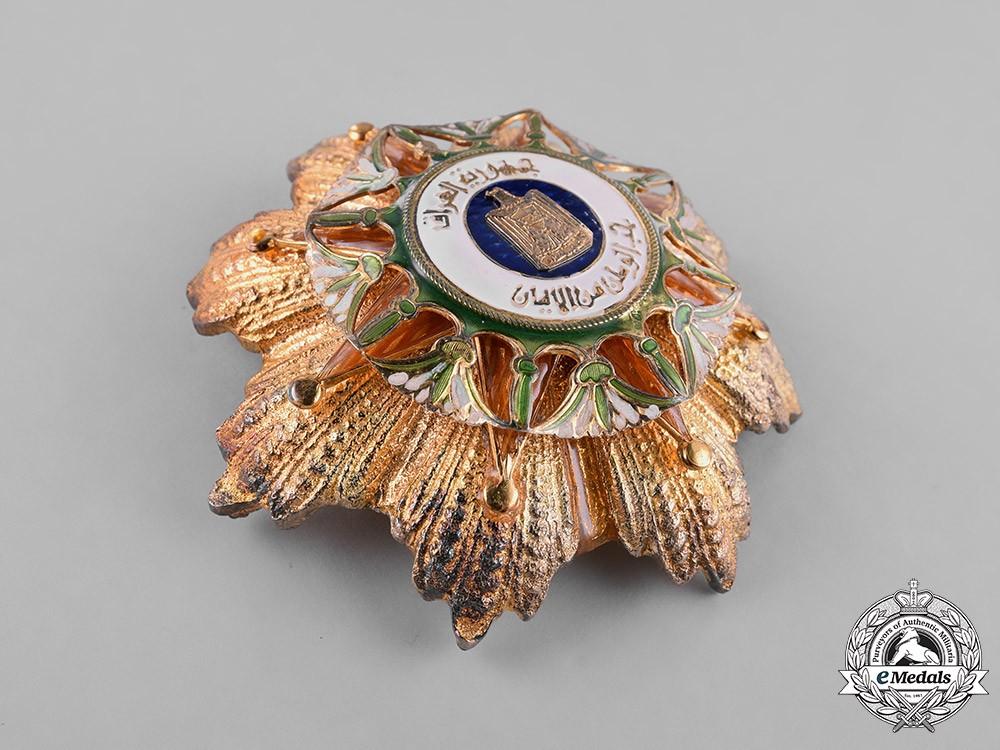 chest star, oblique view
chest star, oblique view
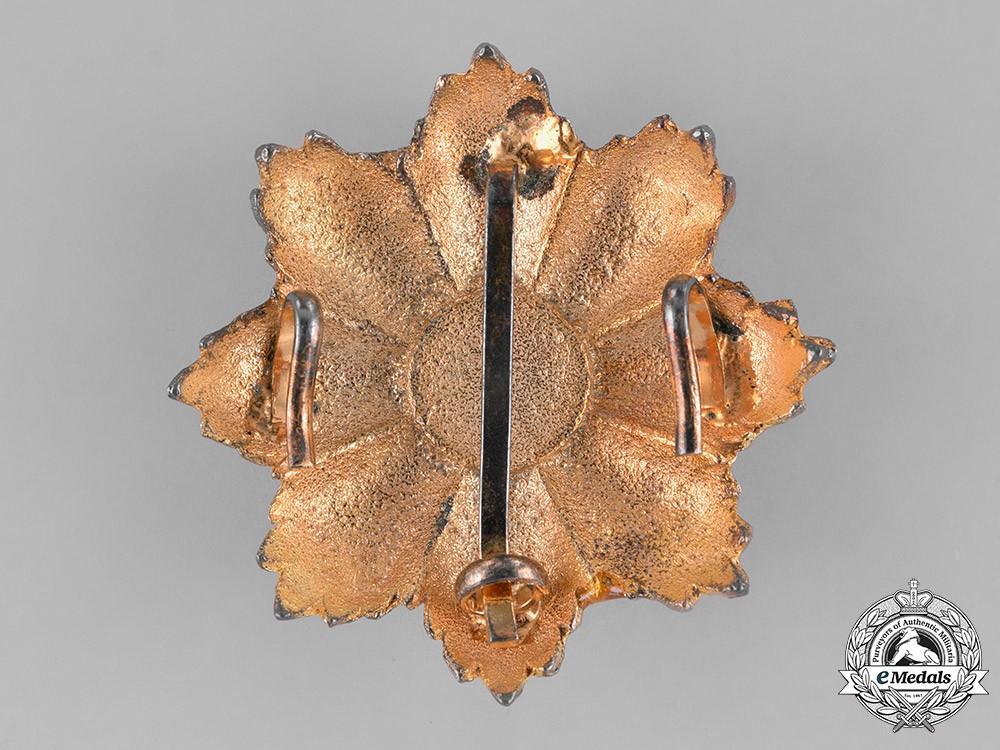 Chest star reverse
Chest star reverse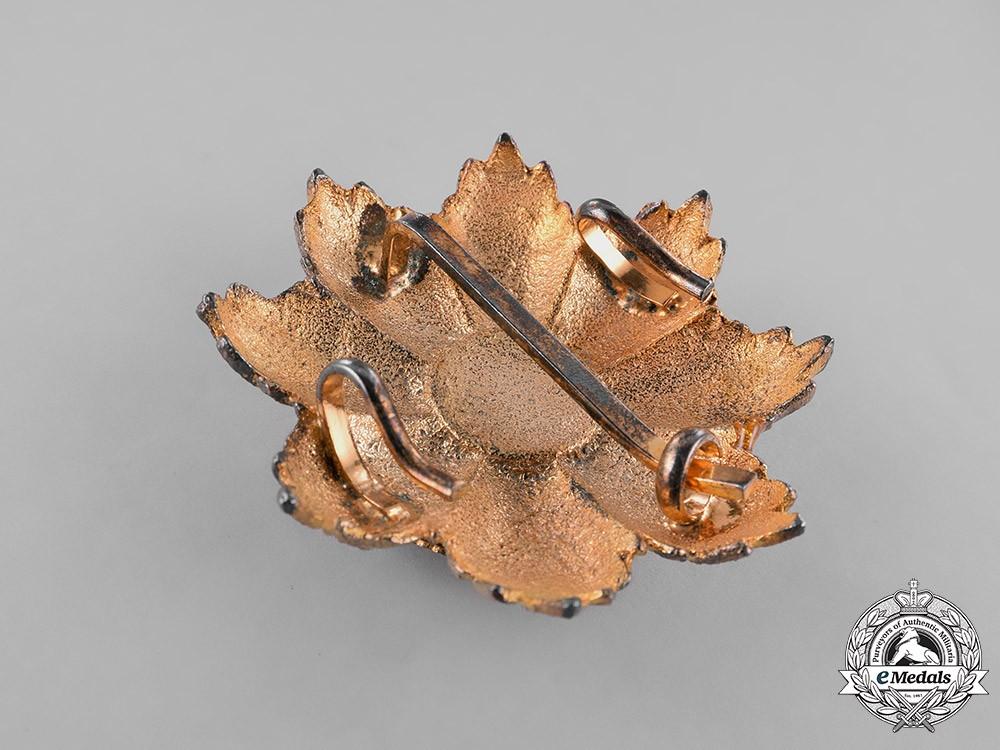 Chest star reverse, oblique view
Chest star reverse, oblique view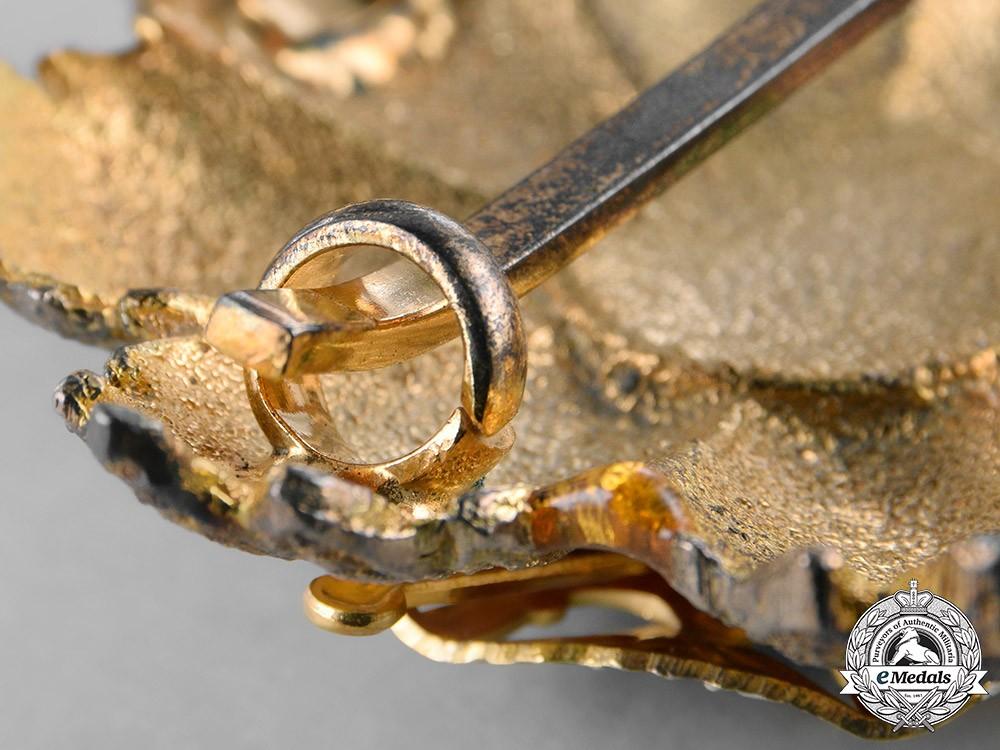 Chest star, detail of pin catch on reverse
Chest star, detail of pin catch on reverse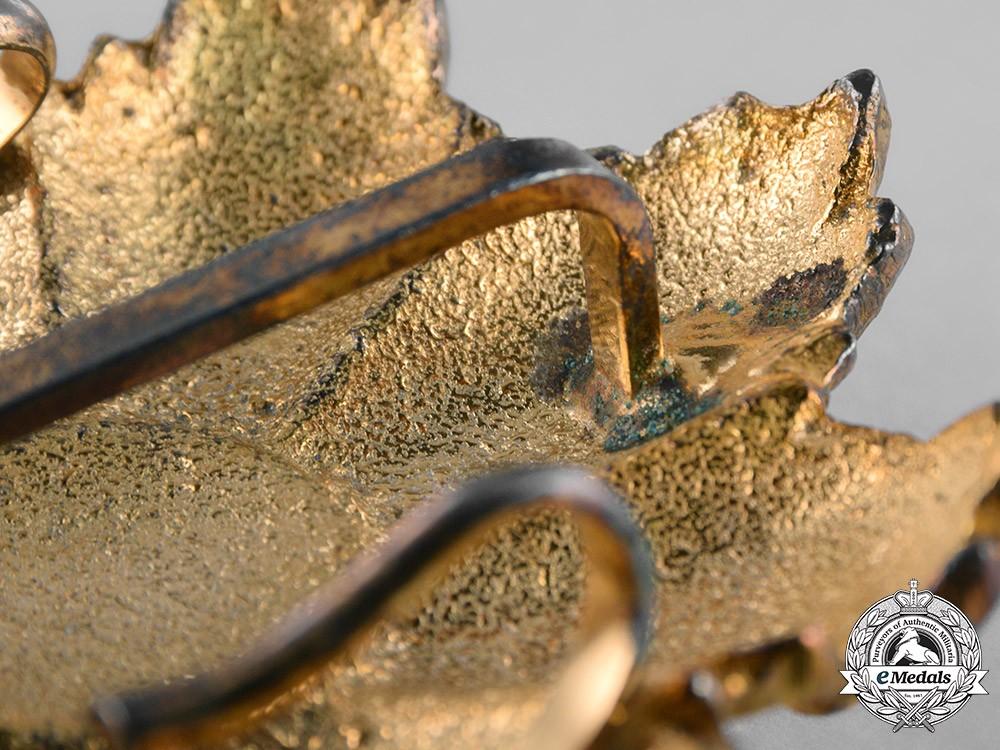 Chest star, detail of pin attachment
Chest star, detail of pin attachment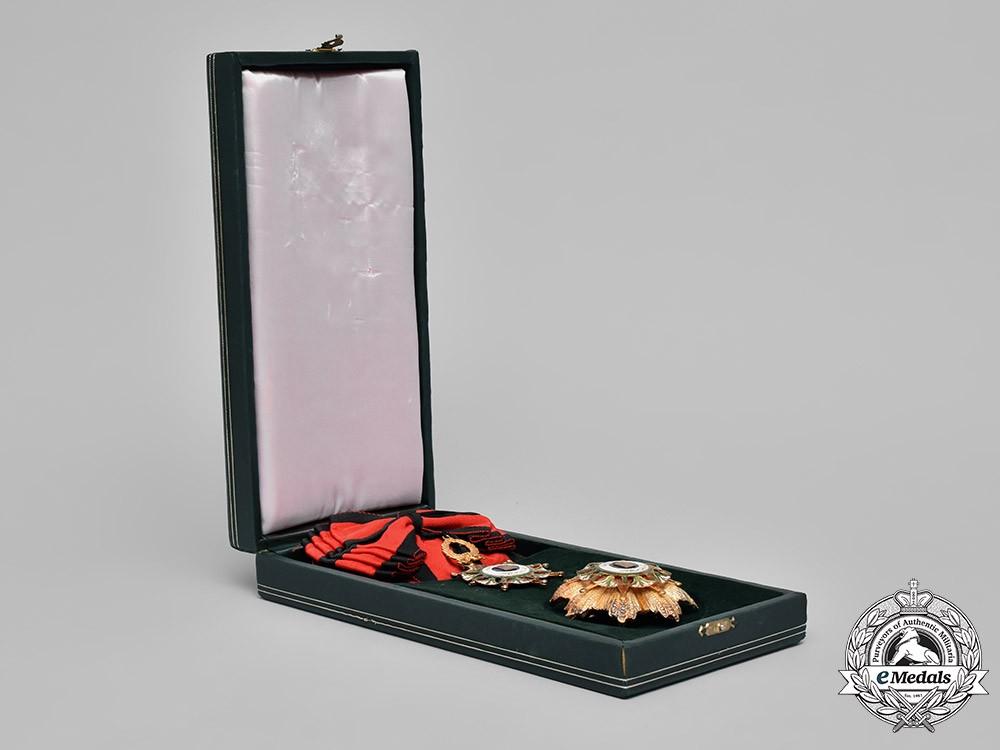 Set in case0
Set in case0 -
Ulsterman, thanks for your continued visitation of this thread. Several folks on Pinterest with interest in law-enforcement badges borrow images of the first US Dept. of State badge, but they inevitably all choose the ~1989 restrike image with the enamel and less well-exectued engraving rather than the photo of the actual rare original 1917 badge. GMIC is a much more satisfying forum dedicated to accurate information, background data, and not just "pretty" pictures.
The Dept. of State Special Agents originated in the early WWI period with government concerns about abuse of the US neutrality by visiting diplomats, especially Germans. The war created significant new security problems not experienced by the US Government previously, and these became even more complex in the aftermath of WWI as the US emerged from a relatively isolated nation to a world power.
In the early phase of WWI, the US was subjected to an array of espionage events that violated the tenants of diplomatic immunity and placed US neutrality in danger. These included abuses on US soil as well as the treatment of US (and other countries') diplomats oversees. Violence against the British embassy in Berlin, attacks on trains carrying diplomats, and rampant interception of diplomatic communications often confused Americans with the British, although the German government tried to get the populace to distinguish neutral Americans from the British who were at war with Germany. Interestingly, this may be where the wearing of US flags on diplomats lapels originated, as Americans tried to distinguish themselves from the British. The security of diplomatic pouches was a critical issue, and the US Postal service implemented a number of security measures that made them leaders in counter-espionage as it was experienced in relation to communications. This is one of the reasons that the first US Dept. of State Special Agent, Joseph "Bill" Nye selected postal inspectors as his initial Special Agents for the Washington and New York offices. The German Embassy in Washington ran a number of espionage, propaganda, and sabotage efforts (i.e., the realized plot that resulted in a 1915 attack on 10 US factories that produced munitions for Allied countries), in defiance of US neutrality. Passport fraud also was a major problem. Prior to 1914, passports were not required for travel in most parts of Europe, however this changed and new restrictions were implemented for the issuance of US passports. Despite these efforts, abuse of the passport system was rife. The German espionage & sabotage efforts were overwhelming challenges to the US government that lacked effective experience for these challenges.
Robert Lansing, the US Secretary of State, was responsible for realizing and acting to try and combat these threats to US neutrality and sovereignty. He instituted a strict pass system and escort protocol for foreigners and US citizens (including Congressmen and reporters) visiting the Dept. of State. He created a "secret service" to meet these challenges, and moved to coordinate the various agencies trying to implement better security against concerted espionage. President Wilson was reluctant to authorize Lansing's proposed overseeing agency, and he created the "Secret Intelligence Bureau" in April 1916, under the direction of Leland Harrison from the Latin American Division. Harrison coordinated collection of intelligence form various US govt and military agencies (although it was recognized this work was "extra-legal"), and had regular contact with comparable British agencies. Surveillance of the German Embassy in Washington and the German Consulate in NewYork uncovered a number of German plots. Joseph M. Nye, a Secret Service squad leader, was one of the investigators who provided significant wire-tap information from the German Embassy, specifically in relation to the German intentions to continue unrestricted submarine warfare, one of the actions that led to US involvement in WWI. Nye was assigned as the Special Assistant to the Secretary in 1917, and subsequently Lansing made him the Dept. of State's first Special Agent.
Most of the first year of Nye's work was escorting foreign dignitaries, protecting them, and making all travel arrangements for them during their visits to the US. The first 3 new Special Agents he recruited were froth Postal Office Inspectors; James O'Connell, Robert S. Sharp, and Robert C. Bannerman. Postal Inspectors were widely trained in detecting fraud, theft, transportation of weapons, firearms, and other banned materials, identifying crimes affecting postal officials, and determining whether such activity was external or internal to the Postal Service. They had an array of investigative experiences and skills critical to this new of the Dept. of State Special Agents Division. As I've noted elsewhere, they opened offices in Washington and New York, with Sharp overseeing the New York office.
The Special Agents Division was created just as President Wilson was preparing to declare war on Germany & Austria-Hungary. Lansing and his agency focused on diplomatic security particularly in communications as their principal WWI security effort. They also provided security for US diplomats and foreign dignitaries. They surveilled various organizations whose wartime activities were considered "disloyal", and because of the perceived threat to Great Britain by groups being funded by the Germans to overthrow British colonial rule, they targeted Irish revolutionaries and Hindu nationalists. Nye was involved in the case agains the Hindu nationalists. The Hindu group was only trying to incite rebellion against British rule (in other areas of Asia and in Africa as well), but the Irish group was being funded through German agents in Mexico that also plotted sabotage attacks in the US.
The post-WWI period resulted in even greater security and intelligence challenges as the US became an emergent world power, and target for more concerted espionage. The increase in the US diplomatic presence abroad resulted in even greater needs to maintain communications security, develop secure courier services, and counter-intelligence than during the war. Nye also continued the critical role of protecting foreign diplomats visiting the US. Special challenges included escorting Japanese royalty safely despite significant security threats, and, more delicately protecting diplomats from Liberia and other African countries while accommodating Jim Crow laws and explaining other racist conventions those diplomats were expected to practice with white officials and businessmen.
After WWI, security responsibilities increase, but budgetary and personnel cuts were implemented. Joseph "Bill" Nye resigned in 1920, going to work for Guaranty Trust Company to improve detection of fraud. Nye was replaced by Robert C. Bannerman. Robert Sharp lost his commission as head of the New York office in 1920 following personnel cuts reducing the Special Agents Division from 10 to 2 Agents. However, the increased responsibilities of the Special Agents Division resulted in re-hiring several of those individuals in 1921 including Sharp, again overseeing the New York Office now with a staff of 25 people. The renewed duties included internal investigations of leaks of sensitive information, theft, background investigations of potential Dept of State employees, illicit importation of liquor by the British Embassy, and passport & visa fraud that became an important tool in deporting foreign agents involved in espionage during the 1920s and 30s.
1916- Robert Lansing, 42nd US Secretary of State (1915-1920) under President Woodrow Wilson
(US Library of Congress Prints and Photographs Division; Harris & Ewing Collection; File: Robert Lansing; digital ID: cph.3b47713.jpg; Created: 31 December 1918)
1917-Joseph “Bill” Nye, The Department of State’s first chief special agent, served from 1917 to 1920.
Library of Congress. "1917: The first Chief Special Agent of the U.S. Department of State, Joseph M. Nye, was appointed by U.S. Secretary of State Robert Lansing in 1917 and served until 1920. His principal duty initially was to monitor enemy diplomatic activities in Washington and to protect foreign dignitaries visiting the United States, during the period of the First World War." (Source: Library of Congress; direct quote from: https://www.state.gov/m/ds/rls/c31108.htm) http://www.afsa.org/ds-100-tradition-vigilance
Joseph Nye's US Dept, of State Special Agents Division credentials, cancelled in 1920 when he left the Dept. of State.
https://www.flickr.com/photos/usdiplomacycenter/25569676257/in/photostream/
https://diplomacy.state.gov/archives/438#gallery[photonic-flickr-set-1]/25569676257/
Cover of Joseph Nye's US Dept, of State Special Agents Division credentials
https://www.flickr.com/photos/usdiplomacycenter/38630527820/in/photostream/
https://diplomacy.state.gov/archives/438#gallery[photonic-flickr-set-1]/38630527820/
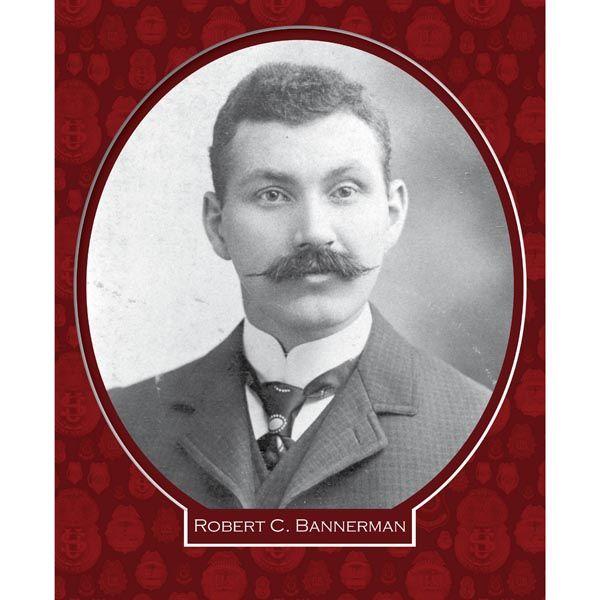
"1920: Robert C. Bannerman replaced Joseph M. Nye as Chief Special Agent in 1920 and served in that position until his death in 1940. He expanded the tasks of the office to include personnel background investigations, passport fraud, courier oversight, and internal investigations. His son Robert L. Bannerman was appointed head of the Department's Security Office in 1945." (Source: DS Records /1920) https://www.state.gov/documents/organization/176705.pdf
0 -
Welcome Lmaas1 and thanks for posting more images of bows & arrows! Sorry for my delay in collecting my thoughts about your arrows-but I'll let fly with my ignorance and conjecture...
I agree with Peter the the bow is certainly unassociated with the arrows, and for the same reasons. The laminate construction and grip's configuration marks it as a "recent" European bow. The arrows you illustrate would have been associated with a traditional "self" bow, as Peter notes the stave would have made from a single piece of wood lacking the laminate construction. Some older European-style bows were tillered to have the form of the grip in the image, but again carved from a single piece of wood. The well-known Sudbury bow from 1660 (in the Peabody Museum of Archaeology and Ethnology at Harvard) is the earliest example of a North American Native American self bow (possibly Wampanoag) and does show a thicker grip region, but not comparable to the modern bow in your photos. The arrows you illustrate would have been used with a very different form of bow, depending where they actually do come from, and that is not clear to me. If they are from South America, they would have been used with a palmwood bow similar to that shown in Stuka f's photos and those I illustrated in the thread that you found in his section.
The arrows are certainly ethnographic, but the region they come from is a bit problematic. 40 inches is quite short for most South American arrows (most are at least twice this length up to ~2 m long), although boy's arrows will be smaller than those used by adult men. Some groups did make arrows that were sold to outsiders, often they were shortened because of the demand for arrows that were easier to transport back to he visitors' homes (having returned hundreds of South American Native arrows back to the US, it is a complex task to bring long arrows any great distance). The length is also too long for most North American arrows. The point forms of the lanceolate steel-tipped arrows with central mid ribs is very uncommon among South American (even more so for North American) arrows, normally S. American lanceolate points are flat because they were made from scrap pieces of worn out machetes or knives, often retaining the casting elements of those blades. The mid-ribbed lanceolate points suggests manufacture on an a grooved anvil, or casting, practices more common in east Africa where dedicated village metallurgy served a variety of local technological needs. In most other parts of the world, steel has been obtained principally through recycling of worn-out tools, trade in raw materials (usually already manufactured steel points or worn-out tools), or from scavenging scrap from household dumps of the wealthy (often foreigners or non-indigenous local residents). Such blades with mid-ribs are best known for hand-held spears from Africa (fewer arrowhead forms have a mid-rib), that would have wooden hafts and no fletching (feathers at the proximal end to stabilize flight). If these are New World arrows, they would likely be from an area where sufficient trade between outsiders & Native folks occurred that the European-descendant folks would have manufactured such mid-ribbed points, specifically for trade with indigenous peoples (some parts of Brazil?). The elaborate, multi-barbed points appear to be made by heating and cutting the barbs (using an axehead, machete, or other hard steel implement) and are quite time-consuming to manufacture. Interestingly, the 4 non-lanceolate arrow forms are all principally fishing arrows. In the third photo showing the point forms, the arrow on the left has the multi-pronged fishing head similar to a hand-held leister, and often these arrow forms are thrust into water in a manner similar to spears to catch fish (as you note it is fishing arrow). I cannot tell if this example has barbs, but such points are effective either unbarbed or with some barbs. Interestingly, this is the longest arrow in your group, and even though it is fletched, a hand-held use, in addition to occasionally being shot from a bow, is quite likely. The short barbs on the other 3 non-lanceolate arrows also indicates design for fishing. The arrow second from the left has a large distal barb and the shorter barbs on the proximal portion of the squared x-section of the steel point. Both of these elements are critical in holding a fish on the arrow until it can be retrieved. The other 2 arrows to the right of this one that appear square in x-section with small, cut barbs that keep fish from slipping off the arrow point.
Interestingly, none of these arrows show a long foreshaft, a piece of hardwood that the point is seated into and then pushed into the mainshaft (usually with a resin or glue). The advantage of foreshafts is that the hardwood holds the point securely, even if the arrow is damaged in flight or by the animal once struck. They also often are pre-made, with a point seated in a foreshaft, for field repairs should the original distal armature of the arrow break in use. Except for the leister, all of the other arrows may have very short foreshafts, it is quite uncommon to seat a point directly into the lighter weight arrow mainshaftt because the shock will damage the distal mainshaft. Most South American arrows have long and quite visible fore shafts of dark red or brown hardwoods. This also is true for most Asian arrows where we have good descriptive e & illustrative literature (especially Papua New Guinea and the Philippines).
The mainshaft of the arrows (the long tan portion that looks like bamboo) is probably a cultivated arrowcane. Different species are used in different parts of the world. So until the probable location of origin for these points can be determined, it isn't possible to say from photos which it is, nor are photographs particularly useful in narrowing down the plant to help identify where they were made. South American arrows all use mainshafts, as do those made in other parts of the world. Some African hunter-gatherer groups (such as the pejoratively-termed "Bushmen" of Botswana, Namibia, & adjacent areas of southern Africa or Congo Basin "Pygmies") have common arrow forms that lack separate mainshafts & foreshafts, but principally on their small poisoned arrows. All of your arrows are fletched, although the feathers are missing from 2 of them. Fishing arrows often are used unfletched, the shooting distance is much shorter than for terrestrial game. Sometimes the mainshafts retain fletching because all elements of arrows are repaired and re-used, and often different points are put into arrows that formerly held a different style of point. The fletching is tangential, where whole segments of feathers are laid along the length of the mainshaft (modern target arrows use radial fletching, where the feather is split through the vein and each half of the feather is attached to form a raised "fin", modern competition arrows use radial fletching and now employ very low profile fletching [micro-fletching] that stabilizes the arrow better than larger amounts of fletching that just create additional drag). This is the simplest and fastest manufacturing method of attaching feathers. Your arrows' fletching feathers are bound at the ends, again a less time-consuming method than other techniques that bind the feather tighter to the mainshaft. While tangential fletching does not produce the most ideal flight characteristics (as radial fletching does), most traditional arrows are not designed for long distance flight. In hunting terrestrial game, most indigenous bows & arrows (for that matter atlatls [throwing sticks & long darts used among Australian Aborigines, Eskimo people, Maya & Nahua populations in Mexico, and widespread prehistorically before the invention of the bow], blowguns, and throwing sticks) are never used for distances greater than ~30 m, and that is a wildly risky outside shot. Fishing arrows are normally used for distances no greater than ~2 m, but the skill to compensate for refraction through water is a considerable feat. The windings of the fletching appear to represent at least a couple different materials. In your 5th photo showing the proximal ends of all the arrows, the 5th from the left (a lanceolate arrow missing its fletching) looks like a form of vine. The others may be a variety of different materials (commonly plant fibers, but possibly animal sinew, if they are not South American arrows). At least the 1st, 3rd, 4th, and maybe the 6th from the left show traces of some kind of resin attached to the bindings (this can be beeswax based or made from other tree resins, all of these usually combine at least a couple varieties of other materials as well). All of the proximal ends appear to have nocks (a groove in the mainshaft to fit the bowstring on), that you note are carved in the mainshaftt. Take an additional look, if you have not already, to see if all are just in the mainshaft cane or possibly inserted hardwood plugs. The particular form of the nock (carved or just worn from use in the mainshaft versus a carved plug inserted in the proximal end of the mainshaft) can be important in helping to narrow the geographic origin of arrows. All except the 5th arrow have windings at this proximal end that is designed as a reinforcement to prevent the mainshaft from splitting (the 5th shows traces of resin from previous windings). The 6th arrow appears to have vine as the initial winding of this nock reinforcement, and it may be covered with the use of a different plant fiber, but it is hard to tell from the photo. These windings show evidence of the use of resin to help the nock windings adhere, and possible to completely cover them with resin as well. The fletching is usually the portion of the arrow that suffers most from transportation, drying out in less-humid climates, and the depredations of insects, so it is common that the fletching is not in pristine condition.
The feathers used in the fletching are not necessarily diagnostic elements. Large feathers are common on South American arrows, but not necessarily useful as defining origin there. Several in your group look like members of the hawk family, and those are used in many parts on the Americas, similar-looking feathers are employed in other parts of the world as well. The black fletching on the one lanceolate arrow is consistent with some feathers used in South America. Many Asian groups do not use any fletching (especially some New Guinea groups).
The decorative carving on the proximal end of the mainshaft, distal to the point and the aluminum sleeve (likely an add-on, possibly by a past owner as heavy lanceolate points can become loose if the the windings dry out, become damaged, or if there is damage to that part of the mainshaft), is not distinctive enough to unambiguously identify the origin of these arrows. There is a possibility that these arrows are not all from the same group of people. I am very confident these are not North American arrows. They do not strike me as obviously identifiable with a particular South American region or group of people, although there may be areas with the lanceolate points that exhibit mid-ribs that I am not able to research here in my study. The shortness of the foreshafts (or possible lack of any on some arrows?) and the overall shortness of the mainshafts is anomalous among most South American arrows, again unless these were intended for trade with tourists. The point forms lack some of the complex styles ("exuberant" is the term used by one researcher working with Agta foragers of the Philippines) used in Asia and New Guinea. South America is still a likely source for these arrows, but the oddities suggest a population in fairly consistent contact with outsiders. The short length is not uncommon among groups who trade forms of their arrows to outsiders. Additionally, giving up large pieces of steel is not usually seen among populations with restricted access to metal, but might be more common if people were living in proximity to outside sources of metal (or pre-made points made specifically for trade with indigenous groups). The lack of any wooden arrows in this group also suggests a source among Natives living in proximity to sources of metal. The arrows in Stuka f's illustration are all wooden-pointed forms, and are likely no older (and possibly more recent) than yours, simply indicating they probably came from a more remote community. The dominance of fishing arrows does argue in favor of a South American origin. Most Indigenous folks are more willing to exchange these forms of arrows than the lanceolate types that have the more valuable large pieces of steel. It appears the lanceolate points in your collection may not be of the largest dimensions seen in South American (or other regions') arrows.
These arrows are not old. The lack of any wooden points at all in your assemblage suggest more recent origin. They most likely date to the early mid-20th century when significantly more travel occurred into indigenous areas, and this is true in many parts of South America where a range of individuals involved in oil exploration, exploitation of other forest products, assistance with development projects, or travel for fun were interested in obtaining Native crafts. Arrows are one of the most common items that visitors purchased or traded for, and South American Natives are much more willing to exchange arrows than almost any other technology (they are used in many groups quite commonly as a "currency" in trade relationships with other indigenous folks). Your source could very likely have been given these by another traveler without having gone to the location they are from, again as arrows are not that hard to obtain and someone returning would probably have more arrows than other kids of indigenous artifacts they got during their travels to give as gifts to family or friends. They also are not valuable, first because there is no clear provenience for them, and second arrows were such a common item to obtain in travel. I would urge you to be cautious in "refurbishing" your arrows. Inexpert "repairs" detract from the authenticity & any potential value of these items. I would suggest using small amounts of beeswax to stabilize some of the loose windings or re-attach the fletching. Beeswax is completely reversible and does not stain most plant materials. It is easy to work with if you pinch off small amounts and make it pliable from the heat in you fingers, pressing it onto the pieces you wish to hold down. Craft stores or fabric stores with diverse sewing materials will usually have small blocks of 100% beeswax. You may not want to completely stabilize all of the windings, you do want to be able to observe what the raw materials are for continued attempts at better identifying their provenience. The best way to display (or store) arrows is to support them in two places (one hook near the distal end to support the weight of the metal points) and hang them on the wall. This prevents additional warping, keeps them away from insects on the floor, allows you to monitor their condition, and the visual display on a wall grabs peoples attention much more than a group of arrows leaning against a wall in a corner. They don't have to be completely level to help prevent warping, a slight angle gives the illusion of flight and yet keeps them from becoming more damaged.
Sorry for such a long-winded diatribe without giving you what you really wanted to know. I'll continue to think about these arrows for a while and see if I can add any information useful to you. Welcome to GMIC & have fun with your arrows!
0 -
To follow up on a couple additional aspects of judges' costume, I want to illustrate a few images of post-termination of the Mixed Courts and pre-Republic period when all judicial duties were given to new National Courts that assumed the jurisdiction over cases involving foreigners as well as Egyptian citizens. These first photos show the use of non-official dress (perhaps only outside of he courtroom?) related the Egyptian judge I illustrated in the final photograph (6th image) on my post of 12, September 2018. I mentioned in that post that there were 2 additional eBay photos of this judge in traditional dress without his judge's sash and the crescent & stars emblems he wears in that image (included below for comparison). I am including the those photos I referenced here, below the one of the judge wearing his sash with crescent and star emblems. In both portraits, he wears a light-colored gallebaya without his judge's sash and emblems. I have no information about what court this judge may have served, and do not know if the use of traditional clothing suggests it is part of one of the Muslim or another division of National Courts that replaced the Mixed Court system.
Above is the Egyptian judge wearing a tri-colored sash (probably similar in color to that illustrated on 27 April, 2018 on this thread) with the crescent and multiple star emblems, previously posted here on 12 September, 2018, from a current eBay auction of an original 14 x 9 cm black & white print (https://www.ebay.com/itm/EGYPT-OLD-VINTAGE-PHOTOGRAPH-Judge-with-the-scarf/273147885787?hash=item3f98e1f8db:g:5lkAAOSw13ZayXDv:rk:33:pf:0). Unlike the other post-1949 judges I have found photos of, this individual wears more traditional Egyptian costume with the judicial regalia (sash with crescent & stars). Unlike all other photos I have seen, he wears a turban rather than a fez, along with a dark traditional tunic (gallebaya) that is unlike the coat of the Mixed Court era (see the 2 illustrations of the same Egyptian judge in Appeals Court regalia posted on this thread on 27 October, 2017) or the western-style jackets more common among the 1949-1953 as shown in several posts here on this thread (see 3rd photo on the post of 27 April 2018; the 4th &5th images posted on 12 September, 2018; and the 3rd & 4th photos posted on 31 October, 2018).
The same judge, identified as working in his office, wearing a turban, gallebaya, but no official judicial regalia. From a current eBay auction of an original 14 x 9 cm print (https://www.ebay.com/itm/EGYPT-OLD-VINTAGE-PHOTOGRAPH-Judge-in-his-office/273147887546?hash=item3f98e1ffba:g:k~oAAOSwlJlayXGK:rk:30:pf:0).
The same judge outdoors in turban, gallebaya, and without judicial regalia. From a current eBay auction of an original 14 x 9 cm photographic print (https://www.ebay.com/itm/EGYPT-OLD-VINTAGE-PHOTOGRAPH-Judge-standing-on-the-bridge/312105737674?hash=item48aaf39dca:g:OPsAAOSwH1VayXIX:rk:31:pf:0).
As a correction, the second photo I posted on 27 April, 2018 that was identified on the eBay site and an Egyptian Judge, appears to be wearing regalia that suggests the Egyptian or Libyan Parliament (I have included it below as well). He is not wearing judicial regalia. The man in the 27 April image is wearing a watered silk sash (with a darker border) with the crescent with 3 stars closely spaced within the arms of the crescent that is part of the sash emblem for members of the Egyptian Upper House of Parliament, and a lapel pin with 8 major rays. The Libyan regalia is similar in design to the of the Egyptian Upper House of Parliament, as noted by Owain on 18 May, 2016 on the thread "Libya - unknown order and medal" started by James Hoards on 15 May, 2016 here in the Middle East & Arab States section:
The visible lapel badge on my 27 April posting (and below) has 8 major rays, in contrast with the 6 rays of the Egyptian Upper House of Parliament badge (see eMedals image below). Additionally, the watered silk sash has a darker border that I have not seen for the Egyptian parliamentary sash. That photo is identified as coming from Egypt, although no studio is specified. Does anyone know if there were other variants of this regalia for Egyptian officials?
Photo I posted on 27 April of an alleged Egyptian judge, whose regalia may indicate he is a member of the Egyptian Parliament (or Libyan?). I am correcting my past illustration of this individual as a post-1949 pre 1953 judge because of the bordered sash, configuration of the crescent and 3 stars, and the lapel badge. This 14 x 9 cm original print is from a past eBay auction with the identification: "Egypt old vintage photo of judge with scarf". https://www.ebay.com/itm/EGYPT-OLD-VINTAGE-PHOTOGRAPH-Judge-with-the-scarf-/273105393192?nordt=true&orig_cvip=true&rt=nc&_trksid=p2047675.m43663.l44720
An identified Egyptian sash with crescent & star insignia, the sash badge, neck badge, and lapel badge for a member of the Egyptian Upper House of Parliament is shown below from an eMedals past auction listing https://www.emedals.com/africa/egypt/an-egyptian-upper-house-of-parliamentary-set-w1572). This shows that the neck and lapel badges have a configuration of 6 major rays in contrast with the 8-rayed lapel badge visible in the other images here. The sash of green watered silk also lacks the darker border shown in the image above and the the two photos
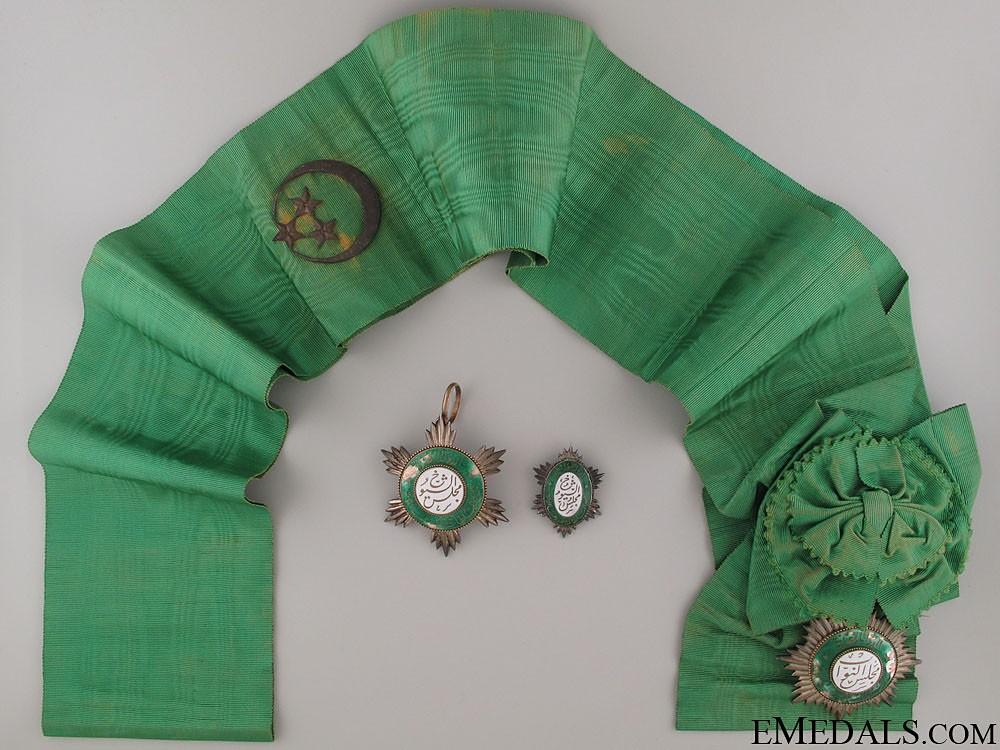
Below is a better photo of an individual wearing the same regalia seen in the 27 April, 2018 image I am correcting as not representing a judge, but the photo below shows all of the regalia that is partly covered in that 27 April image. This is from a current eBay auction (https://www.ebay.com/itm/Armenian-photographer-in-Egypt-member-of-the-Egyptian-Upper-House-of-Parliament/273500928337). The seller initially identified this man as an Egyptian judge, but I am currently unsure whether this represents a member of the Egyptian Upper House of Parliament or possibly a man wearing that for Libya, given the differences between the sash border and number of rays on the lapel badge compared with the eMedals example shown above. Both portraits (below and on 27 April) show an 8-rayed lapel badge. The sash badge attached to the decorative knot shown in the eMedals image above and the photograph below are 8-rayed . The photo below is identified as from Egypt, taken by an Armenian studio, K. Papazian in Cairo, and is an 18 x 13 cm original print.
Below is another individual in a photo from a current eBay auction (https://www.ebay.com/itm/EGYPT-OLD-VINTAGE-PHOTOGRAPH-Judge-With-a-medal-and-scarf/273500915471) identified as an Egyptian judge, but wearing regalia that suggests either an Egyptian or Libyan member of Parliament. What is visible of his sash shows a lighter border than that of the individual above or the man I initially illustrated on 27 April (but it is very difficult to determine color or hue in black & white photos). The sash does have the same crescent & 3-star emblem of Parliamentary regalia. The lapel pin shows 8 major rays. Unlike the individual above, this man wears a turban and gallibaya. This 22 x 15 cm original print is said to be from Egypt, but no studio is identified.
0 -
Below is an unusual image of another post-1949 & pre-revolution individual identified as a a judge. The hand-tinted, matted original studio print (23 x 18cm) has a bicolored sash (lighter colored stripe [green?] worn uppermost) with the crescent and 1 star in the superior position. What seems unusual to me is that this man is wearing a white uniform (rather than the more common western-style suit at this time period) and is identified as a police officer (at the same times his judicial appointment?). The eBay listing identifies the name Ali Arafa, of Port Said, but I do not know if this is the subject's name or the studio name. I am including close-ups of the inscriptions on each of the lower corners. (https://www.ebay.com/itm/EGYPT-VINTAGE-PHOTOGRAPH-POLICE-OFFICER-Judge-HAND-COLOR-ALI-ARAFA-PORT-SAID-/273502359767?_trksid=p2385738.m4383.l4275.c10)
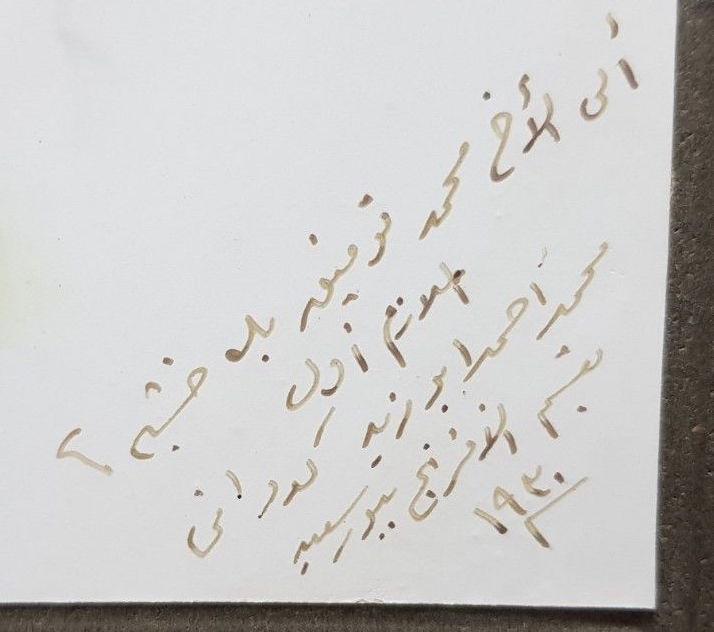
inscription on the lower R of the above photo.
inscription on the lower L of the above photo.
0




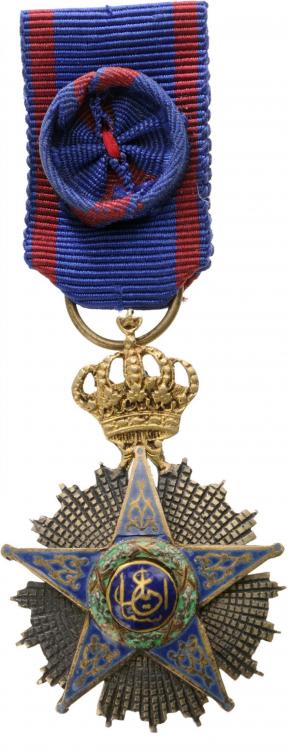

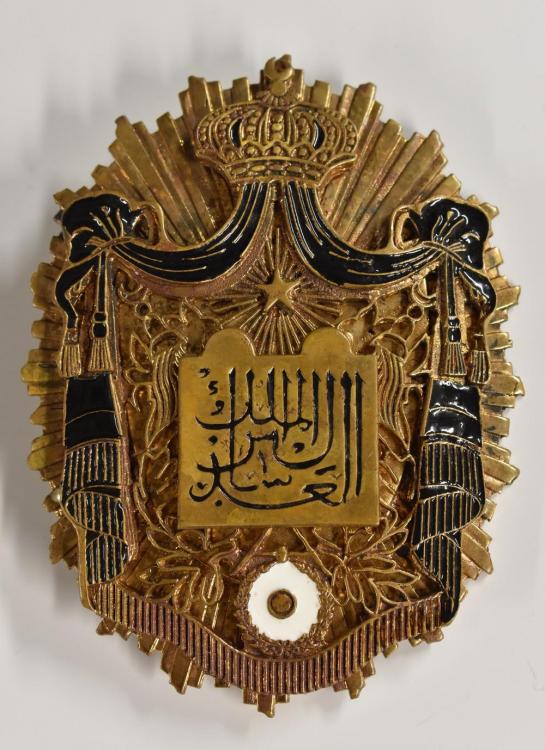
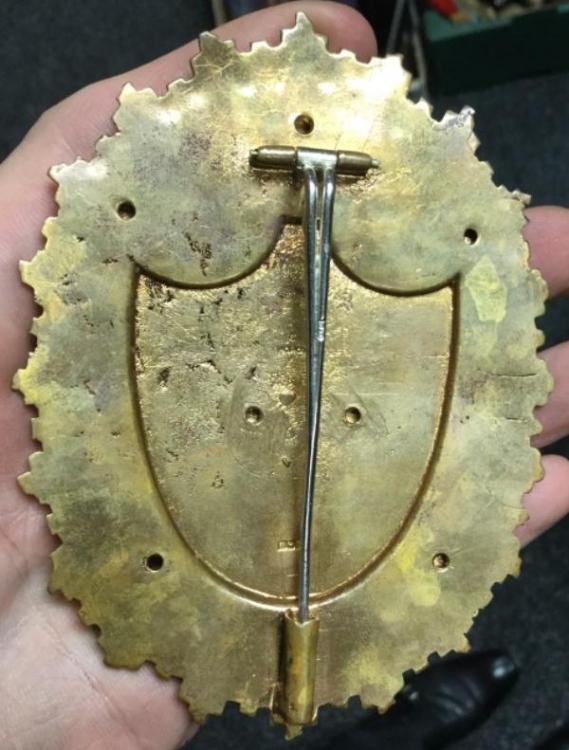



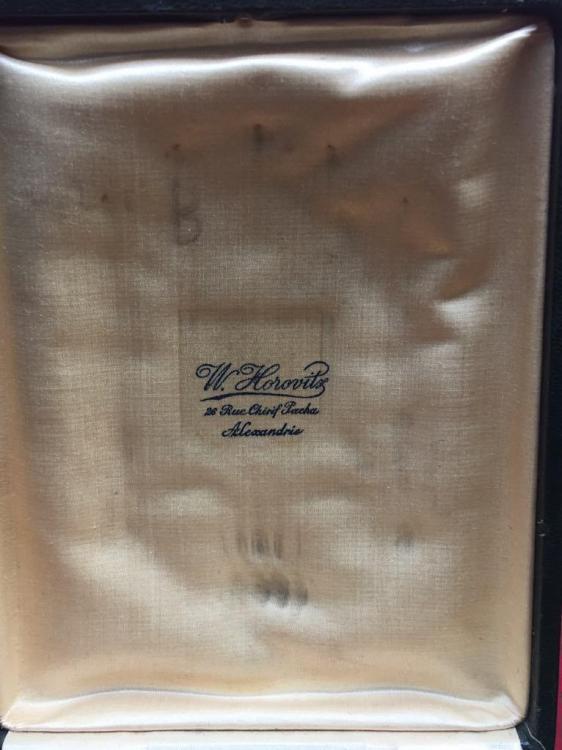

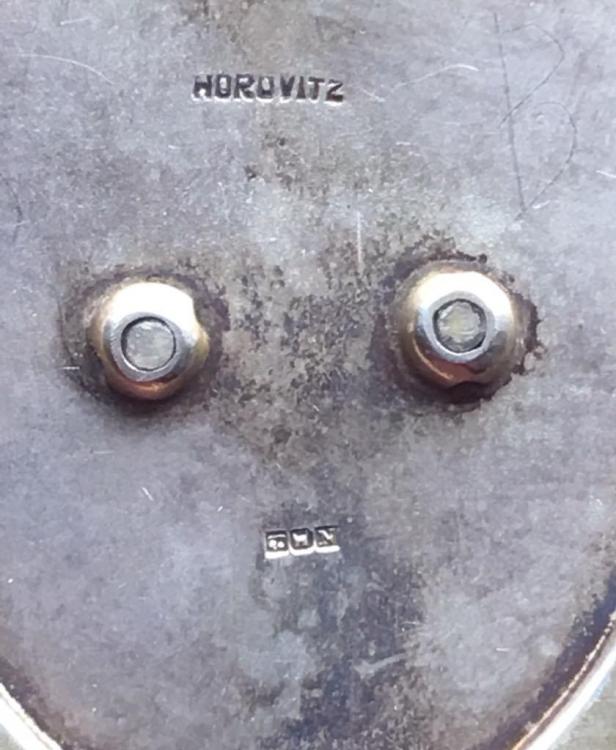
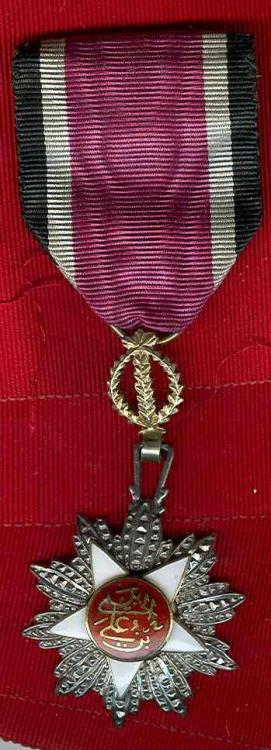
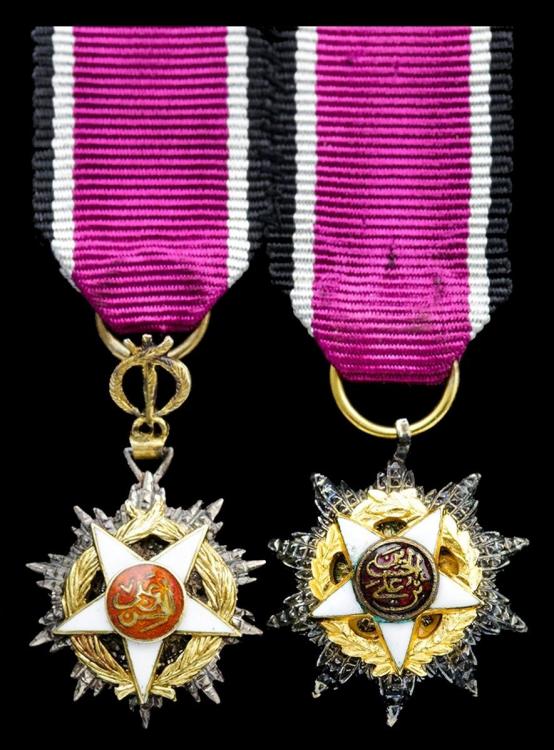
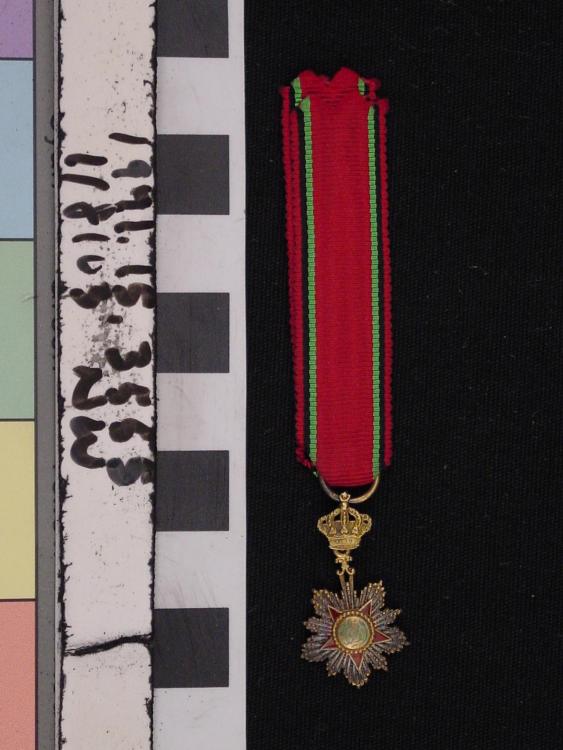
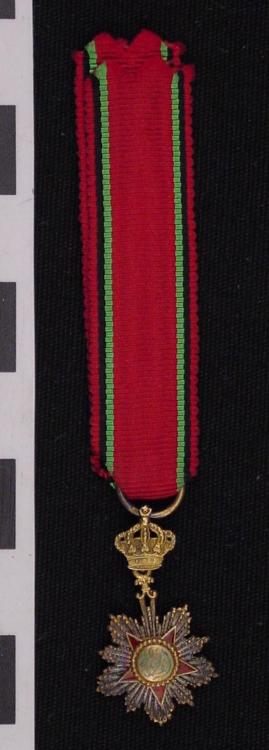
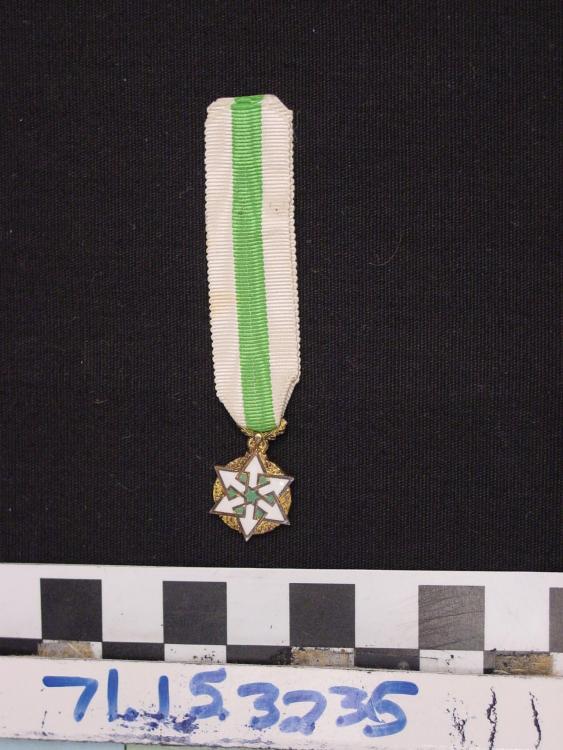
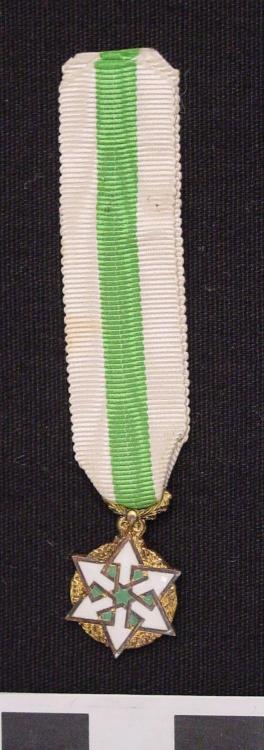
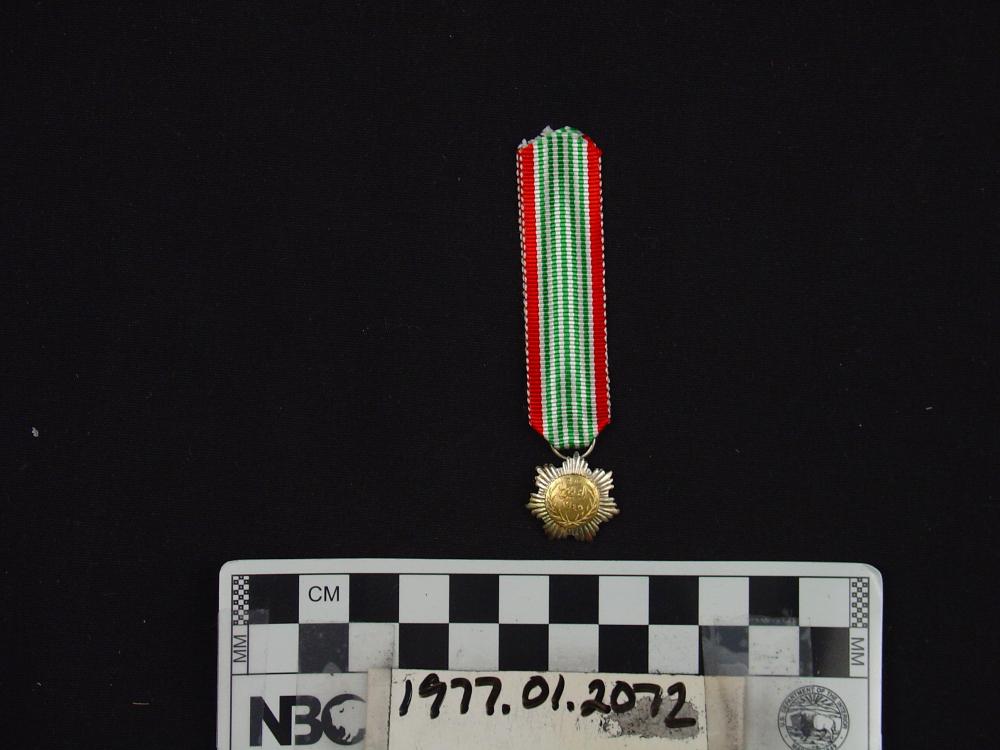
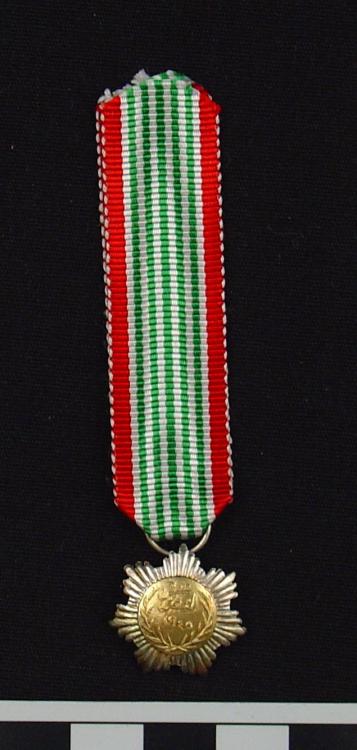
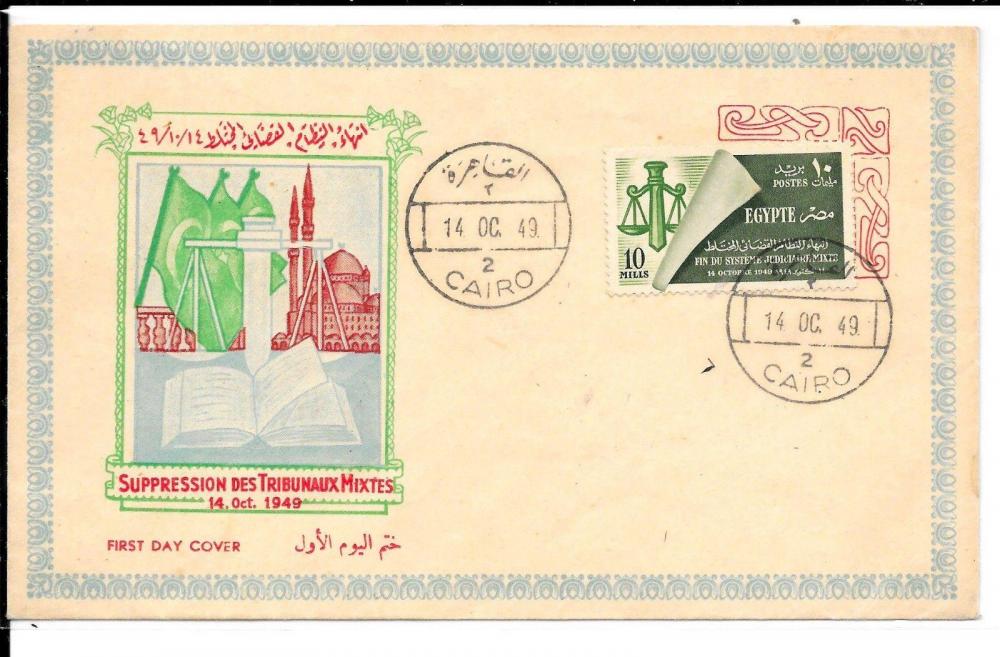


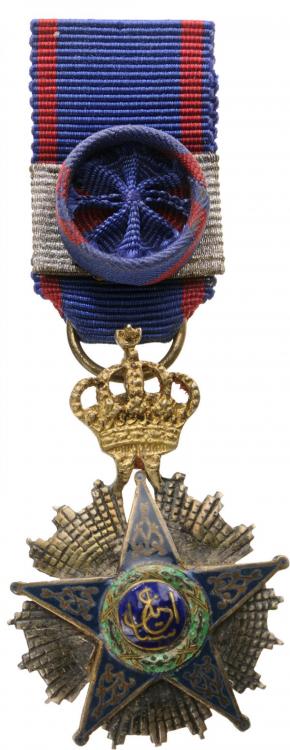
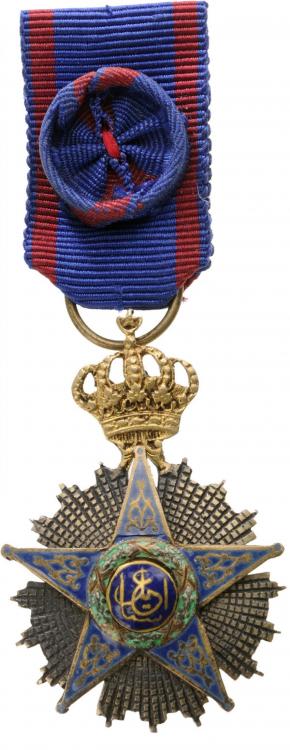

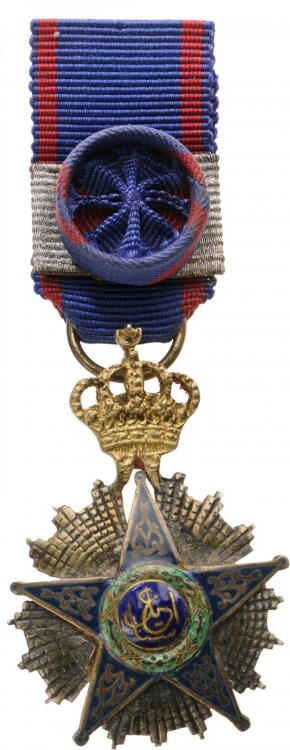
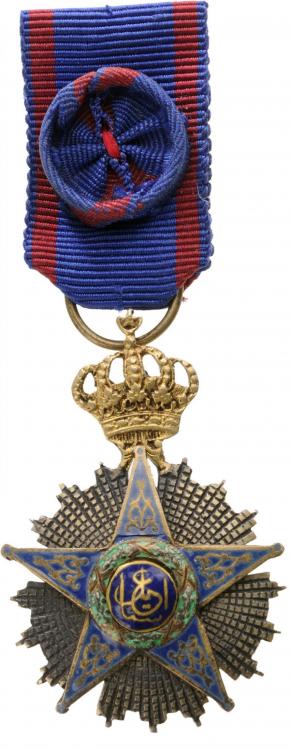
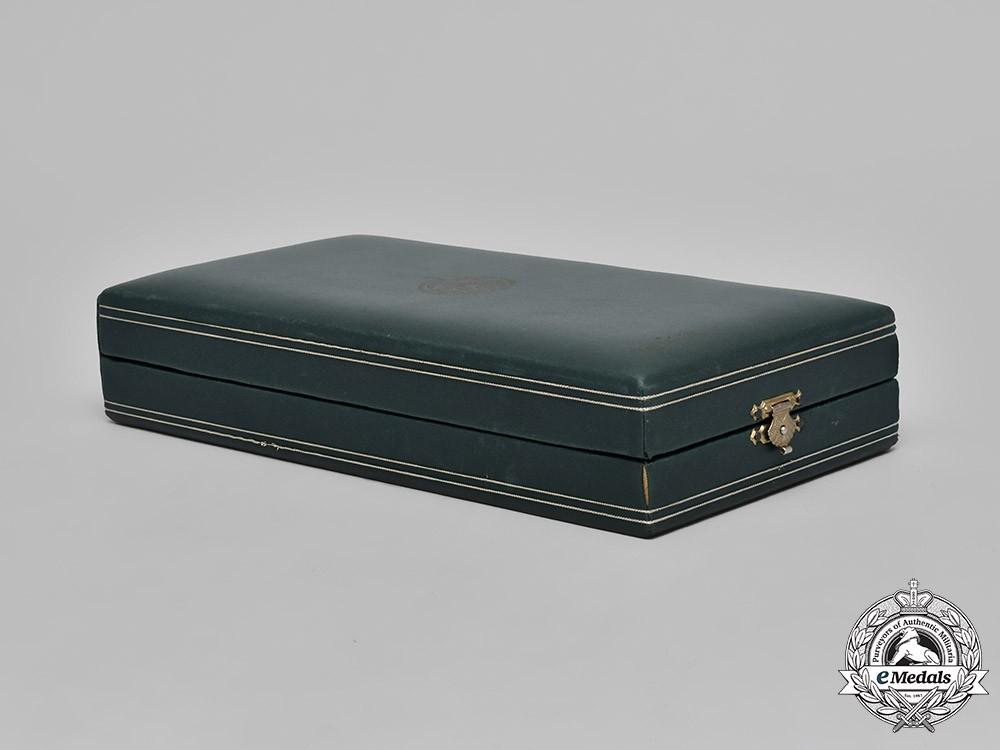

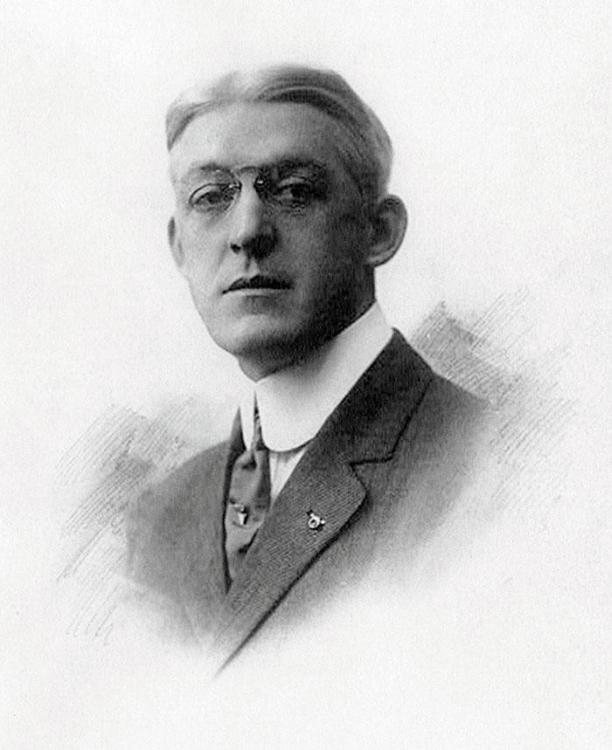
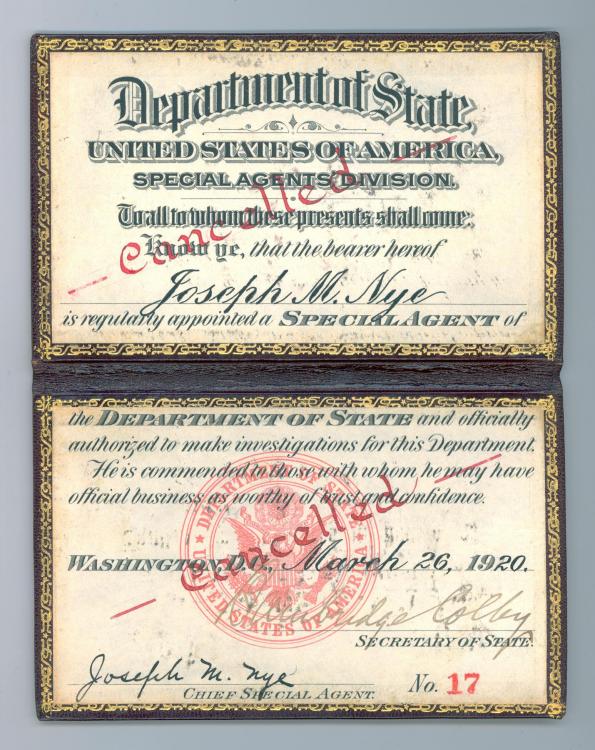
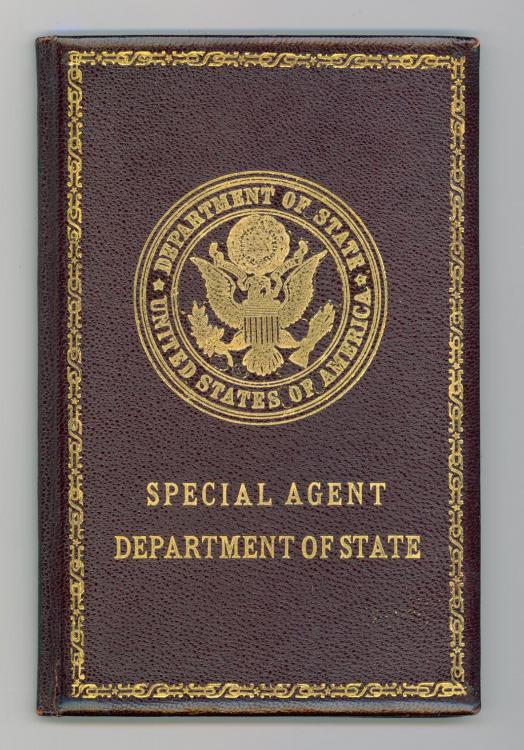
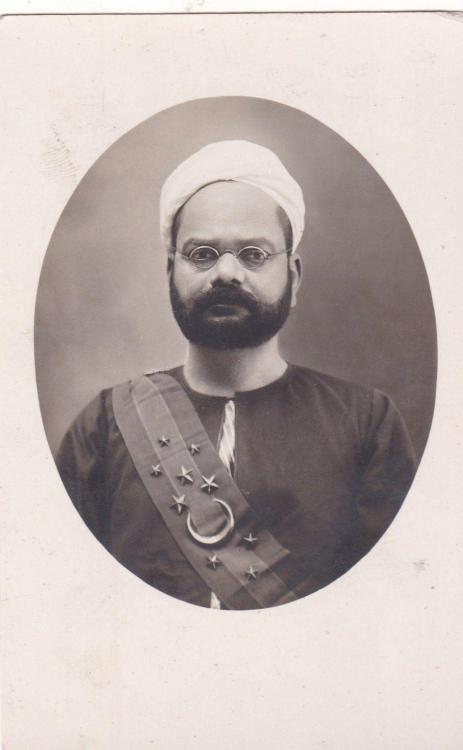


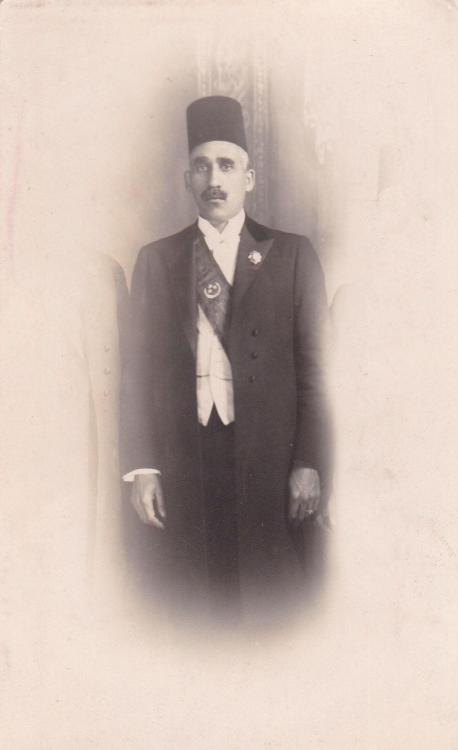
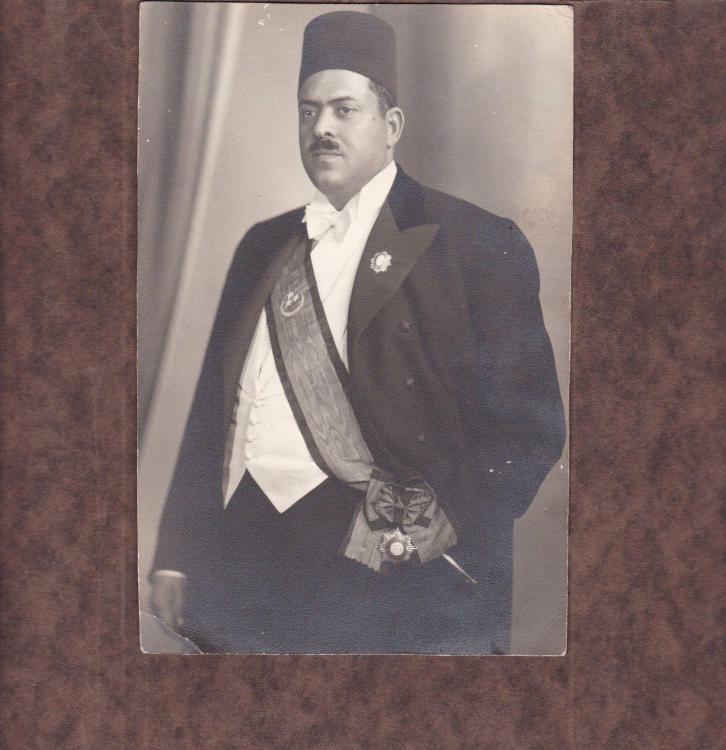
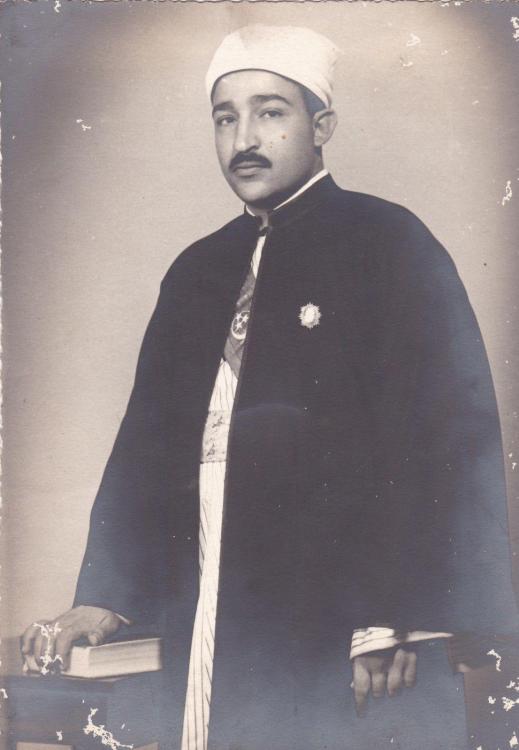
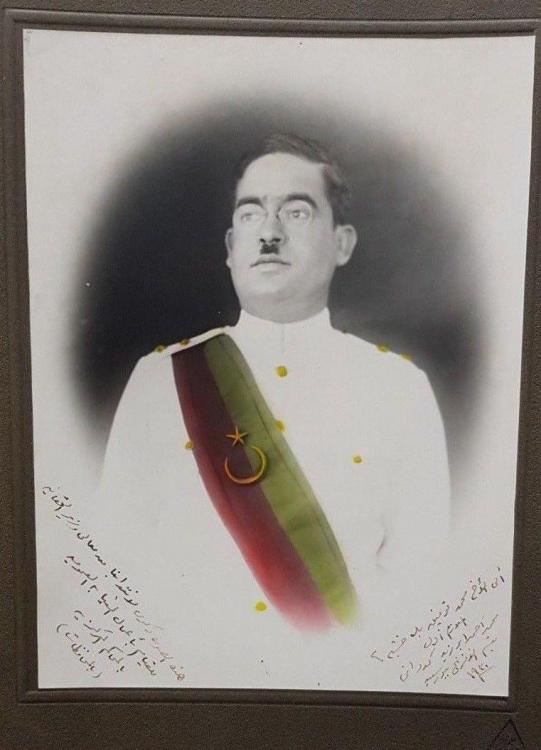
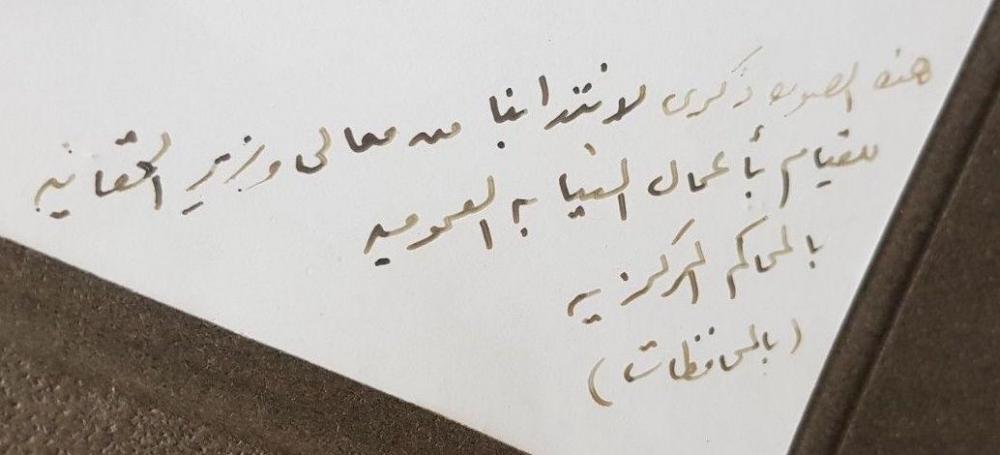
Miniatures of the Middle East & Arab World
in Middle East & Arab States
Posted · Edited by Rusty Greaves
I posted the following bar of miniatures on my thread "Question about the Order of Ismail" on November 10, 2018 and did not copy it here.
I am particulalrly interested in this image providing another example of the form of the miniature of the Order of Ismail with the chest star configuration, shown in this listing on acsearch.info from a 2016 auction by Auktionhaus H. R. Rauch (top set obverse of the Order of Ismail is shown on far R; reverse shown on top L far L; and the obverse of the Order of Ismail is on the bottom image in the case on the far R) along with 10 other miniatures on a chain. (https://www.acsearch.info/search.html?term=Egypt&category=4&en=1&de=1&fr=1&it=1&es=1&ot=1&images=1&thesaurus=1&order=0¤cy=usd&company=) The resolution of this illustrations is too poor for any meaningful detail of that Order of Ismail miniature medal or any of the others on that same chain, but is shown below simply as another example of this form of the Order of Ismail mini. The auction description (from a 2016 auction) includes the following: A Personal Group of 11 Miniatures on a Chain: France, Colonial Medal, Germany, Grand Cross ofMerit of the Order of the Republic, Morocco, Grand Cross of the Ouissam al-Aoui, Guatemala, Grand Cross of the Order of the Quetzal, Djibouti, Grand Cross of the Nichan el-Anouar, Cambodia, Grand Officer of the Royal Order of the Sahametrei, Egypt, Grand Officer of the Order of the Nile (Type II), Comoros, Commander of the Star of Comoros, Tunisia, Commander of the Nichan el-Iftikhar, Serbia, Officer of the Order of Saint Sava, Egypt, Officer of the Order of Ismail. Breast Badges, different sizes, Silver or Silver gilt, enameled, original suspension rings and ribbons, hanging from a Silver giltchain, hallmarked "crab", in a box of issue by "Arthus-Bertrand, Paris"
In the "Question about the Order of Ismail" thread where I originally posted this image, Owain posted the following comment about this miniature medal group on 13 December, 2018: "With regard to the Rauch set of miniatures illustrated in your previous post, probably to a French recipient, it would appear that one of the awards is an 'extra' either added by the recipient to his chain - rather than get a longer chain, or perhaps added much later. Has the Ismail been squeezed in? The fact that the chain includes an Egyptian Monarchy Order of Ismail and a Republic Order of the Nile is of interest - the latter was for recipients of the rank of Prime Minister of similar. the Ismail would chronologically been awarded first but it appears to be an 'extra' in this group although in seniority it may be the junior foreign award by rank or grade."
I posted the following brief question back to Owain on 11 January, 2019 (also on the "Question about the Order of Ismail" thread: "Your additional information and point about the mix of Monarchy and Republic era miniatures in the Rauch photograph is quite interesting. The Republic Order of the Nile is a 2nd Class of that Order (galon with gold on R and silver on L) while the Order of Ismail mini appears to be the 4th Class (rosette with no galon). Unfortunately, very few images of miniatures Order of Ismail I have run across show any galon to demonstrate common use on the minis. Would those differences in Class help explain the order of the the two Egyptian minis on this French bar?"